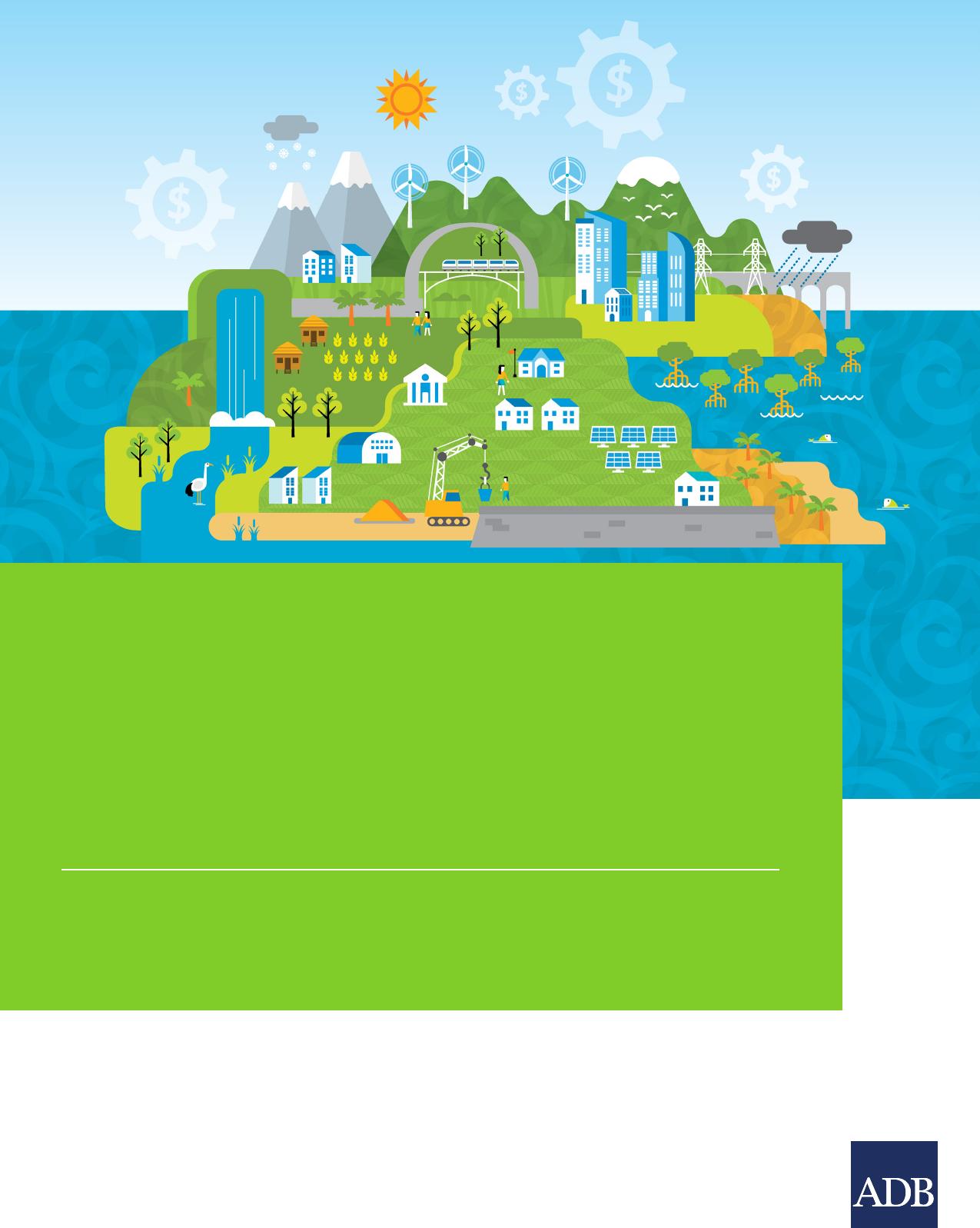CLIMATERESILIENTFISCALPLANNINGAREVIEWOFGLOBALGOODPRACTICESNOVEMBER2023ASIANDEVELOPMENTBANKCLIMATERESILIENTFISCALPLANNINGAREVIEWOFGLOBALGOODPRACTICESNOVEMBER2023ASIANDEVELOPMENTBANKCreativeCommonsAttribution3.0IGOlicense(CCBY3.0IGO)©2023AsianDevelopmentBank6ADBAvenue,MandaluyongCity,1550MetroManila,PhilippinesTel+63286324444;Fax+63286362444www.adb.orgSomerightsreserved.Publishedin2023.ISBN978-92-9270-475-9(print);978-92-9270-476-6(electronic);978-92-9270-477-3(ebook)PublicationStockNo.TCS230545-2DOI:http://dx.doi.org/10.22617/TCS230545-2TheviewsexpressedinthispublicationarethoseoftheauthorsanddonotnecessarilyreflecttheviewsandpoliciesoftheAsianDevelopmentBank(ADB)oritsBoardofGovernorsorthegovernmentstheyrepresent.ADBdoesnotguaranteetheaccuracyofthedataincludedinthispublicationandacceptsnoresponsibilityforanyconsequenceoftheiruse.ThementionofspecificcompaniesorproductsofmanufacturersdoesnotimplythattheyareendorsedorrecommendedbyADBinpreferencetoothersofasimilarnaturethatarenotmentioned.Bymakinganydesignationoforreferencetoaparticularterritoryorgeographicarea,orbyusingtheterm“country”inthispublication,ADBdoesnotintendtomakeanyjudgmentsastothelegalorotherstatusofanyterritoryorarea.ThispublicationisavailableundertheCreativeCommonsAttribution3.0IGOlicense(CCBY3.0IGO)https://creativecommons.org/licenses/by/3.0/igo/.Byusingthecontentofthispublication,youagreetobeboundbythetermsofthislicense.Forattribution,translations,adaptations,andpermissions,pleasereadtheprovisionsandtermsofuseathttps://www.adb.org/terms-use#openaccess.ThisCClicensedoesnotapplytonon-ADBcopyrightmaterialsinthispublication.Ifthematerialisattributedtoanothersource,pleasecontactthecopyrightownerorpublisherofthatsourceforpermissiontoreproduceit.ADBcannotbeheldliableforanyclaimsthatariseasaresultofyouruseofthematerial.Pleasecontactpubsmarketing@adb.orgifyouhavequestionsorcommentswithrespecttocontent,orifyouwishtoobtaincopyrightpermissionforyourintendedusethatdoesnotfallwithintheseterms,orforpermissiontousetheADBlogo.CorrigendatoADBpublicationsmaybefoundathttp://www.adb.org/publications/corrigenda.Notes:Inthispublication,“$”referstoUnitedStatesdollars.Tables,figures,andmapswithoutexplicitsourcesarethoseoftheauthors.ADBrecognizes“China”asthePeople’sRepublicofChina.CoverdesignbyRossLocsinLaccayContentsTable,Figures,andBoxes�ivForewordvAcknowledgmentsviAbbreviations�viiExecutiveSummary�viii�1ContextofFiscalPlanningforClimateRisks�1ReportStructureandObjectives�42Climate-RelatedFiscalSustainabilityAssessments�5ApproachestoClimateImpactAssessment�6ApproachesforEmbeddingClimate-RelatedImpactAssessments�133FiscalRiskManagementandStrategies�17ApproachestoRiskAssignment�17ApproachestoManagingFiscalRiskExposure21ApproachestoInstrumentSelection�234Evidence-InformedAdaptationFinancingandInvestment�27ApproachestoMobilizingEfficientPublicAdaptationInvestmentFundFinancing�28ApproachestoMobilizingPrivateandInternationalAdaptationFinance�36GlossaryofTerms41References42Table,Figures,andBoxesTable2.1StagesofClimateImpactAssessment�6Figures1.1FiveCloselyRelatedCoreCentralFinanceAgencyFunctions�11.2TheImpactsofClimateRisksonFiscalSustainability�33.1DisasterRiskFinancingTaxonomy�254.1Risk-InformedAssessmentofVulnerabilityandAdaptationOptions�31Boxes2.1UsingHistoricalAnalysis:LessonsfromtheLaoPDR�72.2UsingFiscalHealthIndicators:LessonsfromPakistan�92.3TakingaForward-LookingView:LessonsfromtheUnitedStates�112.4UsingClimateScenarios:LessonsfromArmenia�122.5DevelopingandDisseminatingRiskInformation:LessonsfromMexico�143.1AllocatingRisk:LessonsfromSouthAfrica�183.2LayeringRisk:LessonsfromthePhilippines�224.1DomesticClimateFunds:LessonsfromthePhilippines�284.2InnovativeClimateFinance:LessonsfromIndonesia�294.3Climate-SmartPublicInvestmentManagement:LessonsfromArmenia�324.4Cost–BenefitAnalysistoIdentifyPriorityAdaptationInvestments:LessonsfromtheUK�344.5ClimateRiskAnalysisforNationalAdaptationPlans:LessonsfromThailand�374.6MobilizingthePrivateSector:LessonsfromChile�38ForewordCentralfinanceandplanningagenciessuchasministriesoffinanceandplanningandindependentcentralbankscancatalyzethescalingupoffundingtotackletheeffectsofclimatechangeandalignspendingwithinvestmentsforadaptationandmitigation.ObservedandprojectedscenariosforglobalwarmingindicatethattheadverseimpactsofclimatechangeonhumanandnaturalsystemswillcontinuetointensifyacrossAsiaandthePacific.TheWorldMetrologicalOrganizationsuggeststhatglobalnear-surfacetemperatureswillexceedthethresholdfortemperaturerisesof1.5°Cabovethepreindustrialglobalaverageinatleast1yearbetween2023and2027.TheIntergovernmentalPanelonClimateChangehighlightsthattheimpactsofclimatechangeareputtingecosystems,thecryosphere,humansettlements,health,food,water,andenergysystemsacrosstheregionatriskofbreakingdown.Gapsinadaptationplanningexistevenasprogresshasbeenmade.Andatcurrentratesofimplementation,thegapbetweenwhatisneededandisprovidedwillcontinuetogrow.Investmentinadaptationwillcostanestimated$215billion-$387billionperyearfordevelopingcountriesthisdecadeaccordingtotheUnitedNationsEnvironmentProgramme,whichpredictsthatfundingneedwillrisesignificantlyoverfuturedecadestoward2050.Thisisinstarkcontrasttothe$63billionayearcurrentlyinvestedinadaptationglobally.Giventheclearandpresentneedtoscaleupspending,thisreportfocusesonhowclimateresilientfiscalplanningcanhelpmobilizeandallocatepublicandprivatefinanceforinvestmentadaptationandresilience.AreportbytheCoalitionofFinanceMinistersforClimateActionin2023outlinesthatfinanceministriescollectivelycontrolmorethan$30trillioningovernmentexpenditure—whichamountstoapproximatelyone-thirdofglobalgrossdomesticproduct.Theseministriescoordinateeconomicstrategyandfiscalpolicyandregulatethefinancialsystem.Byintegratingclimateactionintoeconomicinvestments,fiscalpolicies,andbudgetmanagement,financeministriescanhelpensureeconomy-wideinvestmentinadaptation.Theycanalsodeploypolicyandregulationtoleverageprivateinvestmentinadaptation.Thisreportoutlinesevolvingglobalgoodpracticesonclimateresilientfiscalplanningandidentifiesathree-stepframeworktohelpdecision-makersscaleupandalignfiscalflowswithinvestmentinadaptationandresilience.Thefirststepistoassessclimate-relatedfiscalriskstoidentify,model,anddisclosetheimpactofclimate-inducedphysicalrisksonfiscalsustainability.Thesecondisinmanagingclimate-relatedfiscalriskstoguideriskassignmentandriskreduction,transfer,andretentionstrategies.Andthethirdstepistooptimizeresourcestomobilizeandmanagepublicandprivatesourcesoffinanceforinvestmentinadaptation.Withafocusonadaptation,thisreportcomplementstheworkoftheCoalitionofFinanceMinistersforClimateAction.Asanevidence-basedproduct,itsupportstheParisAgreementgoalonfinanceandtheneedtoscaleupandalignfinancialflowswithclimateadaptation.ToruKuboTariqH.NiaziSeniorDirector,ClimateChange,Resilience,SeniorDirector,PublicSectorManagementandEnvironmentandGovernanceSectorOfficeClimateChangeandSustainableDevelopmentDepartmentSectorsGroupAcknowledgmentsThisreportisaknowledgeproductoftheAsianDevelopmentBank(ADB)withfundingsupportfromtheClimateInvestmentFundsPilotProgramonClimateResilienceunderRegionalTechnicalAssistance6629:ImprovedDecision-MakingforClimateResilientDevelopmentinAsiaandthePacific.ThereportisaresultoftheteameffortledbyNankiKaur,SeniorClimateChangeSpecialist(ClimateChangeAdaptation),ClimateChangeandSustainableDevelopmentDepartment(CCSD),withsupportfromArghyaSinhaRoy,PrincipalClimateChangeSpecialist(ClimateChangeAdaptation),CCSD;SugarGonzales,ClimateChangeOfficer(ClimateChangeAdaptation),CCSD;VardanKarapetyan,SeniorProjectOfficer,ArmeniaResidentMission(ARRM),CentralandWestAsiaDepartment(CWRD);ShannonCowlin,CountryDirector,MongoliaResidentMission,EastAsiaDepartment;MohdSaniMohdIsmail,Director,FinanceSectorOffice,SectorsGroup(SG);AnnaFink,SeniorCountryEconomist,IndonesiaResidentMission(IRM),SoutheastAsiaDepartment(SERD);JoaoPedroFarinha,PrincipalFinancialSectorEconomist,SG;LaisiasaTora,SeniorPublicManagementSpecialist,SG;GhiaRabanal,AssociateClimateChangeOfficer,CCSD;andAnandBabuPrakasam,ProjectCoordinator.ThereportbenefitedfromthereviewandfeedbackfromAnjumIsrar,SeniorPublicManagementSpecialist(DomesticResourceMobilization),SG.GuidancewasalsoreceivedfromBrunoCarrasco,DirectorGeneral,CCSD;ToruKubo,SeniorDirector,ClimateChange,Resilience,andEnvironment,CCSD;TariqNiazi,SeniorDirector,PublicSectorManagementandGovernanceSectorOffice,SG;NoelleO’Brien,Director,ClimateChange,CCSD;JiroTominaga,CountryDirector,IRM,SERD;DonLambert,CountryDirector,ARRM,CWRD;andEmilianoBolongaita,PrincipalKnowledgeSpecialist(Innovation),CCSD.Thereportdrawsonmultiplesources,includingresearchandanalysisfromVividEconomics,ledbyOliverWalkerandElsaKyander,withCarolineVexler,NeilFrank,andSarahLewis.Itbenefitedsignificantlyfrominputsbytechnicalexperts,includingMichaelAlanSchur,DavidCorderi-Novoa,andStuartAnthonyKiem.TheADBteamisgratefulforthecontributionsofnationalconsultantsDavitManukyanandVardanMelikyaninArmenia;PutraDwitamaandRahmadTantawiinIndonesia;andChoikhandJanchivlamdan,MunkhzulChimid-Ochir,andBatkhuyagChoijiljavinMongolia.Theconclusionsandrecommendationsinthisreportdonotnecessarilyreflecttheviewsofanycontributors.ADBextendsthankstonationalgovernmentministries:MinistryofFinanceandMinistryofEconomyoftheGovernmentofArmenia;CentreforClimateFinanceandMultilateralPolicy,theFiscalPolicyAgency,MinistryofFinance,MinistryofAgriculture,andPlanningBureauoftheGovernmentofIndonesia;andtheMinistryofEnvironmentandTourism,MinistryofEconomyandDevelopment,MinistryofFinance,andWaterAuthorityoftheGovernmentofMongolia.Specialthanksgotonationalgovernmentfocalpointsforgivingtheirvaluabletimeandinsights:AvagAvanesyan,DeputyMinisterofFinance,GovernmentofArmenia;ZenithaAstraParamitha,FiscalPolicyAnalystattheCentreforClimateFinanceandMultilateralPolicy,FiscalPolicyAgency,MinistryofFinance,GovernmentofIndonesia;TserendulamShagdarsuren,DirectorGeneraloftheClimateChangeandPolicyPlanningDepartment,MinistryofEnvironmentandTourism,GovernmentofMongolia;andEnkhmunkhOtgontogtokh,SeniorSpecialist(IntegratedSectoralPolicyDivision)intheIntegratedPolicyandPlanningDepartment,MinistryofEconomyandDevelopment,GovernmentofMongolia.ADBwouldalsoliketoexpressgratitudetoLorieRufo,formerPPCRCoordinatorforClimateInvestmentFunds.LucyMichaelaSouthwoodandJamesUnwineditedthereport,whileAnnaLizaCinco,SeniorOperationsAssistant,CCSD,providedadministrativesupport.AilenMarylouBigaycoordinatedpublication,RocilynLocsinLaccaydesignedthecoverandinfographics,andEdithCreusfinalizedthelayoutandcomposition.AbbreviationsADB–AsianDevelopmentBankCBACFA–cost–benefitanalysisDGRFSM–centralfinanceagenciesGDPIAM–RiskManagementDivision(Peru)IMFLaoPDR–FederatedStatesofMicronesiaMCANAP–grossdomesticproductPDNAPFM–integratedassessmentmodelPIMPPP–InternationalMonetaryFundRCPSDG–LaoPeople’sDemocraticRepublicSOEUK–multicriteriaassessmentUS–nationaladaptationplan–post-disasterneedsassessment–publicfinancialmanagement–publicinvestmentmanagement–public–privatepartnership–RepresentativeConcentrationPathway–SustainableDevelopmentGoal–state-ownedenterprise–UnitedKingdom–UnitedStatesExecutiveSummaryClimate-relatedphysicalrisksareasignificantandgrowingthreattofiscalsustainability.Acuteandchronicphysicalclimate-relatedrisks—suchaschangingprecipitationpatterns,risingtemperatures,andfloods—areincreasinginseverityandfrequency.Thesecandamageinfrastructure,displacevulnerablepopulations,disrupteconomies,andrequiresignificantinvestmentstobuildresilience.Asaresult,climate-relatedriskscanmakeitverydifficultforcentralfinanceagencies(CFAs)tocarryoutplannedexpendituresandmeetdevelopmentpriorities.CFAsurgentlyneedtosystematicallyincorporateclimateconsiderationsinallfiscaldecision-making.CFAscantaketheleadinbuildingfiscalandeconomicresiliencetoclimatechange.Effectiveactionispredicatedondeepunderstandingofhowclimate-relatedrisksaffecttheeconomy,vulnerablegroups,infrastructure,andfiscaloutcomes.Usingthisinformation,CFAscanbuildfiscalresiliencetoclimate-relatedrisksbydevelopingastrategyformanagingfiscalexposureandmobilizingenoughresourcesforadaptationneeds.ManyCFAsarebuildingincreasinglycomprehensiveapproachestodealwithclimate-relatedrisksintheshortandlongterms.1Theyuseavarietyofapproaches,models,andpolicyactionstomanageandadapttocurrentandfutureclimaterisks.Whiledeployingtheseinvariousways,dependingonneedsandcapacities,goodpracticeapproachestendtobe:•Evidence-driven:Strategies,policies,andprioritiesareunderpinnedbyarobustandclearunderstandingofhowclimate-relatedrisksaffecttheeconomyandfiscalhealth.•Cost-effective:Sincepublicresourcesareincreasinglylimited,itisimportanttofindcost-effectiveandhighimpactapproachestomanagingandadaptingtoclimate-relatedrisks.•Forward-lookinganddynamic:Climaterisksrequireplanningforuncertaintyusingflexibleapproachesthatcanaccountformultiplescenariosandadapttonewinformation.•Coordinatedandcollaborative:Leveragingtheknowledgeofministries,nongovernmentalorganizations,andtheprivatesectorcanhelpensureconsistencyinprioritiesandapproachestoheadoffclimate-relatedrisks.•Addressingbarriers:Usinginnovativeinstrumentsandpolicyincentivescanencourageinvestmentinriskmanagementintheshortandlongterms,de-riskprivatesectorfinancing,andaddressbarrierstomobilizingresourcesatscale.CFAsmayfacechallengesinintegratingclimate-relatedriskinformationintodecision-makingandinmobilizingresourcesforadaptationinasystematicandefficientmanner.Assessingclimaterisksofteninvolveshighlytechnicalmodeling.Inmanycountries,CFAsarealreadyresource-constrainedandlackcapacitytoundertakeassessments.Withmanygovernmentagenciesinvolvedindesigningandimplementingclimate-relatedpolicies,collaborationisvitaltoensurecoherencebetweenprioritiesandtomobilizesufficientpublicandprivateresources.ThisreportdetailsthesegoodpracticeapproachesandprovidesactionableinsightsforCFAsaroundtheworldtouseclimate-relatedriskinformationinmakingdecisions.1ExamplesincludeArmenia,Indonesia,thePhilippines,andtheUnitedStates.Casestudiesontheseandothercountriesareincludedinthisreport.1�ContextofFiscalPlanningforClimateRisksClimate-relatedrisksposeafrequent,sizeable,andincreasingrisktofiscalsustainability.Between1950and2015,40countriesexperienceddisastersthatcauseddamageexceeding10%ofGDP(CevikandHuang2018).1In2017,globallossesrelatedtoclimatechangeamountedto$340billion,ofwhich$200wereuninsured(IMF2019a).Asclimatechangerisksincrease,countriesthatareparticularlyvulnerablefacepersistentuncertaintyoverbothcurrentandfutureimplicationsforfiscalsustainability.Centralfinanceagencies(CFAs)canplayakeyroleinsupportingnationaleconomicpriorities,includingprioritiesaffectedbyclimatechange.CFAs2areresponsibleformanagingpublicresourcesandcancontributetolong-termeconomicgrowthbyusingwell-designedfiscalpolicytocreatemacroeconomicstabilityandinfluenceworkandinvestmentincentives(Figure1.1;Allenetal.2015;IMF2015).Asaresult,CFAs—alongwithotherFigure1.1:FiveCloselyRelatedCoreCentralFinanceAgencyFunctionsCorecentralfinancefunctionsTaxandsubsidyDebtBudgetFinancialsystemSOEspolicymanagementmanagementregulationandPPPsDesignandEstablishandFormulateandFormulateandMonitorandimplementexecuteastrategyexecutetheimplementmanageSOEspoliciestoraisegovernmentgovernmenttofinancebudgetregulationstoandPPPsrevenueandgovernmentmanagefinancialincentivizeexpenditureateconomicthelowestpossibleinstitutionactivitiescostandatanhealth,protectacceptablelevelconsumers,andmaintainfinancialofriskstabilityFiscalsustainabilityLong-termgrowthanddevelopmentEnsuregovernmentscanmaintainpublicSupportsustainableeconomicdevelopmentfinancesatacredibleandserviceablepositionbycreatinglastinggrowthoverthelongtermPPP=public–privatepartnership,SOE=state-ownedenterprise.Note:TheInternationalMonetaryFund(IMF)identifiesawiderangeofgovernmentactivitiesandpolicyresponsibilitiesoftheministryoffinanceorothercentralfinanceagencies(Allenetal.2015).Basedontheseactivities,thisreportdefinesfivecorecentralfinanceagencyfunctionsthatworkinclosecoordination.Sources:Allen,R.,Y.Hurcan,M.Queyranne,andS.Ylaoutinen.2015.TheEvolvingFunctionsandOrganizationofFinanceMinistries.IMFWorkingPaper,15/232.Washington,DC.:InternationalMonetaryFund;IMF.1999.GuidelinesforPublicExpenditureManagement;IMF.2001.GuidelinesforPublicDebtManagement;I.Lienert.2010.OptimalStructuresforMinistriesofFinance.PublicFinancialManagement,Blog,29March;OECD.2013a.GovernmentataGlance2013.Paris:OECDPublishing;Quintyn,M.andM.W.Taylor.2004.ShouldFinancialSectorRegulatorsBeIndependent?EconomicIssues,32;TreasuryCommittee.2011.PrinciplesofTaxPolicy.London:TheStationeryOfficeLimited.1Althoughmany(butnotall)physicalhazard-drivendisastersarerelatedtoclimate,climatechangeisnotalwaystheunderlyingdriverofindividualextremeweatherevents,evenwhentherisksarelinkedtoclimatechange.2TheentityorentitiesresponsibleforgovernmentfinancialfunctionsaresometimesreferredtoasCFA(Allenetal.2015;WorldBank2013).TheCFAisusuallytheministryoffinance,butcanalsobeotherministriesandagenciessuchasplanningministriesorcentralbanks.Toreflectthattheorganizationalstructurevariesacrosscountries,thisreportusesthetermCFAtodefinethegovernment’scorefinancialfunctions.2ClimateResilientFiscalPlanningrelevantinstitutions,suchascentralbanksandrevenueboards—canplayacentralroleinbuildingresiliencetoclimatechangeandmanagingrisks(CoalitionofFinanceMinistriesforClimateAction2022).Acuteclimate-relatedriskssuchasfloodsanddroughtsandchronicriskssuchaschangesinprecipitationpatternscandirectlyandindirectlyaffectpublicfiscalhealththroughfourmainchannels.Thesecanberelatedandreinforcing.Forexample,whileinfrastructuredamagecanaffecttheeconomybyreducingtheeaseoftrade,itcanalsotriggerexplicitliabilities.Riskscanalsohavewiderimplicationsfordebt,taxrevenues,externalfinancingneeds,creditrisk,andothersignificantindicatorsoffiscalhealth(OECDandWorldBank2019).ThefourimpactchannelslistedhereandoutlinedinFigure1.2arenotanexhaustivelistofclimate-relatedimpactsthatcouldaffectfiscalsustainabilityandeconomicdevelopment.Rather,theyrepresentthefourareasthatarelikelytobemostrelevanttoCFAsandcanbereasonablyquantifiedwithclimateriskinformation.•Macroeconomicshocks:Themacroeconomicconsequencesofclimate-relatedriskscanincludeshort-term,knock-oneconomicimpactsandlonger-termeffectscascadingfromincreasedpoverty,reducedinvestment,orstrainsonpublicresources.Forexample,aseveredroughtmaydirectlyreduceagricultureoutputsandindirectlyreduceoutputindownstreamsectorsthatrequirecommoditiesforproduction.Chronicclimate-relatedrisks,suchaschangingprecipitationpatterns,mayalsoaffecttheproductivityofhighlyexposedsectors,impactinghouseholdincomesandproductivityinthewidereconomy.Thiscanleadtogovernmentrevenuelossesandadditionalspendingrequirementsthroughautomaticstabilizers,whichinturncanunderminethegovernment’sabilitytofinanceexternaldebts.Lessdevelopedcountrieswitheconomiesthatrelyonhighlyexposedsectorssuchasagricultureandfishingareexpectedtodisproportionatelyexperienceglobalmacroeconomicshocksfromclimate-relatedrisks.Recentestimatesoftheeconomicconsequencesofclimate-relatedriskstoagricultureamountto2.5%–2.9%ofGDPinIndiaand0.8%–1.8%ofGDPinAfrica(Dellink,Lanzi,andChateau2019),risingmorebroadlyacrossallsectorstoasmuchas27%ofGDPinAsiaand37%ofGDPintheAssociationofSoutheastAsianNations(SwissReInstitute2021).•Implicit/explicitliabilities:Governmentliabilitiescanaffectexpenditures,suchasreliefpaymentstoaffectedpopulationsintheaftermathofadisasterandspendingoninfrastructurerepair,orrevenuesduetobusinessinterruptions.Thiscanincludeimplicitorexplicitliabilitiesfromaffectedstate-ownedenterprises(SOEs)orpublic–privatepartnerships(PPPs),andimplicitliabilitiesfrombankfailures.Forexample,theGovernmentofIndiahasincreasedspendingonweather-basedcropinsuranceschemestocompensatefarmersagainstrisks(Swain2014).•Adaptationneeds:Thecostsofadaptingtoclimate-relatedrisksaretypicallyhighestincountrieswiththelowestpublicresources.Insomedevelopingcountries,adaptationneedsrepresentasmuchas1%ofGDP(Aligishiev,Massetti,andBellon2022),withannualadaptioncostsestimatedat$140billion–$300billionby2030and$280billion–$500billionby2050(UNEP2021).Theprivatesectorwillhaveacrucialroleinmeetingadaptationfinanceneeds,whichatpresentcomepredominantlyfrompublicsources.Andwhiletheseneedsmayputpressureonpublicresources,adaptationinvestmentsmayalsogenerateeconomicandfiscalbenefits,reducingsomeareasofclimate-relatedfiscalriskandinsomecases,generatingnewrevenuestreams(Talletal.2021).•Publicservices:Physicalclimate-relatedriskscanleadtohigherexpenditureonservicessuchaspublichealthasachangingclimatecan,forexample,increasetheprevalenceofinfectiousdiseases,inadequatenutritionduetoagricultureshocks,andmortalityfromextremeweatherevents(Ebi,Hess,andWatkiss2017).Socialprotectionschemecostsmightalsoincrease,asclimate-relatedriskscanleadtorisingpovertyrates(Tenzing2020).CFAscantakealeadroleinmanagingclimate-relatedriskandattractingenoughfinanceflowstosupportfiscalsustainabilityandlong-termdevelopmentneeds.ThefourchannelsofimpactshowninFigure1.2canaffectCFAs’abilitytomaintainfiscalsustainabilityandmeeteconomicpriorities.Buttheycanusetheirinfluenceoneconomicandfiscalpolicytobuildfiscalandeconomicresiliencetoclimatechangeovertheshortandlongterm,supportingfiscalresiliencetoclimate-relatedrisksthroughriskmanagementandfinancing,bydevelopingContextofFiscalPlanningforClimateRisks3Figure1.2:TheImpactsofClimateRisksonFiscalSustainabilityClimatefiscalriskassessmentClimateAcuterisksChronicrisksriskse.g.,floodsandstormse.g.,sealevelandtemperatureriseKeyMacroeconomicImplicit/explicitAdaptationneedsPublicservicesimpactshocksliabilitieschannels•Infrastructure•Poverty•Sectoralshocks•Reliefcostsresilience•Publichealth•Commodityprice•Reconstruction•Education•Sectoralresilienceshockscosts(e.g.,climate-smart•Infrastructure•SOEandPPPagriculture)disruptionandliabilitiesdamage•FinancialsectorrisksPolicyClimatefiscalriskmanagementResourceoptimizationactionsOutcomesFiscalsustainabilityLong-termgrowthanddevelopmentPPP=private-publicpartnership,SOE=state-ownedenterprise.Sources:Conceptualizedbytheauthors,basedonDunz,N.andS.Power.2021.Climate-RelatedRisksforMinistriesofFinance:AnOverview.Washington,DC:CoalitionofFinanceMinistersforClimateAction;Hallegatte,S.,J.Rentschler,andJ.Rozenberg.2020.AdaptationPrinciples:AGuideforDesigningStrategiesforClimateChangeAdaptationandResilience.Washington,DC:WorldBank.astrategyformanagingfiscalexposuretoacuterisks,andresourceoptimization,bymobilizingenoughresourcestoreducetheimpactsofincreasingchronicandacuterisksthroughadaptation(CoalitionofFinanceMinistersforClimateAction2022).Makinginternallyconsistentandevidence-basedpoliciesformanagingclimate-relatedrisksandsupportingadaptationneedsisanotherimportantrole.AwidebodyofliteratureongreeningfiscalpolicyhighlightsseveralchallengesCFAsface,including:•Incoherencebetweenpriorities:Sincemanygovernmentagenciesareinvolvedindesigningandimplementingclimate-relatedpolicies,failuretocollaboratecloselycancreatedissonancebetweenadaptationprioritiesandriskmodelingapproaches.•Limitedinstitutionalcapacity:Assessingphysicalclimate-relatedrisksofteninvolvesconductingorusingresultsfromtechnicalmodeling.CFAsinmanycountriesarealreadyresource-constrainedandmaylackthecapacitytoundertakesuchassessments.•Disconnectionbetweentheoryandpractice:Thereisalargebodyofguidanceongreeningfiscalpolicyandincorporatingclimate-relatedriskinformationintomanagementstrategies.However,muchofthisistheoretical,andgoodpracticescanfocusonadvancedpolicy.Assuch,CFAneedsmaynotalignwiththeseapproaches.4ClimateResilientFiscalPlanningReportStructureandObjectivesTheobjectiveofthisreportistoprovideactionableinsightsforCFAsonincorporatingclimate-relatedriskinformationintotheirdecisions.Therearethreecentralaims.ThefirstistoconsolidatealargeevidencebaseofresourcesthatmayberelevanttoCFAsongoodpracticesforclimaterisk-drivenfiscalpolicy.Second,thereportaimstomakestronglinksbetweentheoreticalgoodpracticeandpracticalimplementationneeds,identifyingentrypointsforgoodpracticeuseofriskinformationinthepublicfinancemanagement(PFM)cycleandfiscalpolicy.ThethirdaimistoconsiderCFAneeds,objectives,andcapacities,recognizingthatgoodpracticemayvaryacrosscountriesduetodifferencesinhuman,technical,andfinancialcapacities.Moreadvancedapproachestypicallyinvolvedeepersystematicunderstandingofrisknarrativesandpriorities,leveragingrobustmodelingapproachestoaccountforawidevarietyofrisksandimpacts,usingriskinformationtoguidedecisionsandpolicytoolsthatmeetriskandadaptationneedsandarefitforpurpose.Thereportisstructuredaroundthreeareasvitalforintegratingclimateriskinformationintopoliciesthatbuildandmaintainfiscalsustainability.First,CFAscandevelopinformationonfiscalhealthinthecontextclimatechange,includingexposuretoriskandfiscalspaceforadaptation,byassessingclimateimpactsonfiscalsustainability.Second,CFAscanimprovetheeffectivenessofriskmanagementstrategiesbymanagingclimate-relatedfiscalriskexposures,incorporatingclimate-specificinformationandneeds.Andthird,mobilizingfinanceforinvestmentinclimatechangeadaptationcanhelpCFAsefficientlyandeffectivelymobilizeresourcesforpriorityclimate-relatedrisks.Thesethreefiscalpolicyareasoverlap,andgoodpracticeofteninvolvesaconsistentapproachandpriorities.EachchapterisstructuredaroundactionsthatCFAscandeploy.Outliningtwoorthreemainapproachesforincorporatingclimate-relatedriskinformation,thechaptersdetailmethodsforhowsuchinformationcanbeused,discussingindispensableelementsofgoodpracticeapproaches,models,andmethodologiesthatCFAscanapplyindevelopingtheirownapproaches,alongwithspecificactionsforfiscalpolicyordecision-makingandcasestudiesillustratinghowcountrieshaveputtheseapproachesintopracticeindifferentcontexts.EverychapterendswithaboxfeaturingkeyresourcesforCFAstakeholders.KeyResourcesforCentralFinanceAgencyStakeholdersStrengtheningtheRoleofMinistriesofFinanceinDrivingClimateAction.AFrameworkandGuideforMinistersandMinistriesofFinance(CoalitionofFinanceMinistersforClimateAction2023):ThiscomprehensivereportprovidesguidanceonstrengtheningcorefinancialinstitutionsfordrivingclimateactionandmainstreamingclimateactionacrossCFAfunctionsandcapabilities.2Climate-RelatedFiscalSustainabilityAssessmentsCFAscanuseinformationaboutclimate-relatedriskstounderstandthefiscalimplicationsofchangeandsupportevidence-basedfiscalstrategies.Thereisawiderangeofapproachestochoosefrominassessingphysicalclimate-relatedrisksandresultingimpacts.Thesevaryinrobustness,technicalanddatarequirements,andinformationoutputs.Thischapterexploresgoodpracticeapproaches,models,andactionsthatCFAscanuseinclimateimpactassessments.Theobjectiveistounderstandhowevolvingclimate-relatedrisksaffectfiscalhealththroughdifferentchannels,andwhatthatimpliesforlong-termfiscalsustainability.CFAscanbreakdownclimateimpactassessmentsintothreestages(Table2.1):1.Pre-assessment:Thisphasehastwomainaspects.Thefirstisidentifyingwhoshouldbeinvolvedintheassessment(WorldBank2013).Thisisimportanttoensureaconsistentviewonrisksandprioritiesacrossgovernmentagencies,andthatassessmentoutputscanbemainstreamedintoexistingmodelsandpolicyframeworks(G20andOECD2013).Thesecond—identifyinghowtheanalysisoutputswillbeused—couldincludeusingriskinformationforaPFMstrategy,usingdisclosureinformationinafiscalriskstatement,orintegratingkeyindicatorsintorevenueforecasts.Identifyingtheseneedsbeforeundertakingaclimateimpactassessmentcanensurethatoutputsarerelevanttodecisions.2.Assessment:Impactassessmentscantakevariousforms,dependingonCFAneedsandobjectivesandavailableinformationaboutclimate-relatedrisks.Thisphaseislikelytoincludescoping—orprioritizingmaterialphysicalrisksforassessment—andanalysis,orleveragingclimate-relatedriskinformationtoassessimpactsonasetoffiscalhealthmetrics.3.Post-assessment:Thisphasecanhelpensurethatrelevantstakeholdersusetheresultsofaclimateimpactassessmentandthatassessmentapproachesaresustainable.ItcanincludeintegratingresultsintoCFAmodelingtools,disclosingrisksfortransparency,anddecisionsaroundownership,informationdissemination,andfrequencyofupdates.Withineachphase,CFAscanundertakevariousapproaches,models,andpolicyactions,dependingontheirneedsandcapacities.Morerobustapproacheswilldeploymorecomplexanalyticalmodels,coverawidervarietyofclimate-relatedrisksandimpacts,testsensitivitiesandscenarios,andconsiderforward-lookingimplications.Moreadvancedactionstypicallyinvolvegreatercollaborationbetweenstakeholders,systematicuseofriskinformation,andtransparencyindisclosure.6ClimateResilientFiscalPlanningTable2.1:StagesofClimateImpactAssessmentAnalyticalstepsReviewinstitutionalKeyactionsPre-assessmentenvironmentAssessinstitutionalcapacitytodeliver,integrate,andupdateimpactAssessmentCoordinatedataassessments.andmodelingPost-assessmentIdentifymajorstakeholdersandpotentialpartnerstoinvolveintheSource:ADB.Scopematerialrisksassessment.IdentifyoutputstheassessmentmustdelivertolinktoexistingfiscalAssessfiscalimpactpolicyandmodelingtools.MainstreamandReviewpotentialdatasources,includingpublicorindependentdatadisseminatefindingssources,existingand/orcentralizeddisasterorinformationonclimate-Determineupdatesrelatedriskandassumptionsusedbyotherministries.andidentifyareasIdentifythemainsourcesofclimate-relatedrisksandimpactsonsocial,forimprovementeconomic,andfiscaloutcomes.Prioritizechannelsofimpactforinclusionintheclimateimpactassessment.Qualitativelyorquantitativelyassessthedirectandindirectfiscalimplicationsofclimateanddisasterrisk.Usescenarioanalysisorstresstestingtoassessresilience.Assessfinancingandfiscalvulnerabilitygaps.Identifyprioritiesforriskmanagementandadaptationfinancing.Integratefindingsintorelevantmodels,policies,andinstitutionalframeworks.Sharefindingswithministriesandstakeholdersand/ordisclosethempubliclyinafiscalriskstatement.Assignownershipoverassessmentmaintenanceandupdates.Determinethefrequencyofupdates.Identifygapsandpotentialareasforimprovement.ApproachestoClimateImpactAssessmentGoodpracticeapproachestoassessingthefiscalimplicationsofclimate-relatedrisksconsiderthreefundamentaldimensions.Thefirstiscoverageofrisksandimpacts:howcomprehensivelyandrobustlydoesitassessdirectandindirectclimate-relatedrisksandadaptationimpacts?Thisincludesidentifyingclimate-relatedrisksandquantifyingrisksusingmetricssuchastheexternaldebt-to-GDPratio,short-termexternaldebtratioreserves,andtheexternaldebt-to-exportsratio.Thesecondissensitivityandstresstesting:doesitusemultiplescenariostostresstesttheimplicationsofclimate-relatedrisksonpublicfinancesandindicatorsoffiscalhealth?Andthethirdisforward-lookingimplications:doestheassessmentincludeaforward-lookingviewofclimate-relatedfiscalrisks?Dothescenariosincludeuncertaintyacrossclimateandsocioeconomicfutures,inawaythatisconsistentwithglobalgoodpracticesforscenarioanalysis?CoverageofRisksandImpactsGoodpracticeapproachesassesskeyclimate-relatedriskstopublicfinances.Althoughpublicexpenditurerequirementsthatstemfromexplicitandimplicitliabilitiesarethemostsalientsourceofclimate-relatedfiscalrisktoday,asclimate-relatedrisksincreaseinmagnitude,indirectimpactsandadaptationneedsmaybecomeClimate-RelatedFiscalSustainabilityAssessments7morematerial.Chronicclimate-relatedrisksmayaffectthedistributionofeconomicsectors,whileclimate-drivendisasterscanhavesignificantdownsidemacroeconomicconsequences.EffectsonGDP,revenuecollection,andlong-termexpenditureneedsmaytriggeradditionalborrowingneeds,meaningthatimpactassessmentslimitedtoexpenditureanalysismaysignificantlyunderestimatefiscalimplications.Historicalanalyses,suchaspost-disasterneedsassessments(PDNAs),canprovideinformationontheeconomicimpactsofclimate-relatedrisks.AlthoughPDNAsarenotspecificfiscalimpactassessmentsandlackaforward-lookingperspective,theapproachdemonstratesaframeworkfordeterminingchannelsofeconomicimpactthatarerelevantforCFAs,asillustratedbytheLaoPeople’sDemocraticRepublic(LaoPDR)casestudyinBox2.1.Somecountrieshavestartedprioritizingmacroeconomicanalysisofdisastersinfiscalimpactassessments.Forexample,theUnitedStateshasexpandeditsapproachtoincludebothphysicalandtransitionrisks,alongsidetheimpactofadaptationneedsonfiscalsustainability.Box2.1:UsingHistoricalAnalysis:LessonsfromtheLaoPDRSupportedbytheWorldBank,theGlobalFacilityforDisasterReductionandRecovery,andotherstakeholders,theGovernmentoftheLaoPDRledapost-disasterneedsassessment(PDNA)oftheimpactsofclimate-relatedriskstosupportresourcemobilizationaftersevereflooding.In2018,recordhighrainfallledtosevereflashfloodingacrossthecountry,affectingmorethan132,000households.ThegovernmentconductedthePDNAimmediatelyaftertheflood.Itaimedtostreamlinedisasterrecoveryandimprovepost-disastermanagementandreconstructionplansbyassessingimpactsonmajoreconomicsectorsandpopulations.APDNAdeterminestheimpactofadisasterbyassessingthedifferencebetweeneconomicconditionsbeforeandafteradisaster.Thisapproachfocusesonimpactsonsectors,theirimplicationsforfuturerisk,andpriorityrecoveryneeds.Itusessectorassessmentstodrawimplicationsforhumandevelopment,poverty,andmacroeconomicperformance.Afterdeterminingtheeconomicimpact,aPDNAoffersarecoverystrategythatprioritizesimmediatehumanitarianneeds,economicstability,andfutureresilience.Thisrequiresestablishingthescaleofimpactsaroundfourbasicareas:•Damagetopublicandprivateinfrastructureandassets,includingtheagriculture,tourism,commerce,industry,andfinancesectors.•Disruptionofaccesstogoodsandservices,includingelectricity,communications,communityinfrastructure,transport,water,sanitation,andhygiene.•Impactsongovernanceanddecision-making,includingdisasterriskreduction,environmentandforestry,employmentandlivelihoods,socialprotection,genderequality,andsocialinclusion.•Needsforrecovery.TheLaoPDRusedtheestimatedvalueofdamageandlossestoassesstheimpactofthefloodsoneconomicperformance,employment,andpoverty.Theimpactassessmentshowedthatdamageandlosseshadasignificantimpactoninfrastructure-dependentsectors,withagricultureandtransportmostaffected.Grossdomesticproducthaddeclinedby2.1%anddebtincreasedby70%.Theassessmentalsofoundsubstantivedestructionoffarms,smallenterprises,anddisruptedsocialservices,whichexacerbatednutrition,health,andeducationchallenges.Gainingunderstandingofthechannelsofimpactandmagnitudesenabledthegovernmenttotargetpivotalareasofrecoveryinatimelymannerandacrossgeographies,withfundingforsocialservicestargetedtowardvulnerablehouseholds.ThePDNAreliedonhistoricallossdataandpost-disasterdatacollection,withsubstantialcollaborationbetweengovernmentagencies,privatesectorpartners,civilsocietyorganizations,anddevelopmentpartners.Thisapproachhasthebenefitofusingrealdisasterinformation(asopposedtomodeledorestimatedlosses),whichcouldinformscenarioanalysisorstresstestingoffiscalsustainability.ItispossibletoleveragePDNAoutcomestounderstandthepotentialimplicationsoffuturedisastersofsimilarmagnitudes,whichcanhelpdeterminethescaleofaprobableworst-caseclimate-relatedriskscenarioandappropriatefiscalriskmanagementstrategy.Althoughhistoricalanalysescanproviderelevantdetailsofclimate-relatedrisks,theyarenotforward-looking.Asclimate-relatedrisksevolve,historicaldatamaynotcapturethechangingfrequencyandseverityofclimate-relatedrisks.So,evenasabaselineforscenarioanalysis,PDNAsmayhavelimitedabilitytoanalyzecurrentandfutureimplicationsofclimate-relatedrisksandtheirfiscalramifications.Whenusedinplaceofforward-lookinganalyses,incompletebaselineinformationcanskewfutureimpactassessments.continuedonnextpage8ClimateResilientFiscalPlanningBox2.1continuedKeytakeaways•ThePDNAapproachdemonstrateshowpost-disasteranalysiscanhelpdetermineeconomicimpactsofclimate-relatedrisksandtheirrelevantchannelsofimpactinaparticulargeographyoreconomy.•PDNAsprovidearobustframeworkforresourcemobilizationafteraclimate-relatedevent.•Historicalanalysiscanbeusefulbutprovideslimitedforward-lookinginformation,whichmaybenecessaryinthecontextofclimatechange.LaoPDR=LaoPeople’sDemocraticRepublicSources:GFDRR.2013.Post-DisasterNeedsAssessmentGuidelinesandRecoveryPlanning,VolumeA.GlobalFacilityforDisasterReductionandRecovery;GovernmentofLaoPeople’sDemocraticRepublic.2018.Post-DisasterNeedsAssessment.2018Floods:LaoPDR.CFAscanassesseconomywideimplicationsbylinkingfirstorderimpacts—suchassectorshocksorphysicaldamagecosts—tomacroeconomicmodels.Somecommonlyusedmacroeconomicmodelsareoutlinedbelow.•Dynamicinput-outputmodels:Thesedemand-drivenmodelsassesslinkagesbetweensectorsandregionsinaneconomyandcanreflectdevelopmentandadjustmentovertime(BaselCommitteeonBankingSupervision2021;GIZ2022).CFAscanintegratephysicalclimate-relatedrisksasaninputintothemodelbyusinghistoricalinformationondamages—suchasreducedcapitalstockintherealestatesector,higherimportsduetolowerproductivity,oreconomiclossesfromreduceduseoftransportinfrastructure(GIZ2022)—tounderstandhowtheirimpactsononesectorcancascadeintothewidereconomy.Whilehistoricalinformationmaynotreflectfutureriskconditions,particularlyinthecontextofincreasingclimate-relatedrisks,itcanprovidearobustevidencebaseforshorter-termoutlooks.Forlonger-termoutlooks,userscancombinehistoricalinformationwithadditionalevidenceonhowrisksmayincreaseovertimetodevelopareasonablesetofassumptionsonriskprofile.KoksandThissen(2016)usethismodeltypetoassesstheeconomicimpactsoffloodinginTheNetherlandsontherestofEurope.•Computablegeneralequilibriummodels:Thesemodelsuseasystemofequationsrepresentinginteractionsbetweendifferentactors(firms,households,government,etc.)withinaneconomyandCFAscanusethemtounderstandhowshockstoonesectoraffectthewidereconomy(OECD2021).Theyprovideagranularassessmentofthemacroeconomicimpactsofclimatechangeby,forexample,accountingfordifferencesinclimaticvulnerabilityacrossregions(GIZ2021;OECD2021).Denmark’sMinistryofFinanceandtheassociatedDanishResearchInstituteforEconomicAnalysisandModelingusethesemodels,combinedwithothersector-specificones,toassesstheimpactofclimaterisksandpoliciesonGDP,wages,andinvestment(OECD2021).Theirexperiencehighlightsthreemainconclusionsforotherapplications:(i)countrycontextmatters,asnationaldifferencesineconomicstructure,policypriorities,andclimateriskscancausevastlydifferentresults;(ii)cooperationanddatatransparencyfacilitatethebestresults;and(iii)thereshouldbesharedunderstandingonhowinsightsandsubsequentpolicymeasuresimpactsignificanteconomicoutcomes.Thesefindingsarecontingentonassumptions,whichmayaffectthemodel’saccuracy(OECD2021).•Integratedassessmentmodels(IAMs):Theselarge-scalenumericmodelscombineeconomicanalysiswithenergyuse,landuse,andclimate-relatedriskinformationintoasinglemodel(Burns,Jooste,andSchwerhoff2021).TheycalibratephysicalrisklossesandtheirimpactonglobalGDPandtemperaturebasedonsectorandregionalstudies.Usersthenestimateimpacts,assumingdifferentlevelsofadaptation(Aligishiev,Massetti,andBellon2022).ThecostofprivateadaptationisnotalwaysincludedinIAMs,whichmayoverestimatethebenefitsofadaptation,whiletechnologicalprogressisalsonotalwaysincludedeither,whichunderestimatesthepotentialbenefitsofadaptation.Theneteffectoftheseomissionsisuncertain(Aligishiev,Massetti,andBellon2022).TheRFF-CMCCEuropeanInstituteonEconomicsandtheEnvironment’sWITCHmodelisanopen-sourceIAMmodelthataccountsfordynamicclimate-relatedriskmitigationandadaptationacrossdozensofmacroregionsforthenext100years(WITCHMODEL2022).Climate-RelatedFiscalSustainabilityAssessments9•Dynamicstochasticgeneralequilibriummodels:Theserepeatedlysimulatemanyrandomclimateshocksoverthelongterm.SuchscenarioanalysisenablesCFAstoexaminehowdifferentriskmanagementstrategiescanimpactlong-termeconomicdevelopment(Aligishiev,Massetti,andBellon2022),allowingthemtoidentifychannelsthroughwhichclimateshocksaffecttheeconomy,determineappropriatepost-climateshockfinancingneeds,andanalyzethecostsandbenefitsofdifferentriskmanagementtools.Cantelmo,Melina,andPapageorgiou(2019)usethismodeltodeterminethechannelsthroughwhichclimateshocksaffectmacroeconomicoutcomesindisaster-pronecountries,andtheauthorsassessthewelfarelossasequivalenttoa1.6%permanentfallinconsumption.•Threshold21model:Thiscomputer-basedsustainabledevelopmentanalysistoolisdesignedtoevaluateacountry’sdevelopmentbylinkingenvironment,economic,andsocialfactorsintoonetool(MillenniumInstitute2015).CFAscanuseittodeterminesuitablefiscalriskmanagementstrategies.TheGovernmentofJamaicausedthismodelasananalyticaltooltointegrateeconomic,social,andenvironmentalsectorstochooselong-termpolicygoalsonlanduse,waterdemand,pollution,andenergyconsumption(MillenniumInstitute2015).•Econometricmodels:Thesemodelsusecross-sectionalanalysistoestimateclimatechangeimpactsatsectorandmacroeconomiclevels(Aligishiev,Massetti,andBellon2022),typicallyusingpaneldatatoprojecttheshort-termimpactofclimateshocks.Long-termassessmentsmaybeinaccurate,asthesemodelsoftenfailtoaccountforadaptivebehaviors.KalkuhlandWenz(2020)useeconometricanalysistodeterminetemperatureeffectsonproductivitylevelsacross77differentcountries,Kahnetal.(2019)useanoveleconometricapproachtoanalyzetheimpactofclimatechangeoneconomicgrowth,whichdisaggregatesshort-andlong-termimpactsandaccountforfeedbackloops,andIMF(2022)usesthemodeltoquantifyfiscalrisksfromclimatechangeinArmenia.CFAscanusefiscalhealthindicatorstoassessaggregatefiscalimplications.Aclearsetofmeasurablefiscalhealthindicatorscanhelpmonitorfiscalimpactassessmentsovertimeandlinkthemtofiscalpriorities.Indicatorscanincludesinglemeasurementunits,suchastaxrevenuesorfinancinggaps,orcompositeindicatorsforfiscalhealthandeconomicgrowth,suchasadebt-to-GDPratioorgrossexternalfinancingrequirements,whicharetypicallyexpressedas:thesumofshort-termexternaldebt,amortizationofmedium-andlong-termexternaldebt,lessthecurrentaccountbalance(sometimesalsoasshareofforeignexchangereserves).ThePakistancasestudyinBox2.2discusseshowtoestimateindicatorssuchasannualexpectedlossesfromstatisticalassessmentsandusethesetoinformdisasterriskmanagementpriorities.Itisalsopossibletolinkeffectiveindicatorstofiscalpriorities.Forexample,Brazilproduces3-yearforecastsforrealGDPgrowth,inflation,realdollarexchangerate,andshort-terminterestrates,toensurebudgetprioritiesalignwithfiscalsustainabilityobjectives(IMF2018).Thisallowsittoprioritizeindicatorssuchasgrossexternalfinancingrequirementsovermoregeneraldebtsustainabilityindicators,shouldforeignexchangereservesfallbelowspecifictargets.Box2.2:UsingFiscalHealthIndicators:LessonsfromPakistanTheWorldBank,withassistancefromPakistan’sMinistryofFinance,analyzedhistoricaldisasterriskdatatounderstandfiscalimplicationsandriskmanagementprioritiesinthecountry.Statisticalassessmentsofclimate-relatedfiscalrisksrequiresignificantdataonhistoricallossesandpost-disasterexpenditures.TheWorldBankuseddataondisastertype,affectedpopulations,andpost-disasterexpenditurefromPakistan’sNationalandProvincialDisasterManagementAuthorityfrom1973to2012tounderstandthefrequencyandseverityofdisasters.Theassessmentidentifiedfloodrisksasthemostprevalenthazard,affectingmorethanthree-quartersofalldisaster-impactedpopulationsoverthestudyperiod.Theassessmentfoundthatfloodscouldleadtoannuallossesofupto0.8%ofgrossdomesticproduct(GDP).Datalimitationsmeantitwasonlypossibletoconductarobuststatisticalanalysisforflooding.Thestudyestimatedtwotypesofriskmetric:annualexpectedloss,whichestimatesthelong-termaverageloss,andprobablemaximumloss,whichestimatesthelargestpotentialannualloss.Estimatingthesemetricsatnationalandregionallevelsbasedonpercapitalossestimates,theanalysisfoundthatannualfiscallossesrangefrom$1.2billion–1.8billion(0.3%–0.8%ofGDP),with1-in-100-yeareventsthreateningupwardof$15billion(7%ofGDP).continuedonnextpage10ClimateResilientFiscalPlanningBox2.2continuedUnderstandingclimate-relateddisasterriskenabledPakistantostrengthenitsdisasterriskgovernance.Followingthisassessment,thegovernmentannounceditsNationalDisasterRiskReductionPolicy,outliningtheoperationaldevelopmentofriskreductionandriskmanagementfordifferenthazards.Pakistan,aspartofitspartnershipwiththeAsianDevelopmentBank,alsosetgoalsforimplementingnationalplanstoreducedisasterrisksandenhancepreparednessbystrengtheningfiscalriskmanagement.Statisticalassessmentsofclimate-relatedfiscalriskscanberobustbutrequiresignificantdataonhistoricallossesandpost-disasterexpenditures.Dataavailabilitycanbeachallengeinconductingstatisticalfiscalriskanalysis.Asafirststep,collectingandconsolidatingdatacanhelpdeterminewhetherstatisticalassessmentisanappropriateapproach.Next,mainstreamingstatisticalanalysisintoregularcentralfinanceagencypractices,suchasthepublicfinancemanagementcycle,canhelpfacilitatemorerobustfindingsandencouragegreaterdatacollectioneffortsamongministries.Thiscanhavetheaddedbenefitofensuringbudgetingandanalysisarelinked,givingamoreholisticoverviewofexposureandrisktopublicfinances.Costsrelatedtoclimaterisksmayvary—notonlyontheriskprofileandeconomicimpact,butalsoonthestructureofthegovernment’scontingentliabilities.AsPakistan’sfiscalriskanalysisdevelopsquantifiedandforward-lookinganalysis,itmaybelimitedincoverageofimpactsduetopredefinedliabilities.Agovernment’sassumedliabilitiesafteranacuteclimateeventdependoncontractsandlegislation.Ifthegovernmenthasnotdefineditsriskownership,itmaybepoliticallyormorallyobligatedtopayoutimplicitliabilitiestominimizeeconomicdamagesandtoconsideritsnon-statutoryresponsibilitiestominimizehumanitarianimpacts.Assuch,theoutcomesofariskanalysismaybeimpreciseifitfailstoaccountforliabilitystructure.Keytakeaways•Usingrobusthistoricalanalysistounderstandclimate-relatedriskscanhelpcentralfinanceagenciestomakeinformedriskmanagementdecisions.•Robustanalysisrequiresrobustdata,whichcanbebuiltupbyintegratingdatacollectionintocentralfinanceagencypractices.•Modelingannualexpectedandprobablemaximumlossescanbeausefulfiscalhealthindicatortouseindecision-making.•Tailoringtheresultsofstatisticalmodelingtoagovernment’sspecificcontingentliabilitiesisimportanttoensuremodelingresultsareaccurateandrelevant.Sources:ADBandWorldBank.2021.ClimateRiskCountryProfile:Pakistan;WorldBankandGFDRR.2015.FiscalDisasterRiskAssessmentOptionsforConsideration:Pakistan.Washington,DC:WorldBankPublishing.SensitivityandStressTestingStresstestingisincreasinglyusedasanapproachtoaddressclimate-relatedriskuncertaintiesandassesstheresilienceofpublicfinances.Stresstesting,orscenarioanalysis,isawell-developedprocesspromotedandfrequentlyusedbytheInternationalMonetaryFund(IMF),WorldBank,andotherstoassessfiscalsustainabilitytorisks.Itisincreasinglypromotedasanapproachforassessingclimate-relatedresiliencebecauseitallowstheusertoaccountforuncertaintiesandunderstandtheimplicationsofworst-casescenarios(Adrian,Morsink,andSchumacher2020a).TheIMFusesdisasterstresstestinginSmallIslandDevelopingStatestoassessthepotentialimpactsofassetdamagesonimportantsectorssuchastourism(Adrian,Morsink,andSchumacher2020b).Forexample,itusedadisaster-specificstresstestingapproachtoassesstheresilienceofdebtsustainabilityintheFederatedStatesofMicronesia(FSM),testingtheimpactsofaone-offshockondebt-to-GDPratio,realeconomicgrowth,andexports.Thescenariodevelopmentwasinformedbydisasterinformationbutdidnotrelyondisasterriskmodeling.TheresultsdemonstratedthattheFSM’sexternaldebtdynamicsaresusceptibletoshocks,findingthat,underabaselinescenariowithnofiscalconsolidationeffortsbetweenthe2019and2023fiscalyears,returnstoinvestmentthatareasmuchas2%lowerthanexpectedinthegovernment’strustfundcouldrapidlyincreaseinClimate-RelatedFiscalSustainabilityAssessments11externaldebt-to-GDPandrenderFSM’sdebtstockunsustainable(IMF2019b).Theapproachdemonstratesthatwheredetailedmodelinginformationisnotavailable,stresstestingcanbesimplifiedandbuiltdirectlyintoexistingmacrofiscaltoolsforassessingfiscalsustainability.Forward-LookingImplicationsAsrisksfromclimatechangeincrease,goodpracticeapproachesincludeaforward-lookingviewofhowriskstopublicfinancesmayevolve.Climate-relatedrisksaretypicallycharacterizedintermsofimpactsfromacuterisks,suchasfloodsandtropicalcyclones.Butoverthelongerterm,thesearelikelytoincrease,withsignificantimplicationsforeconomicstructureandadaptationneeds.Manycountriesarestartingtodevelopforward-lookingviewsonclimatechangeinfiscalreporting;theUScasestudyinBox2.3demonstratesanadvancedapproachtocomprehensivelyquantifyingawiderangeofimpactsthatareincreasinginseverityovertime.Box2.3:TakingaForward-LookingView:LessonsfromtheUnitedStatesIn2022,theUnitedStatesenhanceditsfederalbudgetingforecaststoincludetheimpactsofphysicalandtransitionrisksfromclimatechange.Thisanalysisfocusedonintegratingsixareaslinkedtothefederalbudget—cropinsurance,coastaldisasters,healthcarespending,wildlandfiresuppression,facilityfloodrisk,andfloodinsurance.aThesewereselectedusingthreecriteria:vulnerabilitytoclimate-relatedrisks,strengthoflinkstothefederalbudget,andavailabilityofeconomicandscientificdatatoconductquantitativeimpactassessments.Toassesstheimpactofeachareaonthefederalbudget,thebudgetforecastusedquantitativeassessmentsbasedonbestavailableevidenceorconductednewanalysisbasedonpreexistingmodelsanddata.Theforecastingapproachusedestimatesofimpactsundertwogloballyrecognizedclimatescenarios.RepresentativeConcentrationPathways(RCPs)describepotentialphysicalandtransitionoutcomesunderdifferentclimatescenarios.RCPiswidelyusedwhenmodelingclimate-relatedrisksandisgloballyrecognizedasaprominentapproachtoclimatemodelingandscenarioanalysis.Twoscenarios—RCP4.5(strongclimateaction,lowerphysicalimpacts)andRCP8.5(limitedclimateaction,higherphysicalimpacts)—aregenerallyconsideredgoodpracticeforanalysistoaccountforuncertaintyandunderstandpotentialfiscalimpactsinfutureswheretransitionorphysicalrisksarehigh.Theanalysisquantifiespotentialimpactsonfederalspendingbymid-andlatecentury.Itestimatesthatannualfederalspendingwillincreaseby$5.4billionby2050underRCP4.5andbyalmost$37billionunderRCP8.5.Between2081and2099,estimatesincreasethisto$25billionforRCP4.5andto$130billionforRCP8.5.Costsrelatedtocoastaldisastersaccountforthelargestshareofthisincrease;causing,onaverage,84%oftheestimatedtotalincreaseby2050and75%ofexpenditurebylatecentury.Butannualvariationinclimaticconditionsmeansthatthesecostswillfluctuateyear-to-year,makingplanningandbudgetingincreasinglychallenging.Theforecastalsoextrapolatesprojectedlossestoestimatethata3degreeCelsiusincreaseinglobaltemperaturebytheendofthecenturycouldleadtolossesinfederalrevenuesof7.1%.Butthesefiguresarehighlyuncertainanddependonassumptionsaroundeconomiclossesandgrossdomesticproductgrowthrates.Linkingtheevidencebaseonfiscalriskdisclosurestopolicydecisionsiscentraltomeetingtargetedspending.ThescenarioanalysishelpstheUnitedStatesgovernmentadviseonbudgetaryactionsthatcouldmitigateidentifiedrisks.Forexample,itgivestheDepartmentofAgriculture’sForestServiceandtheDepartmentoftheInteriorimportantinformationonhowexpendituremayrisewithanincreaseinburntareasfromwildfiresandhowtobudgetaccordingly.Theassessmentalsoprovidesanevidencebasefornewpolicymeasuresaimedatreducingclimate-relatedfiscalrisks.Forexample,thefederalbudgetfor2024introducesaproposaltoincentivizefarmerstoplantcropswithhigherresiliencetoclimatechange,whichcouldreducethefederalcostofcropinsurance.Althoughtheassessmentrepresentsanadvancedquantitativeapproachtogaugingclimate-relatedfiscalrisks,therearefurtheropportunitiestoincreaserobustness.First,duetodatalimitations,theassessmentofeachareadiffersintermsofRCPsandtimeperiods,reducingcomparability.Second,theanalysisomitspotentiallysignificantrisks,suchasimpactsontransportation,energy,andwaterinfrastructure.Andthird,itdoesnotconsideradaptationinvestmentsthatmightreducefuturefiscalcostsandthereportstatesthatfurtherworkisneededtobetterunderstandthepotentialbenefitsoftheseactions.continuedonnextpage12ClimateResilientFiscalPlanningBox2.3continuedKeytakeaways•Buildingforward-lookingtoolstoquantifyclimate-relatedrisksonfiscalspendingcansupporttargetedbudgetingandriskmanagement.•Usingscenarioanalysiscanhelpcentralfinanceagenciesquantifyuncertaintiesandunderstandtherangeofplausiblefiscaloutcomes.•Understandingthefiscalimpactofinvestmentsinadaptationandmitigationisanemergingareaforresearchandvitalfordevelopingmorerobustforward-lookingfiscalsustainabilityassessmentsinfuture.a�Someofthesixareasarecrosscutting,showingthatimpactchannelscanbeconnectedandreinforceeachother.Federalfacilityfloodrisksandcoastaldisasterscanleadtomacroeconomicshocksduetoinfrastructuredamageanddisruption.Budgetimplicationsfromcropinsurance,floodinsurance,coastaldisasters,andwildfiresuppressionareimplicitandexplicitliabilities.Federalhealthcareincreasesspendingonpublicservices.Theassessmentdoesnotcoveradaptationcosts.Sources:OECD.2021a.ClimateChangeandLong-termFiscalSustainability.Paris:OECDPublishing;TheWhiteHouse.2022.BriefingRoom:QuantifyingRiskstotheFederalBudgetfromClimateChange.https://www.whitehouse.gov/omb/briefing-room/2022/04/04/quantifying-risks-to-the-federal-budget-from-climate-change/;TheWhiteHouse.2023.BriefingRoom:TheImportanceofMeasuringtheFiscalandEconomicCostsofClimateChange.https://www.whitehouse.gov/omb/briefing-room/2023/03/14/the-importance-of-measuring-the-fiscal-and-economic-costs-of-climate-change/;USOfficeofManagementandBudget.2022.ClimateRiskExposure:AnAssessmentoftheFederalGovernment’sFinancialRiskstoClimateChange.Climate-relatedriskassessmentsshouldalignwithwell-recognizedassumptionsaroundfutureconditions.TheRepresentativeConcentrationPathway(RCP)approach,whichusesarangeofassumptionsaroundsocioeconomicchangesandclimatepolicythataffectgreenhousegasemissionsandclimate-relatedrisks,ismostusedtoassessphysicalrisks.RCPsarelinkedtoSharedSocioeconomicPathways,anothersetofwellunderstoodfuturescenariosaroundpopulationgrowth,economicdevelopment,urbanization,andothersocietaltrends.Leveragingtheseapproachescanhelpaccountforpotentialuncertaintiesandensurethatassessmentapproachesarewellunderstoodandcredible.TheUSandArmeniacasestudies(Boxes2.3and2.4)describetheuseofscenariosandRCPs,whichcapturearangeofuncertaintiesaroundphysicalandtransitionrisks.Box2.4:UsingClimateScenarios:LessonsfromArmeniaArmeniaishighlyexposedtoacuteandchronicclimate-relatedimpactsthatposeriskstotheeconomyandsociety.Acuteriskscomefromthehighfrequencyofintensiveclimate-relatedhazards,resultingindroughts,landslides,mudflows,wildfires,andsoon.Sourcesofchronicriskincludeincreasedaveragetemperature,decreasedprecipitation,andlanddegradation.Armeniahastakensignificantstepstodevelopitsinstitutionalarrangementsandpoliciestorespondtoclimatechange-relatedrisks.Ithasdevelopedandadoptedanationaladaptationplan,identifiedvulnerablesectors,andmadeprogressindevelopingsectoradaptationplans.ItscrossfunctionalInter-AgencyCouncilonClimateChangecoordinatesthecountry’sclimatechangeresponse.aIn2022,theMinistryofFinancestartedincludingdisasterandclimateriskintoitsfiscalriskstatement.Afteridentifyingacuteandchronicrisksandprovidingaqualitativeanalysisontheirimpactonthemacrofiscalenvironment,theministryworkedwiththeInternationalMonetaryFundtoquantifytherisks,usinganeconometricmodeltoreflectsimulationsinananalyticalframeworkthatlinksestimatesofchangingclimatepatternsontherealeconomyandwithlong-termfiscalprojections.Thisconsidered:theimpactofhighertemperaturesontheeconomy,basedonanempiricalanalysisoftheeffectofpasttemperaturechangesongrowth;howslowereconomicgrowthflowsthroughtofiscalprojectionstoidentifybuildingfiscalpressures;anddiscreteclimatechange-relatedfiscalrisks—includingthosetranslatedthroughstate-ownedenterprisesandpublic–privatepartnerships—toidentifythestate’sdirectexposurestoclimaterisks.Toassessfiscalpressure,thestudyfocusedonfiscalhealthandeconomicgrowthindicators,suchasgrossdomesticproduct(GDP),publicexpenditures,netborrowing,anddebt-to-GDPratio.continuedonnextpageClimate-RelatedFiscalSustainabilityAssessments13Box2.4continuedThestudydevelopedthreescenariosrelativetothebaseline,whichprojectedthelong-termfiscalsituationbasedoncurrentpoliciesintheabsenceofclimatechange.Thesewere:•TheParisAgreementscenario,wherethecountrymeetsitsinternationalcommitmentsundertheagreement.Inthisscenario,GDPremainsunchangedfromthebaseline,andpublicdebtis46%ofGDPby2072.•Theunmitigatedscenario,whereglobalgreenhousegasemissionscontinuetoincreasethroughoutthecentury,leadingtoatemperatureincreaseofabout5.5degreeCelsiusoveraverage1990slevelsby2090−2100.Underthisscenario,publicdebtlevelscouldreach62%ofGDPifthereisnofiscalpolicyresponse.Interestingly,investinginadaptationcanreducethefiscalimpact,evenintheunmitigatedscenario,andreducepublicdebtfrom62%to54%ofGDPby2072.•Thevolatilescenario,whichtakestheunmitigatedscenarioandaddsthehighervolatilityofweatherandmoreextremeweatherevents.Underthisscenario,climatechangeimpactscouldreduceGDPpercapitaby18%relativetothebaselineby2072,andintheabsenceofanyfiscalpolicyresponse,publicdebtlevelscouldreachanunsustainable140%ofGDP.Thenextstep—asector-levelanalysis—iscrucialfortranslatingphysicalandmacrounderstandingofclimaterisksintoasector-by-sectorunderstandingtoinformriskmanagement,includingadaptationplansandinvestmentplanning.Undertakingthislevelofanalysiswillgivethegovernmentastrongerevidencebaseonhow,where,andhowmuchtorespond,allowingittobalancethemanycompetingdemandsonlimitedfiscalspace.Keytakeaways•Havingaccesstohistoricalclimate-relatedrisksdataandrobusttoolsforanalysisenablescentralfinanceagenciestoquantifymacrofiscalimplications.•Understandingtherisksofimplicitliabilitiesonthestatebalancetranslatedthroughstate-ownedenterprisesandpublic–privatepartnershipsgivescentralfinanceagenciesaholisticpictureofrisks.•Sector-levelclimatechange-relatedfiscalrisksassessmentsallowcentralfinanceagenciestotargetriskmanagementandallocateresources.aDecreeN719-AofthePrimeMinisteroftheRepublicofArmeniaon6July2021.Sources:IMF.2022.Armenia:TechnicalReport—QuantifyingFiscalRisksfromClimateChange;Kahn,M.E.,K.Mohaddes,R.N.C.Ng,M.H.Pesaran,M.Raissi,andJ.C.Yang.2019.Long-TermMacroeconomicEffectsofClimateChange:ACross-countryAnalysis.IMFWorkingPaper,19/215.Washington,DC:InternationalMonetaryFund;RepublicofArmenia.2021.NationalAdaptationPlan.https://unfccc.int/sites/default/files/resource/NAP_Armenia.pdf.ApproachesforEmbeddingClimate-RelatedImpactAssessmentsPost-assessment,CFAscantakethreeessentialactionstohelpensurefiscalsustainabilityinformationisbroadlyavailableandwidelyused.First,theycandiscloseclimateriskassessmentsfindingstothepublic,alongwiththeimportantimplicationsandactionstoreduceadverseimpactsonthefiscalposition.Second,theycanintegrateandembedtheimpactsofclimate-relatedrisksintheirmodelingtools.Andthird(asdiscussedinthenexttwochapters),theycanembedtheresultsoffiscalsustainabilityassessmentsinpolicyandpracticetoguidefiscalpolicydecisionsandactions.PublicDisclosurePubliclydisclosingclimate-relatedrisksisanimportantgoodpracticeinfiscalimpactassessment.Thebenefitsandprocessesaresimilartothosefromdisclosingothersourcesoffiscalrisk.AnimportantbenefitincludesensuringthatCFAsconsiderclimate-relatedriskswithinabroadersuiteofsystemicrisksandmanagethemalongsideotherpriorityfiscalrisks.Robustanalysis,managementstrategy,anddisclosureofclimate-relatedfiscalriskscanalsohelpunderpincreditworthinessandimprovemarketconfidence.14ClimateResilientFiscalPlanningTheIMFandotherprominentinternationalinstitutionsrecommendthatclimate-relatedfiscalrisksareincludedinwiderfiscalriskdisclosures,withquantitativeinformationontheirmagnitudeandimplications(IMF2018).ThePhilippinespublishesanannualfiscalriskstatementthatincludesasectionontheimpactsofhuman-induceddisastersanddisasterstriggeredbynaturalhazards,withestimatesoftheeconomicimpactofdisastersfocusedondamagetoassets,themostaffectedsectors,andinvestmentneeds.Italsoconsidersshort-term,forward-lookingriskimplicationsbasedontheElNiñocycle.3Whererelevant,thefiscalriskstatementreferstoongoingmanagementandfundinginitiativestoaddressthephysicalandeconomicimplicationsofrecentdisasters.Italsoincludessuggestedreformsandeffortstoimprovefiscalriskmanagement,whichrelevantauthoritiescanusetoamendfiscalpracticesinthePFMcycle(DevelopmentBudgetCoordinationCommittee2021).ModelIntegrationIntegratingclimate-relatedriskinformationintoexistingCFAmodelingtoolscanalsocontributetomorecomprehensiveandcoordinatedfiscalriskmanagement.Therearetwomainbenefitsofusingdataonclimate-relatedrisksinmodelingtools.First,itcanhelpCFAstoidentifytheprimaryandsecondaryimpactsofclimate-relatedrisksonkeyeconomicvariables,suchasGDP,employment,andadaptationfinancingneeds(GIZ2021;WorldBank2022).Second,itcansupportaconsistentviewofclimate-relatedriskacrossministriesthatrelyonmodelingoutputs,facilitatingcoordinationandinter-ministerialcooperation(GIZ2021).ThecasestudyonMexico’ssystemfordevelopinganddisseminatingriskinformation(Box2.5)illustratestheimportanceofclosecoordinationforeffectiveriskmanagementandresponsiveness.Box2.5:DevelopingandDisseminatingRiskInformation:LessonsfromMexicoMexicoishighlyexposedtoarangeofclimate-relatedhazards—particularlystorms,flooding,anddrought—whichposeriskstotheeconomyandvulnerablegroups.About40%ofitslandareaandnearlyone-thirdofitspopulationareestimatedtobeatriskfromphysicalhazards,andmorethan70%ofeconomicactivityisexposedtoatleasttwohazards.Toaddressitsendemicexposuretoclimate-relatedrisksandotherphysicalhazards,Mexicohasdevelopedarobustevidence-baseddisasterriskmanagementsystem.ThegovernmentestablishedtheNationalSystemforCivilProtection(SINAPROC)inclosecoordinationwithlineministriesandotherstakeholders,providinganoverarchingdisasterriskmanagementsystemthatcanhelpidentify,prevent,andfinanceriskandmanagereconstruction.TheNationalDisasterPreventionCentre(CENAPRED)—whichprovidestechnicaldevelopmentsupportwithinSINAPROC—workscloselywithacademiaandthescientificsectortodeveloprobustandconsistentdata.Sectors,lineministries,andstateandmunicipalgovernmentsareresponsibleforgatheringscientificandotherhazard-exposuredataforthehazarddatabases.Thisincludesdetailedinformationondemographicsandinfrastructureexposure.SINAPROCusesspatiallygranularriskatlasestocommunicateriskinformationandinformdecision-makingatvariouslevels.CENAPREDhasdevelopedriskatlasesthatshowhazards,population,andinfrastructureriskexposureatnational,state,andlocallevels.Althoughtheseareusedmainlyforemergencyresponseplanning,theyareavailableforpublicusetoraiseriskawareness.Thisapproachdemonstratesgoodpracticeformakingconsistentriskinformationavailableaspartofdisasterriskmanagementstrategiesandhelpsidentifythemainhazardsearly.Institutionalcoordinationbetweennationalandsubnationalgovernmentscouldhelpimproveriskresponses.Mexico’sdecentralizedgovernmentissplitbetweenfederal,provincial,andmunicipalsystems.Thiscanleadtoasiloedapproach,withinsufficientcommunicationbetweensubnationalgovernmentsandspecializedfederalagencies.ThiswasdemonstratedinSeptember2017,whentwoearthquakeshitthestatesofPuebla,Morelos,Guerrero,andOaxacaandalackcontinuedonnextpage3ElNiñoisaweatherphenomenonlasting9–12monthsonaverageandoccurringevery2to7years.ItleadstochangesinthedirectionandstrengthofwindsoverthePacificOceanaroundtheequator,causingabove-averagetemperaturesoverthecentralandeasternPacificOcean.This,inturn,leadstoabnormalprecipitationpatterns,particularlysouthoftheequator(WorldBank2015).Climate-RelatedFiscalSustainabilityAssessments15Box2.5continuedofcommunicationbetweengovernmentorganizationsledtoaslowandinadequateresponse.Andwhileearthquakesarenotdrivenbyclimate,theimpactsonassetsandpopulationscanbesimilar,demonstratingthatstreamlinedcommunicationafteraclimateeventcanhelpgovernmentsmeetreliefandrecoveryneedsmoreefficiently.Stakeholdershavenotedthatclearerdelineationofresponsibilitieswouldhelpstrengthencoordination.AlthoughSINAPROCusesdetailedmodelstomapflood-proneareas,thereisroomtobolstertheirmanagementofcommunity-levelriskassessments,especiallywherevulnerablepopulationconditionsarepresent.Improvingintragovernmentalcommunicationcouldhelpensurevaluabledataonclimate-relatedrisksaresharedbetweennationalgovernmentagencies.Sharingthisinformationcanalsohelpgovernmentsreduceriskswheninvestingindevelopmentprojectsandhelpensure,forexample,thatmunicipalgovernmentsconsiderclimate-relatedriskexposureandtakeactionstoreduceriskswhereapplicablewhenundertakingcommunitydevelopment.Keytakeaways•Widelyavailable,detailed,andconsistentriskinformationcanenableearlyidentificationofhazardsandimproveresponsecoordination.•Developingrobusthazardinformationrequiresclosecoordinationbetweenministriesandscientificorganizationsinvolvedinresearchanddecision-making.•Goodcommunicationbetweennationalandsubnationalgovernments,stakeholders,andlocalcommunitiescanhelpimproveriskreductionpracticesandensurearapidreliefresponse.Sources:BonasiaR.andS.Lucatello.2019.LinkingFloodSusceptibilityMappingandGovernanceinMexicoforFloodMitigation:AParticipatoryApproachModel.Atmosphere,10(8);GFDRR.2016.CountryProfile:Mexico.GlobalFacilityforDisasterReductionandRecovery;OECD.2013b.ReviewsofRiskManagementPolicies:Mexico2013.Paris:OECDPublishing;UNDP.2014.Mexico:CountryCaseStudy:HowLawandRegulationSupportDisasterRiskReduction.NewYork:UnitedNationsDevelopmentProgramme.WorldBankandGFDRR.2012.MexicoNaturalDisasterFund—AReview.Washington,DC:InternationalBankforReconstructionandDevelopment/WorldBank.Itispossibletointegratefiscalsustainabilityassessmentsandclimate-relatedriskinformationintoawiderangeofmodelingapproachescommonlyleveragedbyCFAs,includingmacrostructuralmodelsandrevenueforecasting.CFAsusuallyusemacrostructuralmodels—generalequilibriummodelsthatassesstheentiremacroeconomy—forforecasting,economicpolicy,andbudgetplanning.Itispossibletointegrateparameterstocapturemajorclimateimpactsinthesemodels.Forexample,theWorldBankhasexpandedPakistan’smacrostructuralmodeltoincludeoutcomessuchaseconomicdamagefromheatandrainfallandmaptheconnectionsbetweenpolicylevers,fiscalaggregates,andclimateoutcomes(Burns,Jooste,andSchwerhoff2021).Themodelintroducesdamagefunctionstocapturehowphysicalclimate-relatedrisksmightaffecteconomicactivity(laborandagriculturalproductivity)andfunctionsthatrepresenthowadaptationinvestmentsmightmitigateclimatedamagestotheeconomy,providinganevidencebaseforCFApolicymakersontheimpactsofclimatechangeandpoliciesonkeymacroeconomicvariables(Burns,Jooste,andSchwerhoff2021).TheapproachadoptedbytheWorldBankhashightechnicalrequirementsbutdemonstrateshowtobuildclimate-relatedrisksintoexistingmodelingframeworks.CFAscanusetaxrevenueforecaststoassesspotentialchangesinpublicresources.AcommonmethodologyusesGDPforecastsandcalculatesrevenuechangesbasedonassumptions(IMF2020a).Itisalsopossibletoestimatetheeffectofasymmetricalshockstotheeconomy—suchasaclimate-relatedriskthatpredominantlyaffectstheagriculturesector—byforecastingtaxrevenueatasector,ratherthanaggregate,level(IMF2020a).Forexample,Australiaforecastshowchangesinsectoroutlookswillimpactbusinessinvestment,allowingtheCFAto,forexample,determinethatanexpecteddeclineinmininginvestmentwillleadtoarealGDPgrowthdetraction(IMF2018).16ClimateResilientFiscalPlanningKeyResourcesforCentralFinanceAgencyStakeholdersClimateChangeandLong-TermFiscalSustainability(OECD2021):Describingthelong-termfiscalimpactsfromclimaterisksandadaptation,thispaperprovidesguidanceforgovernmentsonhowtobetterassessthefinancialimpactsofclimatehazardsandenhancefiscalriskevaluationsandmanagementtobetterrespondtopolicies.Macro-FiscalImplicationsofAdaptationtoClimateChange(Aligishiev,Massetti,andBellon2022):Thisreportoutlinestheimportanceofconductingcost–benefitanalysestotranslateadaptationprinciplesandestimatesofclimateimpactsintoeffectivepolicies.Itprovidesinformationonusefulmethodsandmodelsforestimatingthebenefits,costs,andadaptationneedsofresidualrisksfromclimatechange.TechnicalGuidanceonComprehensiveRiskAssessmentandPlanningintheContextofClimateChange(UNDRRandGIZ2022):Thisguidanceprovidesrecommendationsonhowtocomprehensivelyassess,reduceand/oraddressrisksthroughplanninginthecontextofclimatechange.Itisusefulforunderstandingthemainchallengesinlinkingriskinformationtopolicyandoffersgoodpracticerecommendationsforintegratingdisasterriskmanagementandclimatechangeadaptationapproaches.3FiscalRiskManagementandStrategiesTheoutcomesofaclimateimpactassessmentcaninformtheapproachesCFAstaketomanagefiscalrisksandpromoteamoreresilienteconomy.FiscalrisksarepotentialdeviationsbetweenactualandexpectedfiscaloutcomesthataffectCFAs’abilitytofinanceplannedexpendituresandsupportnationalobjectives.Theriskscanvaryinprobability,fromsmall,regularoccurrencestoextremeeventsthatarerarebuthighlyaffectfiscalhealth.CFAsmayfaceavarietyofclimate-relatedfiscalrisks,whichtheycanidentifyandprioritizeinfiscalsustainabilityassessments,aswasdescribedinChapter2.Theobjectiveoffiscalriskmanagementandstrategyistobalanceshort-termfundingneedsandmacroeconomicstabilitywithlong-termfiscalsustainability.AneffectivefiscalriskmanagementstrategyincludesasetofCFAactionstoreducethelikelihoodorimpactofunplannedshockstogovernmentrevenuestreams,disruptionstotheeconomy,orunsustainabledebt(IMF2020b).Fiscalmanagementrelatedtoclimaterisksprimarilyfocusesonmanagingacuterisks.Whilechronicriskscanhaveasignificantimpactonfiscalhealth,particularlyinthelongterm,countriestypicallymanagethesethroughadaptationstrategies.Chronicriskarelesslikelythanacuteriskstoleadtofiscalvolatility.ThischapterexploresapproachesandactionsCFAscantaketomanagerisksbasedondataonclimate-relatedrisks.Theseinclude:actionstomanageexposuresbydefiningriskownershipandclarifyinggovernmentliabilities;approachestostrategicallymanagefiscalrisksbyreducing,retaining,andtransferringthem;andmethodologiesforchoosingcost-effectiveriskfinancinginstruments.CFAscanbuilduptheseapproachesandactionsatdifferentlevelstodeveloparobustfiscalriskmanagementstrategy.Agoodplacetostartisdevelopinganunderstandingofthedegreeofinterventionneededtomanagefiscalrisksandallocatingfunds.Moreadvancedapproachesinvolveusingriskinformationtodefinethesourcesofrisksandthentakingactiontolimitthesewherepossible,ortofinanceunmitigablerisks.Atthemostadvancedlevels,CFAscanclearlydefinetheirsourcesofrisk,identifywheretheyallocatepayments,anduseriskfinancinginstrumentstomeetthoseneedsinadynamic,cost-effectiveway.ApproachestoRiskAssignmentAssigningriskscanprovideclarityonthescaleofagovernment’scontingentliabilities.Riskassignmentisthepredefinedallocationofwhobearsresponsibilityforrisks.Theobjectiveistoclearlydefineriskownershipinawaythatbalancesthecostsofriskallocation,facilitatessocioeconomicstability,andcreatesincentivesforriskmitigation.Byclarifyingthescaleoftheirdirectriskexposures,CFAscanbetterleverageimpactassessmentstoidentifyandquantifytheimpactsofclimate-relatedriskonfiscalhealth.AmorecompleteviewoffiscalexposurecanhelpCFAsassesswhethertheycantakemitigatingstepsorneedtomanagerisksthroughotherapproaches(IMF2016).Assigningriskscanalsocreateincentivesforefficientriskmanagement.Ingeneral,thosewiththepowertotakemitigatingactionscanalsobeartheriskmostefficiently(IMF2016).So,ensuringthattheseactorsalsohaveincentivetomitigateriskscanhelpsupportefficientriskmanagement.Forexample,iffirmsareresponsibleforbearingthecostsofflooding,theyhaveahigherincentivetoinvestinflood-resilientinfrastructureorbuyinsurance.TheSouthAfricacasestudy(Box3.1)demonstrateshowtheriskallocationstructurewithinaPPPdesigncancreateincentivesforriskmitigation,reducingcontingentliabilities.Buttherearealsocircumstanceswherethe18ClimateResilientDevelopmentinAsiaandthePacificprivatesector,households,orsubnationalgovernmentscannotbearrisks,duetoexcessivecosts,inaccessiblemarkets,orinformationbarriers(IMF2020b).Itisthereforeimportanttoconsiderbothincentivesandcapacitywhenassigningrisks(IMF2016).Box3.1:AllocatingRisk:LessonsfromSouthAfricaSouthAfricahasbegunexpandinginvestmentinrenewableenergyprojectsthroughpublic–privatepartnerships(PPPs).Asof2022,thegovernmenthadmorethan114activePPPprojectsandmorethan$27.2billionininvestment,withrenewableenergyPPPsmakingup7ofthe10largestprojects.Asignificantrisktotheseprojectsisthatrenewableenergycanbevulnerabletophysicalclimatechange.Forexample,extremeheatcandamagetransmissioninfrastructure,reducesolarpowerefficiency,andrequiremaintenanceshutdownsorinvestmentinnewinfrastructure.AlthoughthishasnothappenedinSouthAfricanPPPs,itrepresentsalargesourceoffiscalriskexposure.SouthAfricareliesonseveraltypesofanalysistounderstandriskexposureandinformprojectselectiondecisions.First,thegovernmentconductsacost–benefitanalysistoidentifyandquantifyfinancialflowsofprojectsandthepotentialimpactsofcrucialrisks.Forexample,itcanexaminehowacuteclimateeventsmighthinderoperationsandconsequentlyreducethepartnership’sfinancialviability.Next,itquantifiesitscontingentliabilitiesbyrunningbest-andworst-casescenarioanalysistodeterminethepotentialcostsofvariouseventsthatcouldmaketheliabilitiesmaterialize.However,theremaybeevents,suchascoronavirusdisease(COVID-19),thatcausecontingentliabilitiestomaterializebutarenotincludedinscenarioanalysis.Thesescenariosarenotstipulatedinthecontractsandmaycauseadownwardbiasinthegovernment’sestimationofrisk-relatedcosts.ContinuedmonitoringofcontingentliabilitiesenablesSouthAfricatoadjusttonewclimateandfiscalriskinformation.SouthAfrica’sAssetsandLiabilityManagementDivisionisacentraloversightbodytaskedwithassessingrisk-mitigatingstrategiesofPPPs,state-ownedenterprises,andlocalgovernments.IntandemwithaspecializedPPPunit,thisbodyoverseesprojectliabilityrisksandrequiresquarterlyfinancialstatementsandperformancereports.Noncompliantpartnershipsgettechnicalassistanceforprojectdesign,implementation,andmonitoring.SouthAfrica’sPPPmanagementframeworkisdesignedtolimitthescaleofthegovernment’scontingentliabilitiesandincentivizecommunityinvestment.Thecountry’sRenewableEnergyIndependentPowerProducerProcurementProgrammereducesgovernmentliabilitiesbyexplicitlydefiningrulesaroundsovereignsupport,ensuringpartnershaveenoughfundstoavoidgovernmentintervention.Thegovernmentalsoencouragescompetitionbetweenbidderstofacilitateprivateinvestmentsinlocalcommunitiesbyincludingweightsontheircontributionstolocaleconomicdevelopmentaswellaspriceobjectivesinbidevaluations.Centralfinanceagenciescoulduseasimilarapproachtoincentivizebidderstoreduceclimate-relatedrisks,byincludingcriteriainbidevaluations.Keytakeaways•Centralfinanceagenciescanusecost–benefitandscenarioanalysestoquantitativelyassesscontingentliabilitiesandmakerisk-informedpartnershipdecisions.•Robustmonitoringandevaluationsystemscanhelpgovernmentsdynamicallyassesschangingclimate-relatedrisks.•Partnershipframeworkscanexplicitlylimitthescopeofgovernmentliabilitiesandbuildincentivestructuresthatsupportsocioeconomicoutcomesandreducepartnershiprisks.Sources:Irwin,T.andT.Mokdad.2010.ManagingContingentLiabilitiesinPublic–PrivatePartnerships;NaudeR.andA.Eberhard.2017.TheSouthAfricanRenewableEnergyIPPProcurementProgramme:ReviewLessonsLearnedandProposalstoReduceTransactionCosts;PPPLRC.n.d.Countries:SouthAfrica.https://pppknowledgelab.org/countries/south-africa;WorldBank.BenchmarkingInfrastructureDevelopment,GlobalData:PPP.https://bpp.worldbank.org/global?survey=PPP;WorldBank.2017.EstablishingaFiscalRiskManagementDepartmentintheMinistryofFinanceofSerbia.Washington,DC.Theappropriateapproachandactionsformanagingtheserisksdependonthenatureoftherisks,theinstitutionalenvironment,andthecostsandbenefitsofriskallocationwithintheeconomy.CFAscanuseriskassignmentactionstomanagerisksassociatedwithpublicpartnershipsandtheprivatesector.PublicpartnershipriskcanarisewhenPPPs,SOEs,orsubnationalgovernmentoperationsaresetupsothegovernmentisprimarilyliablefortheimpactsofclimate-relatedrisksonoperations.Forexample,afterHurricaneJoaquinhittheBahamasin2015,thegovernmentpaidaportionofits$30millionbudgetforpowerFiscalRiskManagementandStrategies19infrastructuretoBahamasPowerandLighttoreplacepowerinfrastructuredamagedinthestorm(IDB2017).Thiskindofspendingshrinksgovernmentaccountsandcanincreaseexpenditureneededtocoverguaranteeddebtobligations(IMF2016).Privatesectorriskariseswhenbusinessesandenterprisesfailtomanageriskseffectively.Thegovernmentmayincuradditionalexpendituresifitisassumedtoberesponsibleforsupportingbusinessessignificantlyaffectedbyclimate-relatedrisks.Thiscanalsoaffectmacroeconomicperformanceandlinkedfiscaloutcomessuchastaxrevenuesandforeignexchangereserves(IMF2016).CFAscandeveloppoliciesthatdirectlylimitexplicitliabilities,creatingincentivesforpartnerstolimitriskybehavior.Theseincluderegulatorytools,financialinstrumentarrangements,andfiscalpolicyrulestoclarifythatpartnersmustcarrythefinancialburdenintheeventofadownturnorshock.AfewexamplesillustratefiscalpolicyactionsthatCFAscanusetodealwithclimate-relatedrisks.•Limitingexplicitliabilitiesbasedonfinancialperformanceandclimate-relatedriskexposure:CFAscanlinkgovernmentpayoutstoSOEs,PPPs,andsubnationalgovernmentfinancialperformanceorrisk-reducingactivities(IMF2016).Doingsocaneitherdirectlyreduceexplicitliabilitiesorprovideincentivesforpartnerstomitigatetheirownclimate-relatedrisks,whichreducesexplicitorimplicitliabilities.Imposingthesecriteriacancomeatacostiftheyrequireoversightandmechanismstoenforcecompliance.InChile,forexample,afinanceministryapprovalprocessforPPPcontractsallowstheCFAtoevaluatepossiblegovernmentcontingentliabilitiesandadaptcontractsaccordingly.Since1991,onlythreeof59projectshaveactivatedtheminimumrevenueguarantee(WorldBank2017).TheChileanprocessdoesnotincludeclimate-relatedrisksbuthastheframeworkandcapacitytodoso.Similarevaluationsthatincludeinformationaboutclimate-relatedriskcanlimitfiscalexposureasclimate-relatedrisksbecomemorerelevant.•Capsongovernment-backedinsuranceschemes:CFAscanlimitliabilitiesbyreducingthescaleofinsuranceschemes(IMF2016).Governmentsmayconsiderwhetheralternativeinsurancemechanismsareavailableonthemarket.Forexample,theUSgovernment’sFederalEmergencyManagementAgency’snationwidefloodinsuranceprogramlimitspayoutsforbuildingpropertyat$250,000toensureadequatecoverageforpropertyowners,whilemaintainingthepotentialstrainonfiscalhealth(CongressionalResearchService2021).However,theseschemesaretypicallyofferedtovulnerablepopulationsorinareaswhereriskisconcentratedandcannotbemitigated,potentiallymakingprivateinsuranceprohibitivelyexpensive.Removinginsuranceschemeswithnoviablealternativesmightaddtofiscalriskbyexacerbatingvulnerablepopulations’financialexposuretosystemicrisks.Anotheroptionistointroducedeductiblestoreduceoverheadcostsandalignincentives,whileprotectingvulnerablepopulationsfromuntenablerisks.•Linkinggovernmentloanstoclimate-relatedriskandriskmitigation:CFAscandeveloppoliciesthatlimitloansizetoothersovereigns,subnationalgovernments,PPPs,orSOEsbasedonreservesoroverallexposuretoclimaterisks.Thiscanencouragefirmstoinvestinriskmitigationstrategiesinexchangeforbetterloanconditions(IMF2016).Forexample,inBrazil,Japan,theRepublicofKorea,andSpain,CFAsimposerestrictionsloansbasedonsubnationalgovernments’abilitytoservicedebtintheeventofamaterializedcontingentliability(SinghandPlekhanov2005).Suchapolicycanreducetherequiredfinancialassistanceresultingfromclimate-relatedanddefaultrisks.However,smallfirmsmayhavelimitedcapacitytoinvestinriskreduction,andimposingcapsonloanscanstifleeconomicgrowth(IMF2016).•Mandatorylimitsondebtstockorminimumtaxrequirementsforsubnationalgovernments:CFAscanregulatesubnationaleconomiestoreducethelikelihoodthatgovernmentbailoutswillbenecessary(IMF2016).Forexample,inRomania,localgovernmentborrowingiscappedat30%ofaveragerevenueintheprevious3years.Toensurecompliance,localgovernmentspublishrevenue,expenditures,anddebtmonthly,withfinancialpenaltieswhenthelimitsareexceeded(WorldBank2017).Animportantconsiderationinthedesignoffiscalrulesiswhethersubnationalgovernmentscancomplyorhavetheresourcestoabsorbpenaltiesfornoncompliance(IMF2016).Andwhiletheexpectationofbailoutscanleadsubnationalgovernmentstotakeexcessiverisks,failingtoprovidefinancialsupportmighthavepoliticalramifications.20ClimateResilientFiscalPlanning•Collaboratingwithhumanitarian-focusedthirdparties:CFAsmaywanttoassumeriskownershiptoprotectvulnerablehouseholds.Definingriskownershipbetweenthegovernmentandsocialinsuranceprogramscanprotectvulnerablepopulationsandlessenimplicitgovernmentliabilities(IMF2020b).CFAsmaythereforeconsidercollaboratingwithhumanitarian-focusedthirdpartiestomeethumanitarianneedswhilelimitinggovernmentexpenditures.Forexample,Kenya’sHungerandSafetyNetProgrammeisagovernment-ledinitiativepartiallyfinancedthroughtheWorldBankthatprovidescashtransferstofarmingcommunitiesintheeventofadrought(HSNPn.d.).Thisprogrammakesimplicitliabilitiesexplicit,whileprovidinghumanitarianprotection.CFAscanalsocreaterulesorincentivesthatsupportbusinessesandhouseholdstomanageclimate-relatedrisks.Thesepoliciescanincludemarket-basedincentives,regulation,andinformationdisseminationthroughthefollowingactions:•Mandatinginsurancecoverageforsystemicrisks:Whileitisnotpossibletoreduceallrisks,CFAsthatmandateinsurancecoverageforspecifictypesofriskcanlowerimplicitgovernmentliabilities.Butitisimportanttoconsiderwhetherthetargetedpopulationcanaffordmandatedinsurance.Insomecases,governmentsmightneedtosubsidizetheinsuranceproducttoensurecompliance.Forexample,Türkiye’sCatastropheInsurancePoolmandatesearthquake4coveragewithinurbanareastoreducegovernmentliabilitiesbutofferssubsidiestofacilitatecompliance(IMF2020b).CFAscanalsoencourageuptakebyrequiringinsurancecompaniestopoolrisks.Forexample,UKinsurancecompanieshavetocontributetoafloodriskreinsurancefund,whichreimbursesinsurersforflooddamageclaimsandenablesthemtoreducethecostofinsuranceinflood-proneareas(Browning2023).ThisapproachallowstheCFAtoassignrisksandmoreaccuratelyassessexpendituresintheeventofaclimateshock.•Imposingcapitalrequirementsforfinancialinstitutions:CFAscanrequirelendersandinsurerstoholdenoughfundstocoverlossesfromanacuteclimateevent.Forexample,theBankofEnglanddeclaredthatbanksandinsurersintheUKmustmeetadditionalcapitalrequirementsforassetscarryingclimaterisks(Makortoff2021).Financialinstitutionscanprepareforlossesanddiscourageriskaggregationbyconsideringbudgetaryneedsinhigh-riskscenarios.Thishelpsprotectvulnerablesectorsandgeographiesandcanreducetheneedforgovernmentbailouts.However,ifbanksandinsurersreducetheirlendingandcoveragetomeetrequirements,thiscouldimpedeeconomicgrowth.Advancenoticeandincrementalrolloutcouldgiveinsurersandlendersenoughtimetoobtainadequatefundsandreduceeconomicimpacts(Mosk2018).•Specifyingrecoveryspendingstrategies:CFAscanoutlinerecoveryspendingstrategiesfordifferentprobabilisticscenariostodissuadetheprivatesectorfromrelyingonbailoutstopreventcorporatefailure.Specifyingrisksaimstomakethescopeofthegovernment’sliabilitiesexplicit,makeriskassignmentcredible,andencourageprivatecorporationstomitigaterisks.Forexample,privateentitiesinColombiaarenoteligibleforgovernmentguaranteestoencourageself-sufficientriskmanagement(Bachmair2016).However,somefirmsmayrecognizetheirimportanceforthelocalornationaleconomyandcountonsupportbyregardingthemselvesas“toobigtofail”.(IMF2016).•Usingmarketinstrumentstoincentivizebehaviors:CFAscanusemarket-basedincentivestolimitriskybehaviorandlowertheconcentrationofactivitiesinhigh-riskareas(IMF2016).Forexample,toreducethefiscalimpactsofflooding,theGovernmentofthePeople’sRepublicofChinaintroducedafarmerrelocationsubsidythatoffersfinancialassistanceforfarmerstomoveawayfromfloodplains(Wangetal.2020).CFAscanuseindirectincreasesinmarketpricestodiscouragefurtherinvestmentinhigh-riskareasandmitigatehouseholdandbusinessexposuretoclimate-relatedrisks,thusreducingtheirexplicitorassumedrisksgovernmentliabilities.However,imposingataxduringaperiodofeconomicstressmaynotbepoliticallysalient,andintroducingnewtaxes,especiallyinpost-disasterenvironments,mayrequirerobustinstitutionalinfrastructureandcouldcostmorethantherevenuegeneratedortherisksreduced(IMF2016).4Althoughearthquakesarenotaclimate-relatedrisk,thisexampledemonstratesthatcountriescanapplyinsurancepoliciestoclimate-relatedrisks.FiscalRiskManagementandStrategies21ApproachestoManagingFiscalRiskExposureAfiscalriskmanagementstrategycanhelpCFAstomanageexposuretoclimate-relatedriskscost-effectivelyandfacilitatelong-termeconomicdevelopment.Fiscalriskexposurerepresentsthemagnitudeoffiscalresourcesthatcouldbeatrisk.AsdiscussedinChapter2,unmitigatedexposuretoclimate-relatedriskscanleadtoreducedgovernmentservices,increasedborrowing,andmacroeconomicvolatility(IMF2016).Effectivemanagementoffiscalriskexposureinvolvesdevelopinganapproachwithanappropriatebalancebetween:•Riskreductionactions,whichlowergovernments’liabilitiesbydirectlyreducingthesizeofarisk.Forclimate-relatedrisk,thisistypicallythroughadaptationinvestmentininfrastructureorpolicytolimitimplicitrisks.5•Riskretentionactions,whicharefiscalbuffers—suchasbudgetreallocationsorcontingencyfunds—canhelpthegovernmentmanagethecostsofclimate-relatedliabilities.Theseactionstendtobeappropriateforsmallerrisks,wheregovernmenthastheresourcestofundcontingentliabilities(GlobalDisasterPreparednessCenter2013).•Risktransferactions,whichpasslossanddamagerisksfromonepartyontoanother,asdonebyaninsurancecontract.Theseactionstendtohaveapremiumandbeexpensivetohold,sorisktransferistypicallymostappropriateforlow-probabilityandhigh-costrisks.Althoughthereisnosingularapproachtobalancingtheseactions,todevelopafit-for-purposeapproach,CFAscanconsiderthreemaincriteria:theevidencebase,cost-effectiveness,andadaptability.Doesthestrategyaddressfiscalsustainabilityprioritiesasidentifiedinclimateimpactassessments?Aretheactionsdeployedcost-effectively?Andisthestrategyflexibletonewandevolvinginformationaboutclimate-relatedrisk?CFAscandevelopmeasurablefiscalhealthindicatorstoinformriskmanagementneeds.Approachestomanagingrisksofteninvolvetrade-offs.Forexample,increasesinrisktransferactionsmayreducemacroeconomicvolatilitybutwillcomeatahigheropportunitycost.HowCFAsaligntheirprioritieswiththesetradeoffswilldependonfiscalhealthandthetype,size,andfrequencyoftheclimate-relatedriskstheyface.Typically,thesewillalignwithfiscalhealthindicatorschosenbythegovernment.Barbados,forexample,hasadebttoGDPratioof138%.Tominimizefurtherimpactsfromclimate-relatedrisks,thegovernmenthasexpandeditsmanagementcapacitybysecuringa$80millioncontingentloantoprotectpublicfinances(IDB2020).Settingclearfiscalhealthindicatorsandprioritiescanhelpguidedecisions.Anincreasingnumberofmodelingtoolsareavailablethathelplinkclimate-relatedfinancingneeds,indicatorsoffiscalhealth,andriskmanagementtools.Forexample,theInternationalInstituteforAppliedSystemsAnalysis’sCATSIMmodelidentifiesfinancinggapsbasedonfiscalinputsandclimate-relatedrisks,findsappropriateobjectives,andselectstheriskmanagementtoolstomeetthoseobjectives(IIASA2020).ArisklayeringapproachcanhelpCFAsdevelopacost-effectiveriskmanagementstrategy.Risklayeringisanapproachforcombiningfinancinginstrumentstocoverrisksofvaryingsizesandfrequencieswheneconomicallyviableriskreductionmeasuresareunavailable.Theprincipleofrisklayeringistouselow-costfinancingmechanismstocoverlow-costrisks,andthenlayermoreexpensiveinstrumentstocoverinfrequentandverysevererisks(MeenanWard,andMuir-Wood2019).Risklayeringcanbeacost-effectivewaytomanagerisks.Thiscanbeimportantforcountriesthatarecredit-constrainedandunabletofinancelargecosts.ThecasestudyfromthePhilippines(Box3.2)showsthisapproachinpractice.Usingwell-designedrisktransferinstrumentscandeliverefficientemergencyreliefandrecovery,furtherreducingfiscalimpacts.5RiskreductionthroughadaptationfinancingandinvestmentisdiscussedinChapter4.22ClimateResilientFiscalPlanningBox3.2:LayeringRisk:LessonsfromthePhilippinesTyphoonsareasignificantsourceoffiscalandsocioeconomicriskinthePhilippines.Averageannualeconomicdamagefromtyphoonsandearthquakesinthecountryisestimatedatmorethan$3.5billion.In2013,TyphoonHaiyancausedaround$13billionindamages,withtheprivatesectorbearingnearly80%ofthecosts.Nearlythree-quartersofthepopulationremainsexposedtoacombinationofhazards,posingasignificanthumanitarianandfiscalrisk.Inresponse,thePhilippineshasdevelopedarobustriskfinancingframeworktobuildfiscalsustainability.Theframeworkusesthethreetiersofriskfinance:localretention,nationalretention,andrisktransferthroughinternationalinsuranceandcapitalmarkets.Thelocalriskretentionforsmallerrisksdevelopsamanageablelevelofriskownershipandreducesnationalgovernmentliabilities.Nationalriskretentionandinternationalcapitalmarketscontainfiscalcostsforlargerrisks.Toaddresslower-severityrisks,thePhilippinesestablishednationalmanagementfundstofinancepost-disasterreliefandrecovery.CongressallocatesfundstowardtheNationalDisasterRiskReductionManagementFund,whiletheLocalDisasterRiskReductionandCalamityFundrequireslocalgovernmentstosetasideatleast5%oftheirannualbudgettowarddisasterfinancing,withanyunspentresourcesaccruinginthefundforupto5years.Ontopoftheseallocations,thegovernmenthassetupalineofcontingentfinancewiththeWorldBankforanadditional$500millionondeclaringanationalemergency.Thesefundsenablethegovernmenttousebudgetallocationstoabsorbaverageannuallosseswhileusinghigher-costmechanisms,suchascontingencycreditandbudgetreallocation,forlargerclimate-relatedrisks.Thegovernmentmanagesmoresevereclimateriskswithmechanismsthattransferrisktoinsurers.In2019,thePhilippinespurchased$225millioninearthquakeandtropicalcyclonecoverageinformofinsurance-linkedsecurityfromtheWorldBank.Therisktransferislinkedtotheseverityofthecatastropheanddependentonamodeledtrigger.Thiseasilymeasuredparametercanbeusedasaproxyforexpectedlosses.Forexample,thetyphoontriggerdependsonwindspeed,whichiseasilymeasuredandhighlycorrelatedwithlosses.TheinsurancewastriggeredforSuperTyphoonRai(knownlocallyasOdette)in2021butnotforTropicalStormMegi,whichisestimatedtohavecaused$91millionindamages.Thegovernmentisseekingtoexpanditsrisktransfermechanismstoaddressfundinggaps.Itscurrentapproachcoversmedium-severityclimate-relatedrisksbutwillnotadequatelyfinancehigh-costeventslikeTyphoonHaiyanin2013.Asaresult,ahigh-severityeventislikelytorequireexternalintervention.TheDepartmentofFinanceislookingforadditionalmechanismstoaddresshigh-severityrisks,asthebulkoffinancingforsuchrisksgoestowardreliefandrecovery,withlimitedresourcesforreconstruction.Keytakeaways•Buildinglocalriskownershipcanreducethenationalgovernment’scontingentliabilitiesandensurefundingiseffectivelydistributedatthecommunitylevel.•Budgetallocationisanefficientfirstsourceoffinancingforclimateshocks,whilerisktransferinstrumentsprovidecoverageforlow-frequency,high-severityevents.•Centralfinanceagenciesseekingsimilardebtinstrumentscanengagewithdevelopmentagenciesthatcanhelpfacilitatecoverageforhigh-severityclimateshocks—forexample,theWorldBankoffersCatastropheDeferredDrawdownOptionstoInternationalBankforReconstructionandDevelopment–eligibleborrowers,providedtheyhavesomeformofdisasterriskmanagementprogramwiththeappropriatemacroeconomicpolicyframeworkthatensuresfundsreachintendedbeneficiaries.Sources:Artemis.TheArtemisCatastropheBondandInsurance-LinkedSecuritiesDealDirectory.https://www.artemis.bm/deal-directory/ibrd-car-123-124/;GlobalDisasterPreparednessCenter.2013.LocalDisasterRiskReductionandManagementFund.GFDRR.2014.RecoveryandReconstructionPlanningtheAftermathofTyphoonHaiyan.GlobalFacilityforDisasterReductionandRecovery.https://www.gfdrr.org/en/publication/recovery-and-reconstruction-planning-aftermath-typhoon-haiyan;OECD.2022.BuildingFinancialResiliencetoClimateImpacts.AFrameworkforGovernmentstoManagetheRisksofLossesandDamages.Paris:OECDPublishing;PhilippineInstituteforDevelopmentStudies.2017.AReviewofPhilippineGovernmentDisasterFinancingforRecoveryandReconstruction;Signer,B.andR.Poulter.2021.DisasterRiskInsurance:5InsightsfromthePhilippines.https://blogs.worldbank.org/climatechange/disaster-risk-insurance-5-insights-philippines.FiscalRiskManagementandStrategies23Asclimate-relatedrisksevolveandincrease,dynamicapproachestoriskmanagementcanhelpbuildfiscalsustainability.Suchanapproachbuildsflexibility,allowingCFAstoadjusttheirstrategytonewclimate-relatedriskinformationwithoutincurringsignificantcosts.Risklayeringhelpsminimizethecostsofthemanagementstrategy.Buildingadynamicriskmanagementportfoliocansimilarlyhelpminimizecostsoveralongtimehorizon.ThefollowingexampleshighlightactionsandapproachesCFAscantaketodynamicallyadapttonewdata:•Establishingacentraloversightbody:SouthAfrica’sNationalDisasterManagementCentremodelsdifferentregions’risksandvulnerabilitiesbyaccountingforhazards,institutionalresiliencecapabilities,andwiderpoliticalandsocioeconomicvulnerabilities.Itcollectsandassessesdataannually,toreportondisasterexpenditureinlinewithfundingframeworksdeterminedinthePFMcycle.Thisframeworkcontinuouslymonitorsnewrisks,enablingtheagencytoaccuratelyassessthecostsandimpactsofdisastersandadjustitsriskmanagementstrategyandfundingaccordingly(OECD2015).•Usingadaptableinstruments:Followingawaveofclimate-relateddisasters,Barbados,withIMFsupport,restructureditsbondstoincludeaclausethatprovidesloanextensionsintheeventofahurricane(Waithe2019).Thisinstrumentisflexibletonewclimate-relatedriskinformationandallowstheCFAtoupdateitsfinancingstrategyinresponse.Asaresult,Barbadoscanissuenewbondswithoutthedangerofincurringunsustainabledebt.•Buildingbackbetter:Mexico’sNaturalDisastersFund(FONDEN)regularlyassessesdisasterimpacts,enablingthegovernmenttoupdateitsrecoveryandreconstructionspending,prioritizefinancingtowardpost-disasterneedsbasedonnewinformation,andreduceitsexposuretoanticipatedclimate-relatedrisks(WorldBank2017).•Adoptingclimate-responsivePFM:CFAsregularlymonitorandadjustthePFMcycle,makingitaninherentlydynamicapproach(Gonguetetal.2021).Asclimate-relatedrisksbecomemorematerial,CFAscanconsiderlinkingthisinformationintobudgetoversighttoimproveownershipofrisks.Forexample,thePublicExpenditureandFinancialAccountabilityprogramprovidesaframeworkthatinformsCFAshowregulations,institutions,systems,procedures,andprocessescontributetoclimatechangeandgovernmentvulnerabilitytophysicalrisksthroughoutthebudgetcycle(PEFAn.d.).ApproachestoInstrumentSelectionCFAscanimplementriskmanagementactionswithastructured,evidence-basedapproachtoinstrumentselection.Whendeployedappropriately,riskfinancinginstruments—themechanismsthatretainortransferthefinancialcostsofclimate-relatedriskstoreducetheirfiscalimpact—canbecost-effectiveformeetingclimate-relatedriskmanagementgoals.Butinstrumentsvaryindesignandeffectivenessformanagingdifferenttypesofclimate-relatedriskandmeetingobjectives(OECD2015).Forexample,droughtrisksmayrequireinstrumentsthatarequicktodisbursetomeeturgenthumanitarianneeds,whilefloodrisksmayrequirelonger-termreconstructionfinancing.So,itisimportanttoselectthemwithcare.Fourmainstepsareinvolvedinselectingappropriateinstrumentsandassessingtheirongoingperformanceinmeetingriskmanagementneeds:1.Determiningsuccesscriteria:Whataretheprioritiesininstrumentselection?2.Identifyingandappraisingoptions:Whatinstrumentsareavailable?Howwelldotheyperformagainstsuccesscriteria?3.Procurement:WhatdoCFAsneedtodotoobtaintheselectedinstrument?4.Monitoringandevaluation:WhatcanCFAsdotoensuretheinstrumentactsasintended?24ClimateResilientFiscalPlanningRiskfinancinginstrumentscanaddressmultipleformsofriskexposureandrisk-relatedfinancingchallenges.Hence,selectinganappropriateinstrumentrequirescarefulconsiderationwhenprioritizingaspectsofrisk.Issuestoconsiderinclude:thesourceofthefiscalriskexposure(e.g.,contingentliabilitiesandreducedtaxrevenue),thesizeofexposure,thelikelihoodofrisk,financingneeds,andthecostsiffinancingfailstoreachtheintendedrecipients.Whenselectingtheseinstruments,CFAscanconsiderfivedesignfeatures:•Speed:Howquicklycanitdisbursefunding?•Cost:Howaffordableisit?Aretheremorecost-effectivealternatives?•Coverage:Howmuchfinancialprotectiondoesitoffer?Ifpayoutisdeterminedbyatrigger,whatisit,andhowlikelyisittobereachedintheeventofaclimatedisaster?•Flexibility:Doesthefinancinginstrumentprovidefundingformultipletypesofclimate-relatedrisks?Isitpossibleforthefundstobedivertedforotheruses?•Reliability:Howreliablearetheselectedinstruments?Arethereanyotherbarriersthatwillpreventfundingfromgettingtoitsintendedtarget?PrioritizingthemostimportantfeaturesformanagingspecificfiscalriskscanalsohelpCFAsshortlistappropriateinstruments.Examplesofinstrumentselectionapproachestoaddressspecificriskmanagementchallengesinclude:•Providinghumanitarianfloodreliefforvulnerablegroups:SeveralpilotprogramsinBangladeshdemonstratethevalueofspeedthroughtheiruseofforecast-based-financing,aformofindexinsurance,toprovidevulnerablehouseholdswithfundsbeforefloodingoccurs(IFRC2021).Aswellashelpinghouseholdsmeetimmediateneeds,thisrapiddisbursalapproachcanbecost-effective,loweringthecostofemergencyresponsebyasmuchas50%(ClimateCentre2016).•Managinglocalgovernmentreliefcosts:InVietNam,statesarerequiredtocontribute2%–5%oftheirbudgettoafundreservedforpayingoutexplicitandimplicitliabilitiesafteraphysicalhazard(OECD2015).Ifthefunddoesnotcoverneeds,thegovernmentcantapintoanationalreservefundthatisadjustedeveryyeartoaccountfornewdataonclimate-relatedriskandcoverexpectedannualclimate-disastercosts(OECD2015).Budgetallocationsandreallocationscanofferaflexible,reliablesourceoffinancingforfrequentandsmallerrisks,enablingCFAstocovercontingentliabilitieswithoutincreasingdebt.•Financinginfrastructurerepairs:InAustralia,subnationalgovernmentsareprimarilyresponsibleforpost-disasterfinancing.Forexample,toensureadequatefunding,theQueenslandTreasuryestablishedtheQueenslandGovernmentInsuranceFund,amandatedself-insuranceschemeforstategovernmentagenciesandbodies.ThisTreasury-runfundidentifiesriskexposureandcoversliabilitiesforanylossordamagetostateassets,ensuringsubstantialcoverageforlocalgovernments(Waithe2019).Theprogramoffersabreadthofreliablepropertycatastrophecoveragefromvariousriskswhileensuringsubnationalgovernmentsareresponsiblefortheirownrisks.Outcomeswilldependoninstrumentdesignandthelocalcontext.CFAscanreviewinstrumentsagainstsuccesscriteriatoidentifythemostsuitableinstrumentsfortheirlocalcontext.Aswellasmappingdifferentriskfinancinginstrumentsontofinancingcriteria(Figure3.1),theirengagementwithdonors,internationalagencies,insurers,andinsurancebrokerscanhelpCFAsdetermineinstrumentsuitability,viability,andaffordabilityforagivenclimate-relatedriskfinancingchallenge.Forexample,in2019,theUNCentralEmergencyResponseFundallocatedabout$10milliontoMalawiforthegovernmenttodeveloparisk-financingstrategyagainstagriculturelosses.Tofacilitatearapidresponse,thegovernmentpilotedforecast-basedfinancingsystemforfloodsanddroughtsthatwouldallocateanticipatoryfundstotheinsured.However,thecostsofthetrigger’sinaccuracyoutweighedthebenefitsofrapiddeployment,andtheprojectshiftedfocusawayfromfloodstodrought,whichhadamorereliabletrigger(Getliffe2022).FiscalRiskManagementandStrategies25Figure3.1:DisasterRiskFinancingTaxonomyRiskholderPurposeTimingRisklevelWhatisthecapacityandWhatwillfundsWhenisfundingWhatlevelofriskisneedoftheriskholder?bespenton?needed?beingaddressed?(returnperiod)ActionInstrumentIndividuaClommMunityunicipSoalitvereigyLifenandOpelivelihorationodPhysicalaalPreparassetsRespotionRensecoveryAnnual1–10ye10ars–5050+y+yearsearsBudget••••••retentionRiskReserve•••••••••••retentionfundsContingent••••••loansMicro-•••••••••insuranceAgriculture••••••••insuranceTakafuland••••••••••••mutual•••••••RiskinsurancetransferInsuranceand•••••reinsuranceCatastrophe•••••••••bonds•••••Riskpools••••Source:Meenan,C.,J.Ward,andR.Muir-Wood.2019.DisasterRiskFinance:AToolkit.Bonn:GIZ.OnceCFAshaveselectedthepotentialinstruments,theycanusescenarioanalysistotestoutcomesagainstprioritiesandfiscalhealthindicators.First,theydefineimpactchannelsandstakeholdersofinterest.Forexample,assessingadroughtriskfinancingportfoliocouldhelpdevelopasetofassumptionsaroundmitigatingimpactsonagriculturallosses,foodimports,andhumanitarianassistancecosts.Next,theycanmodeltheimpactsofinstrumentsusingappraisaltoolsconsistentwiththoseusedinpublicpolicyappraisal.Forexample,theUKGovernmentissuedTheGreenBook,whichoffersguidanceonhowtoappraisepolicies,programs,andprojects,suchasriskfinancing,byassessingthecosts,benefits,andrisksofalternativewaystomeetgovernmentobjectives(HMTreasury2022).Buildingtheexpectedimpactsoftheinstrumentsintoqualitativeorquantitativeassessmentscanprovideaviewonhowwelltheinstrumentsperformagainstmultiplemacroeconomicindicatorsandfiscalsustainabilitypriorities.CFAscanusethismulticriteriaanalysistocomparethecostsandpotentialbenefitsofdifferentcombinationsofinstruments,assessingoutcomestoselectthecombinationthatbestfitstheirneeds(Meenan,Ward,andMuir-Wood2019).CFAscanassessthefeasibilityofportfoliosbysoundingoutmarketsandearmarkingnecessaryfunding.Todeterminetheviabilityandcost-effectivenessofselectedinstruments,CFAscancontacttheentitiesofferingthemtogaugemarketinterestandoptionsforcost,coverage,andstructure.Oncedeemedviable,CFAscanamend26ClimateResilientFiscalPlanningtheirbudgettoearmarkfunding,usingsupportivelegislationwithinthePFMbudgetformulationandapprovaltocodifyfundingsourcesifneeded(OECD2015).Theycanthenusethisfundingtobuyordevelopthedesiredriskfinancinginstrument.Purchasingrisktransfermechanismscanrequirefurtherengagementwithdonors,insurers,orbrokerstodevelopanappropriatearrangement.CFAsmightneedtobuildinstitutionalcapacitywithinministriesorsubnationalgovernmentstoensurefundingreachesitsintendedbeneficiaries.CFAscanadapttoevolvingclimate-relatedrisksbyestablishingacentraloversightbodytomonitor,evaluate,andrefineriskfinancingportfolios.Theevolvingcharacterofclimate-relatedrisksmeansthatCFAsneedtohavedynamicpoliciesandstrategies.AnIMFreportonfiscalriskmanagementgoodpracticessuggestsestablishingadedicatedunittaskedwithassessingwhetherriskmitigationisagood-practiceapproachtomonitoringtheeffectivenessofriskfinancinginstruments.Suchaunitcanoverseerisks,assessriskinstruments,andmakerecommendationsforimprovement(IMF2016).Forexample,PeruestablishedtheRiskManagementDivision(DGR)tooverseefiscalrisks,determinewhereimprovementscanbemade,andmakerecommendationsfortheCFAtoconsiderinmakingriskmanagementdecisions(WorldBankandGFDRR2015).Todate,theDGR,withtheMinistryofFinance,hasconductedsubstantiveevidence-basedriskassessments,streamlineddisasterfundingsourcesinthePFMcycle,establishedguidelinesforuseoffunds,andbolstereditsdisasterriskmanagementstrategybyusingmultipleinstruments(WorldBankandGFDRR2016).KeyResourcesforCentralFinanceAgencyStakeholdersAnalyzingandManagingFiscalRisks:BestPractices(IMF2016):Thisbestpracticereportontheimplicationsoffiscalrisksandhowtheycanbemanagedprovidesanoverviewoffiscalriskanalysis,fiscalriskmanagement,andthecostsandbenefitsofdifferentfiscalriskmanagementapproaches.DisasterRiskFinancing:AGlobalSurveyofPracticesandChallenges(OECD2015):Thispaperexploresawiderangeofapproachestodisasterriskfinancinganditsconsequencesforeconomicdevelopment,withcasestudiesofpracticedriskfinancingapproaches.DisasterRiskFinance:AToolkit(Meenan,Ward,andMuir-Wood2019):Thistoolkitprovidespracticalguidanceonhowtousedifferentriskfinancinginstrumentsandforwhichcircumstance.Itisstructuredasaseriesofstepstohelpdecision-makersunderstand,reduce,andfinancerisks.DullDisasters?HowPlanningAheadWillMakeaDifference(ClarkeandDercon2016):Exploringarangeofriskfinancingsolutionsthathavebeenimplementedtorespondtodulldisasters,thisbookprovidesanoverviewofeffectiveandineffectiveapproaches,usinghistoricalcasestudiestoguidefuturepractice.FiscalPolicy:HowtoManagetheFiscalCostsofNaturalDisasters(IMF2018):Thisbookprovidesguidanceonhowtodesign,implement,andusefiscalbufferstoprotectfiscalsustainabilityfromdisasterstriggeredbynaturalhazards.InvestmentinDisasterRiskManagementinEuropeMakesEconomicSense(WorldBank2021):Thisreportprovidesanoverviewoftheeconomicbenefitsofinvestingindisasterandpreparednesstoclimate-relatedrisks.ManagingFiscalRisksUnderStress(IMF2020):Thisnotediscussesstrategiesandstepsgovernmentscantaketodealwithfiscalriskswhileunderbudgetarypressure,focusingonthemacrofiscalandbudgetaryriskcausedbyCOVID-19andhowgovernmentscanstrengthenoverallpublicfinancialmanagementcapacitiestodampentheserisks.4Evidence-InformedAdaptationFinancingandInvestmentThecostsofcopingwithclimate-relatedrisksandimpactsareincreasing.Between2017and2019,adaptationinvestmentamountedtojust4%–8%oftotalclimatefinanceglobally.TheIntergovernmentalPanelonClimateChangeestimatesthat,asclimate-relatedrisksincrease,adaptationinvestmentneedsindevelopingcountrieswillreachnearly$300billionayearby2050(WRI2022).Thecostsofmeetingtheseneedscouldbeasmuchas10%ofGDP,particularlyinclimate-vulnerableislandstates,puttingmorepressureonoftenalready-strainedpublicfinances(Aligishiev,Massetti,andBellon2022).Well-designedandefficientlyimplementedadaptationinvestmentscanreduceclimate-relatedimpactswhiledeliveringsocioeconomicbenefits.Estimatesofcost–benefitratiosforadaptationprojectsrangefrom2:1to10:1(GCA2019).Investinginadaptationcansimilarlyreducefiscalrisksandbuildeconomicresilience(Dabla-Norrisetal.2021;Pigato2019).Thelargestannualadaptationfinancegapsindevelopingcountriesareininfrastructure,energy,costalprotection,andotherbuiltenvironmentsectors,amountingtoupto$50billionannuallyto2050(Talletal.2021).ThischapterexploresapproachesandactionsCFAscantaketoefficientlymobilizeresourcesatscale,usingclimate-relatedriskinformationasanevidencebaseformakingdecisions.CFAsplayvitalrolesinmobilizingbothpublicandprivateadaptationfinanceandinvestment.Theycanalsohelpcoordinatetheseactionstoensureacollectivelysufficientresponse.Thisisparticularlyimportantforadaptationinvestments,whichmaybeunderprovided,iflefttotheprivatesectoralone(Pigato2019).Toensurepublicadaptationinvestmentandfinancingisefficient,CFAscanmobilizepublicfundsforadaptationandensurethatinvestmentsareevidence-based,cost-effective,andalignwithnationalpriorities(CoalitionofFinanceMinistersforClimateAction2022).Thisinvolvesdecisionsonbothhowinvestorsspendpublicresourcesandwhichfiscaltoolstheyuse.CFAscanalsohelpmobilizeadaptationfinancefromprivateinvestment,internationalpublicfinance,andgreenbonds(CoalitionofFinanceMinistersforClimateAction2022).Toattractandscaleupprivatefinance,CFAscanhelpremovebarrierstoinvestmentanddevelopstrategiestoleveragetheprivatesector’sincreasingfocusoninvestinginsustainability(Eguino,Delgado,andLopes2021).Theycanalsosupportfinancesectordevelopment,whichmaybeparticularlyimportantincountrieswithunderdevelopedmarkets.CFAsshouldconsiderthreedimensionsintheirapproachtoadaptationinvestmentandfinancing:theevidencebaseandprioritizationframework,financingstrategy,andgovernanceandmainstreaming.6Theycanconsiderhowevidence-driventoolsandinstrumentscanbeusedtoidentifyinvestmentpriorities,whethertheadaptationfinancingstrategysupportscost-effectiveadaptationinvestments,andwhethertheirfiscalpolicyleveragesgovernanceframeworksforresourceallocationandexistingPFMprocesses.6Thesedimensionswereidentifiedbasedonareviewofliteratureontheroleofclimateriskinformationforadaptationfinancingandinvestment.28ClimateResilientFiscalPlanningApproachestoMobilizingEfficientPublicAdaptationInvestmentFundFinancingThepublicsectorisavitalsourceofadaptationfinanceandinvestment.Publicinvestmentcanbeanimportantsourceoffinanceformeetingsubstantialadaptationcapitalrequirements,particularlyindevelopingcountries,whereadaptationisoftenmorenecessarythanmitigationandinternationalsourcesmaybeinsufficient(Allanetal.2019;Amirali2020).Adaptingtoclimate-relatedrisksrequireslarge-scaleinvestmentinpublicgoods,suchasresilientinfrastructure,whichtheprivatesectormightbeunwillingtoprovide(BellonandMassetti2022a).Thiscreatesacrucialroleforthepublicsectortoactonclimate-relatedriskadaptation.Asadaptationneedsaresignificantandexpectedtoincrease,publicspendingneedstobemanagedcarefullytoalignwithadaptationprioritieswhilemeetingfiscalsustainabilityneeds(BellonandMassetti2022b).CFAscanmobilizeefficientadaptationfinancingbyincreasingavailableresourcesforadaptationthroughinnovativefinancingapproaches,allocatingbudgets,andprioritizinginvestments.Climate-relatedriskinformationcanhelphighlightthescaleofadaptationfinanceneeds,underscorehowmuchfundingisneededtorespondtoevolvingrisks,andassesstheimpactofexpenditureonclimate-relatedriskvulnerability(OxfordPolicyManagement2021;GCA2019).Variousexamplesareavailableshowinghowprogrammaticpublicadaptationinitiativescangeneraterevenueandallocatebudgetstoadaptationactivities.TheseincludethePeoples’SurvivalFund,aclimatefundlinkedtonationaladaptationstrategiesinthePhilippinesandfinanceddomestically(Box4.1),andaninnovativeclimatefinanceapproachinIndonesia(Box4.2).Anexampleofanotherapproachishypothecatedtaxesordebt-for-adaptationswaps(GCA2019).TheseincludetheUnitedNationsEconomicCommissionforLatinAmericaandtheCaribbean’sinitiativethatenablessmallislandandlow-lyingcoastaldevelopingstatesintheCaribbeantoobtaindebtreliefwhileincreasinginvestmentinadaptationandresilience(ECLACn.d.).Box4.1:DomesticClimateFunds:LessonsfromthePhilippinesIn2012,thePhilippinesestablishedanationaladaptationfundinresponsetoitshighexposuretoclimate-relatedrisks.Thecountryisexposedtoseveralclimate-relatedrisks,includingtyphoons,flooding,sealevelrise,andtsunamis.ThePeople’sSurvivalFund(PSF)wasestablishedin2012undertheNationalTreasurytoprovidefundingforadaptationandresilienceprojects.Fundedbythenationalbudget,itreceivesaminimumof₱1billion($20million)aeachyear,whichcanbesupplementedbylocalgovernmentandprivatesectorfunding.ThePSFfundsactivitiesthattargetlocaladaptationeffortsandarealignedwithnationalandlocalclimate-relatedrisksanddisasterriskreductionplans.Itaimstocoverfinancinggapsforprojectsthatarealignedwithnationalorlocalstrategies,plans,andframeworksforclimate-relatedriskadaptationanddisasterriskreduction.Ithasthreecriteriaforprojectprioritization:localpovertyincidence,exposuretoclimate-relatedrisk,andtheexistenceofimportantbiodiversityareas.ThePSFcoversarangeofclimate-exposedsectors,includingwaterresourceandlandmanagement,agriculture,andfisheries.Fundedprojectstodateincludeaclimatefieldschoolforfarmersandfisherfolk,community-basedecologicalfarmingtobuildclimateresilience,anddisasterriskreductionprojects.ThePSFusesclimate-relatedriskinformationtoidentifyvulnerabilitiesandsupportsinformation-sharingandearlywarningsystemactivities.Itscriteriaindicatethatprojectobjectivesshoulddirectlyaddressclimate-relatedrisksidentifiedbyscientificandhistoricaldataonclimatevulnerabilities.Italsoprovidesfundingforestablishinginformationnetworksandforecastingandearlywarningsystemstoimproveplanningandpreparednessinresponsetoclimate-relatedrisks.Supportforsuchactivitiescanhelpincreasetheuseofriskinformationforadaptationbyfacilitatingaccesstoinformationanddisseminatingit.Lowprojectapprovalrates,duetostringentrequirements,isasignificantchallengeforthePSF.Between2012and2020,thefundreceivedmorethan170projectproposals,butapprovedonly6.Technicalchallengesinmeetingstrictcriteriaforvulnerabilityandeffectivenessassessmentsposeasignificantbarriertoprojectapproval.ToaddressthisandcontinuedonnextpageEvidence-InformedAdaptationFinancingandInvestment29Box4.1continuedunlockmorefundingforadaptation,thePSFhassimplifieditsapplicationcriteria,reducingtheoriginal14requirementstofour.ImprovinginformationonfundingrequirementsforlocalgovernmentscouldfurtherfacilitateaccesstoPSFfunding,enablingmoretargetedandsuccessfulapplications.Keytakeaways•Centralfinanceagenciescanuseinformationonclimate-relatedriskintheirinvestmentdecisionsbyaligningprojectcriteriawithnationallyidentifiedpriorities.•Socioeconomicprojectcriteriacanalsohelpensurethatclimateanddevelopmentprioritiesarealigned.•Itisimportanttostrikeabalancebetweenrigorousevaluationcriteriaandensuringapplicationsarefeasibleandaccessible.aBasedontheaverage2021exchangeratefromtheWorldBank.Sources:DepartmentofFinance.2020.People’sSurvivalFundSeekstoFindSolutiontoClimateCrisis.https://www.dof.gov.ph/peoples-survival-fund-seeks-to-find-solution-to-climate-crisis/;GGGI.2022.SupporttotheOperationalizationofthePeople’sSurvivalFund.GlobalGreenGrowthInstitute.https://gggi.org/project/support-to-the-operationalization-of-the-peoples-survival-fund/;NICCDIES.2022.People’sSurvivalFund.NationalIntegratedClimateChangeDatabaseInformationandExchangeSystem.https://niccdies.climate.gov.ph/climate-finance/people-survival-fund;OECD.2020.CommonGroundBetweentheParisAgreementandtheSendaiFramework:ClimateChangeAdaptationandDisasterRiskReduction.Paris:OECDPublishing.Box4.2:InnovativeClimateFinance:LessonsfromIndonesiaIndonesia’sclimatechangefundingispredominantlydomesticanddominatedbypublicsources.Thegovernmentprovides66%ofclimatechangefinance,while34%comesfrominternationalpublicfunds,theinvolvementoftheprivatesectorisconsideredquitelimitedduetoinadequatefinancialincentives,regulatoryframeworkconstraints,andcapacitydeficienciestoaddressclimatechangechallenges.From2016to2020,thegovernmentspentanaverageofRp84.9trillion(or4.1%oftheannualstatebudget)onclimatechange-relatedactivities,22.1%onadaptationinvestments,and77.9%onmitigationprojects.TheMinistryofFinanceencouragesimplementationofinnovativepublicfinancetoenhancefiscalcapacityandfinanceclimateadaptation,throughgreenbonds/sukuk(Sharia-compliantbonds),theIndonesiaEnvironmentFund(BPDLH),theAdaptationFund,theGlobalEnvironmentFacility,GreenClimateFund,SDGIndonesiaOne(SIO),andtheIndonesiaClimateChangeTrustFund(ICCTF).However,mostprojectsandactivitiesaredominatedbymitigation.Inadditiontogreenbonds,thegovernmenthassuccessfullyissuedseveralgreensukuk,startingin2018.BasedontheSukukFramework,climateadaptation(includingdisaster)isoneoftheeligiblegreenprojects—i.e.,researchleadingtotechnologyinnovationwithsustainabilitybenefits,foodsecurity,floodmitigation,droughtmanagement,andpublichealthmanagement.Inprinciple,thegreensukukusestheresultsofitsclimatebudgettaggingmechanismandchannelsinvestmenttowardandacrossgreensectorswiththemostclimatechangeimpact.InIndonesia,generalallocationgrantsfromthecentralgovernment(knownasDAU)contributethemajorityofsubnationalgovernmentrevenues,includingtheEcologicalFiscalTransfersmechanism,whichallowsfordisbursementsfromprovincialtodistrictorcitygovernments.Severalprovinceshaveimplementedbudgettagging,notablyformitigationactivities.Futurechallengesincludegeneratinguniformmechanismsandstandardsforbudgettaggingatnationalandsubnationallevels.TheMinistryofFinanceandoneofitsspecialmissionvehicles(PTSMI)launchedSIO—anintegratedplatformtofundprojectsassociatedwiththeachievementofSustainableDevelopmentGoals(SDGs)—in2018.SIOisablendedfinanceinstrumentdesignedtocombineandchannelpublicandprivatefinancetothevariousstagesofaproject’sdevelopmentlifecycle.PublicfundsraisedthroughthisplatformareexpectedtoovercomeobstaclestofinancingSDG-relatedprojects,andcrowdinlargeamountsofprivate-sectorinvestment.ByMarch2022,35partnershadcommitted$3.27billion,andbymid-2023,about$324millionhadbeendisbursedto97blendedfinanceprojects,comprising80projectdevelopmentand17financingprojects,and61ecosystem-enableractivities,including53capacity-building,sharingsessions,andbusinessmatchmaking,andeightactivitiesrelatedtocoordinationbetweenstate-ownedenterprisesanduniversitySDGcenters.In2022,theAsianDevelopmentBankapproveda$150millionloantosupportagreenfinancefacilityunderSIOtodevelopandmobilizepublicandprivatefundsforgreenandbankableinfrastructureprojects.continuedonnextpage30ClimateResilientFiscalPlanningBox4.2continuedTheGovernmentofIndonesiaisalsodevelopinginfrastructureandregulationstosupportthisapproach.ThisincludesDisasterPoolingFundinfrastructure,whichwillintegratethestatepropertyassetinsurancemanagement,andregulationssuchastheMinistryofFinanceandNationalDisasterRiskManagementdisasterbudgettracking,riskinformationstrengthening,education,anddisseminationrequirements.Thegovernment’sinsurancebody,AsuransiBarangMilikNegara,hasbeguntoinsurestateassets,suchasstadiumsandministrybuildings.Asanextstep,thegovernmentcouldconsiderintroducingclimateresilience-relatedfinancemechanismsintoexistingpublicfinancemechanisms.Itcoulddothisbydevelopingsolidcriteriaforfinancingeligibleinvestmentswithresiliencebonds,buildingbondissuercapacity,andadopting,forexample,climateresilienceprinciplesforissuinggreenbondswithresiliencefeaturesintheexistingbond-relatedframework—i.e.,greenbonds,greensukuk,SDGbonds,state-ownedenterprisebonds,andsoon.Keytakeaways•InnovativeclimatefinanceinstrumentsarenecessaryasIndonesia’sclimatecommitmentsexpand,mostrecentlyupdatedunderitsEnhancedNationallyDeterminedContributionsandLong-TermStrategyonLowCarbonDevelopmentandClimateResilience2050.Theframeworkshelpthegovernmentclosegapsinclimatefinanceneeds.•Optimizingexistingtoolsandinstrumentsrelatedtofundingandfinance,forexample,budgetallocationsandfiscaltransfers,whilestrengtheningthecapacityofgovernmentstakeholders,thebusinessworld,andfinancialinstitutionstoaccelerateclimateresilientdevelopment.•Innovativeclimateinstrumentscanbeleveragedattheregionallevelbyencouragingregionalgovernmentstoimplementclimatebudgettaggingsystemsandecologicallybasedfiscaltransferslinkedtocentralplanningandbudgetingsystems.Sources:MinistryofFinance,2018.PublicFinanceforClimateChangeinIndonesia2016–2018.;MinistryofFinance.2020.PublicFinanceforClimateChangeinIndonesia2018–2020;MinistryofFinance,2023.GreenSukukAllocationandImpactReport2019–2023;MinistryofFinance.DisasterRiskFinancingandInsuranceFramework(PARB);PTSMI.2022.AnnualReport2022;PTSMI.2023.UpdateontheImplementationofBlendedFinance,presentedduringthe3rdIndonesiaStakeholdersMeeting,21June2023;CPIandBKF.2014.TheLandscapeofPublicClimateFinanceinIndonesiaFinance;MinistryofFinance.2021.EnablingEnvironmentforPrivateSectorEngagementinClimateChangeAdaptationProjects.MinistryofFinance.2021.EnablingEnvironmentforPrivateSectorEngagementinClimateChangeAdaptationProjects.CFAscanuseclimate-relatedriskinformationtoprioritizeadaptationinterventionstoensureefficientuseofpublicresources(BellonandMassetti2022b;GCA2019).Theycanalsouseriskinformationtoassesstheriskreductionpotentialofinvestments—forexample,thepublicinvestmentrulessetupinBolivia,CostaRica,andPeru(UNDRR2019).Notably,publicinvestmentsinPeruaresubjecttomonitoringandevaluationmechanismsthatincludeconsideringclimate-relatedrisksandadaptations(OfficeoftheDirector-GeneralofPublicInvestment2016)BudgetAllocationandRevenueGenerationCFAscanincorporateclimate-relatedriskinformationandscenariosinbudgetingtosupportmoreeffectiveresourceallocation.Climate-relatedriskinformationcanhelpthemprioritizeadaptationandunderstandwhichexpendituresareatrisk(OxfordPolicyManagement2021;GCA2019).MethodsareavailableforintegratingthisinformationintobudgetarydecisionsthroughoutthedifferentstagesofthePFMcyclebudget—planning,preparation,execution,andcontrol.Theyinclude:•Signalingadaptationactionsinacircularforpreparingabudget:Whenplanningabudgetcycle,areportorcircularcanhelpsignalbudgetaryactionsforadaptation(WorldBank2014).CFAscanusecircularstocommunicateguidancetoministries—forexample,onbudgetpreparationprocesses,orclimate-relatedassumptions—andtounderstandsectorprioritiesandtargets(Gonguetetal.2021;Shahetal.2021).Theycanusethisinformationwhendecidingbudgetallocations.AnexampleisPakistan’sBudgetCallCirculars,whichrequiresectorministriestosubmitforward-lookingspendingestimatesforplanningtheannualbudgetcycle(GovernmentofPakistan2017).Evidence-InformedAdaptationFinancingandInvestment31Figure4.1:Risk-InformedAssessmentofVulnerabilityandAdaptationOptions1.Identifyproblemandobjectives8.Monitor2.Establishdecision-makingcriteria7.ImplementdecisionReceptors,exposureunits,andriskassessmentendpoints3.AssessriskNOProblem5.Appraise4.Identifydefinedoptionsoptionscorrectly?NOCriteriamet?6.MakedecisionSource:Figure14-2inNoble,I.R.,S.Huq,Y.A.Anokhin,J.Carmin,D.Goudou,F.P.Lansigan,B.Osman-Elasha,andA.Villamizar.2014:AdaptationNeedsandOptions.In:ClimateChange2014:Impacts,Adaptation,and1473Vulnerability.PartA:GlobalandSectoralAspects.ContributionofWorkingGroupIItotheFifth1474AssessmentReportoftheIntergovernmentalPanelonClimateChange[C.B.etal].Cambridge,UKandNewYork:CambridgeUniversityPress.https://www.ipcc.ch/site/assets/uploads/2018/02/WGIIAR5-FrontMatterA_FINAL.pdf.•Incorporatingclimate-relatedriskinformationandscenariosintolong-termbudgets:InthePFMcycle’sbudgetpreparationstage,itispossibletoincorporateadaptationandclimate-relatedriskinformationinlong-termprocesses(WorldBank2014).Forexample,countriescanuseclimate-relatedriskscenariostoinformmedium-termexpenditureceilingsinaggregateandfordifferentsectors,whichguidesbudgetallocations(Shahetal.2021).IndiaandNepaldothissincetheirbudgetallocationsandexpenditureceilingsfortheforestryandwatermanagementsectorscontainadaptationcomponents(Shahetal.2021).Long‑termbudgetingframeworkscangiveagovernmentabetterviewoflikelyrecurringexpenses,allowingittoaccommodateuncertaintybyadjustingallocationsasneedsandrequirementschange(WorldBank2014).•Trackingandtaggingadaptationexpenditure:Throughoutthepreparation,execution,andcontrolstagesofthePFMcycle,CFAscantrackandmonitoradaptationexpenditure(Gonguetetal.2021).Theycanuseaclimatechangepublicexpenditureandinstitutionalreviewtoassesstheeffectivenessofspendingonadaptationandusethisinformationtoallocateresourcesefficientlyandidentifyexistingfundinggaps,creatinganunderstandingofhowtoapproachuncertaintyinbudgetaryprocesses(WorldBank2014).ClimatebudgettaggingcanhelpCFAsidentifyandtrackexpenditureonclimatechangeprioritiessuchasadaptation,developingamethodologyfordefiningandidentifyingbudgetexpenditurethatisrelevantforclimatechange.Althoughbudgettaggingsystemobjectivesanddesignmightdifferacrosscountries,commonobjectivesincludemobilizingclimatechange-relatedfundingandidentifyingfinancinggaps.Successfulbudgettaggingincorporatesthetaggingmethodologyacrossthebudgetcycle,usesdefinitionsconsistentlyacrossgovernment,andalignsthemethodologywithnationalstrategiesandpolicies(WorldBank2021a).Forexample,localgovernmentscanuseperformance-basedclimateresiliencegrantstointegrateadaptationandresilienceinlocaldevelopmentplanning.Centralgovernmentsallocatethesegrantsthroughtheirregularbudgetcycleandtrackthefundsthroughperformanceassessmentsthatprovidetransparencyonresourceuseandeffectiveness(UNCDF2018).32ClimateResilientFiscalPlanning•IntegratingPFM:Tomitigatetheriskofcreatinginefficiencies,CFAscanmainstreamadaptationandotherclimatechangeconsiderationsintoexistingPFMprocessesratherthancreatenewframeworks(Gonguetetal.2021).CountriescanleverageexistingstrengthsinthePFMframeworkandadjusttheapproachforincorporatingadaptationbasedoncountry-specificcircumstances(Shahetal.2021).InvestmentPrioritizationCFAscanuseprojectappraisaltoolstoprioritizeadaptationinvestmentsandassessthepotentialforreducingrisks.AppraisalofproposedadaptationinvestmentscanbeanimportantstepinthebudgetingstageofthePFMcycleandhelpCFAsprioritizeadaptationinvestments.Armenia’sapproachtoclimate-smartpublicinvestmentmanagementisastrongexample(Box4.3).Box4.3:Climate-SmartPublicInvestmentManagement:LessonsfromArmeniaArmenia’spublicinvestmentmanagement(PIM)Decreeaprescribestheuseofmulticriteriaanalysistoprioritizepublicinvestmentprojectswithprojectedcostsgreaterthan1billionArmenianDram(AMD;about$2.6million),atthesametimethisthresholdissetAMD3billionor$7.7millioninthefirstyearofimplementation.Lower-costprojectsdonotrequiremulticriteriaprojectappraisalandgothroughthegeneralbudgetingframeworkforapprovalbytherelevantgovernmentagency.Regardlessoftheapprovalroute,allapprovedprojectsareincludedinthemedium-termexpenditureframeworkandannualbudget.CapitalprojectsabovePIMprocess(includingInvestmentAMDbillionCommitteeapproval)(AMDbillionfor)GeneralbudgetframeworkCapitalprojectsMedium-TermAnnual(program-basedExpenditurebudgetbelowAMDbillionbudgeting)Framework(AMDbillionfor)CurrentexpendituresThePIMdecreeprojectapprovalprocessisasfollows.Publicagenciesprepareinvestmentproposals,facilitatedbyguidancematerialsincludedintheannextothePIMdecree,andsubmitthemtotheMinistryofEconomyforinitialassessment.ThisministryforwardsprioritizedprojectstotheMinistryofFinance,whichassessesfundingneedsrelativetofiscalspace.TheInvestmentCommittee—headedbytheprimeminister,andincludingkeyministersandoneindependent,nonvotingexpert—makesthefinaldecision,basedonadvicefromthetwoministries.Thedecreedefinespublicinvestmentprojectsasthosecarriedoutattheexpenseoftheconsolidatedbudget,includingfinancialresourcesprovidedthroughinternationalcreditorgrantagreements.Periodiccoststhataimtomaintainthecurrentstateofanassetorreplaceanexistingdepreciatedassetarenotsubjecttothisregulation.ThismeansthatthePIMdecreeappliestocapitalprojectsunlesstheyarereplacingexistingassets.continuedonnextpageEvidence-InformedAdaptationFinancingandInvestment33Box4.3continuedSixevaluationcriteriaareusedforpublicinvestmentprojects:1.Impactonhumancapital.2.Publicimportanceoftheinfrastructure,includingurgencyandnecessity.3.Extentofcompliancewiththesectorstrategy.4.Impactonclimatechange.5.Projectrisk,includingexposuretoclimateanddisasterrisks,andriskmanagementapproach.6.Economicinternalrateofreturn.Itisimportanttonotethattheoriginaldecreedidnotincludeimpactonclimatechange(criterion4)ordefineprojectrisk(criterion5)intermsofexposuretoclimateanddisasterrisks.Thesecriteriawereupdatedon9February2023.Allcriteriaarescoredonascaleof0–3exceptforcriteria4(Impactonclimatechange),whichisscoredonascale0-2.TheprojectswithtotalhigherscoreshavehigherchancestobeapprovedforfundingbytheInvestmentCommittee.Forexample,undercriterion4(impactonclimatechange),aprojectorprogramwouldscore:•2pointsifitcontributestoreducinggreenhousegasemissions,includingcarbondioxide.•1pointifitdoesnotcontributetoreducingorincreasinggreenhousegasemissions,includingcarbondioxide.•0pointsifitcontributestoincreasinggreenhousegasemissions,includingcarbondioxide,orthereisnoinformationonthesampleform,preliminaryfeasibilitystudy,orfeasibilitystudy.Criterion4doesnotincludeadaptation,butthebroaderdefinitionofprojectrisk(criterion5)intermsofexposuretoclimateanddisasterrisksandriskmanagementapproachimpliesthatallinvestmentsthataresubjecttothePIMdecreeneedtodemonstratethattheyfacilitateadaptationtoclimatechangerisk,or,atminimum,aredesignedwithclimateproofinginmind.ThePIMdecreerepresentsanimportantpartofthebudgetingstageofthepublicfinancialmanagementcycle.TheFebruary2023updatemeansthatitalsofunctionsasaprojectappraisaltooltoprioritizeadaptationinvestmentsandassessclimateriskreductionpotential.Armeniaisdevelopingfurtherguidanceandadaptationplans.UnderanAsianDevelopmentBankpolicy-basedloan,thecountryispreparingfurtherguidancetosupportcomprehensiveadoptionandimplementationofthePIMdecree,specificallyonhowtoincorporateclimateadaptationintoinvestmentdecisions.Atthesametime,underseparatetechnicalassistanceAsianDevelopmentBankisdevelopinganagriculturesectoradaptationinvestmentplantosupportArmenia’sagriculturestrategy.TheinvestmentplanwilldemonstratecompliancewithPIMdecreecriteria,makingastrongeconomiccaseforinvestinginclimateadaptationinthesector.Keytakeaways•Thefirstadoptionofprojectprioritizationapproachandmethodsmaybechallenging,soagradualimplementationiscriticalfortheinitiativetosucceed.InArmenia’scase,thegovernmentinitiallydefinedhighercostthresholdforprojectstobeassessedbythePIMdecreetohavefewerprojectstobeprocessedwithPIMmethodology.Thiswasdonetotestthemethodologyandbuildcapacitytobeabletoprocessalargernumberofprojects.•Themulticriteriaanalysisapproachmayincludeexplicitcriteriashowinglinkagestosectorstrategies,climatechangemitigationimpacts,andclimate-relatedriskresilience.•Goodpracticeintheprojectprioritizationmethodologyiscrucial.However,equallyimportantisguidanceandpracticeofapplicationofthemethodologyinthecontextofevaluatingadaptationinvestments.Solidassessmentrequiresthattheimplementingagencyhasskills,knowledge,andcapacity.Source:DecreeN175ofGovernmentofRepublicofArmenia“onapprovingtheprocedureforrevealing,developing,appraisalanddeterminingprioritiesofpublicinvestmentprojects”issuedon9February2023.https://www.arlis.am/documentview.aspx?docid=174111.34ClimateResilientFiscalPlanningAppraisalToolsforPrioritizingInvestmentsCFAscanusevariousappraisaltoolstoprioritizeprojectstoensurethatpublicspendingiseffectiveandefficient.Toselectthemosteffectiveinvestment,withinoracrosssectors,geographies,andtimeframes,differentapproachesmaybesuitable,dependingongovernmentcapacityandassessmentcriteria(ClimateAdapt2022a).Cost–benefitanalysis(CBA)canhelpCFAsunderstandtheeconomicoutcomesandwidersocialimplicationsofaninvestment(FAO2018).CBAcanbeaccompaniedbydistributionalimpactanalysistoconsidertheimpactsfordifferentstakeholders(BellonandMassetti2022a).CBAiscommonlyusedtoevaluateandprioritizeadaptationinvestments—forexample,selectingadaptationsolutionsforcoffeeproductioninUganda(FAO2018)andprioritizingfloodanderosionmanagementoptionsintheUK(Box4.4;UNFCCC2011).Itcanalsobeusefulforimprovingtheeffectivenessofadaptationspending.Thatsaid,theanalysiscanbecomplicatedandrequiressignificantamountsofdata.Cost-effectivenessanalysisassessestheeffectivenessofadaptationoptionsinachievingspecific,predefinedtargets(VanIerland,deBruin,andWatkiss2013).Forexample,alternativeadaptationinvestmentscouldassessthefloodriskreductionpotentialofeverydollarspent.UnlikeCBA,cost-effectivenessanalysisdoesnotrequirethebenefitsofaninvestmenttobemeasuredinmonetarytermsandcanbeanalternativeapproachforidentifyingadaptationoptionsthatachieveanacceptablelevelofresilienceatthelowestcost(ClimateAdapt2022b).Asanexample,vulnerablecommunitiesinSmallIslandDevelopmentStatesinthePacifichaveusedthisapproachtoassesstheeffectivenessofadaptationoptionstoensuretheycanaccesswaterresourcesaspartofacapacity-buildingproject(UNFCCC2011).Box4.4:Cost–BenefitAnalysistoIdentifyPriorityAdaptationInvestments:LessonsfromtheUnitedKingdomTheUnitedKingdom(UK)isexperiencingincreasingcostsanddamagesfromfloodrisks.InEnglandalone,1.5millionpeopleareexposedtoahighriskofannualflooding,whichcauses$350millionindamagestoresidentialpropertieseachyear.Assumingnopopulationgrowth,thenumberofexposedpeopleisestimatedtoincreaseto1.7million–2.2millionby2050andcouldincreasethecostofdamagetoresidentialpropertiesby78%.Withincreasedriskofflooding,theUKislikelytoneedtoscaleupadaptationexpenditure.Thecountryalreadyhasastrongfocusonbuildingfloodresilience,spendingtheequivalentofmorethan$1billiononfloodalleviationschemesin2021,includingbuildingfloodandcoastalinfrastructuredefenses,improvingaccesstoinsurancecover,strengtheninglandandbuildingregulations,andmappingsurfacewaterflooding.Althoughthisisestimatedtomitigateasmuchas50%offuturedamagecosts,furtheradaptationfinancewillberequiredfrompublicandprivatesourcestoreducetheimpactsofoutstandingexposures.Localauthoritiesareusingcost–benefitanalysis(CBA)approachestoprioritizeadaptationinvestments.TheUKGovernment’sfloodandcoastalerosionriskmanagementactionplanprovidesaframeworktoguidedecision-makingandoperationalizeadaptationsforministries,governmentinstitutions,localauthorities,andprivatesectororganizations.Since2015,thegovernmenthasworkedon700projectswithlocalauthoritiestoimprovefloodresilienceinover300,000homes.ThisguidancerecommendsaCBAframeworktoprioritizeadaptationactionsthatcandeliverresilienceatthelowestcost.In2009,CBAwasusedtoappraiseoptionsforfloodandcoastaldefensesinthenortheastEnglandtownofRedcar.Optionsrangedfromnofurtheractiontoamanagedadaptiveapproachtoassessdifferentlevelsofimprovement.Theanalysisfoundthat,forseverefloodriskswithreturnperiodsof100yearsormore,amanagedadaptiveapproachforimprovingseawallsanderosionpreventioninfrastructurecouldhavefivetimesmoreeconomicbenefitthancosts,andthelocalauthorityhassinceadoptedthisapproachtobuildanewseawallandfundmaintenanceofotherresilientinfrastructure,withestimatedbenefitsreachingmorethan$176millionin2013.continuedonnextpageEvidence-InformedAdaptationFinancingandInvestment35Box4.4continuedAlthoughtheCBAapproachallowslocalauthoritiestoidentifythemostcost-efficientadaptationoptions,itcanbedata-intensive.TheRedcarCBAusedcoastalfloodmodelingtoestimatecurrentandfuturefloodrisks,anddatafromcontractorsandcostdatabasestoestimatethecostsofadaptationinvestments,includingreplacingend-of-lifeitems,constructingnewseawalls,andmaintenancework.Theanalysisappraisedthebenefitsofadaptationintermsofavoideddamages.However,CBAshavelimitationsincapturingchangingrisks,astheyaretypicallycarriedoutonlyonce.Monitoringandevaluationisthereforeimportantforassessingwhetheractionsareperformingasexpected,iffurtherinvestmentisneededinresponsetochangingrisks,andtoimprovetherobustnessofongoinganalyses.Keytakeaways•CBAcanallowgovernmentstomanagebudgetseffectivelybyprioritizingcost-effectiveactions.•Insomecases,CBAapproachescanrevealno-regretinvestmentswherebenefitssignificantlyoutstripcosts.•CBAmaynotbesuitablewhereinfrastructurecostsarehighandrisksaremoreuncertain.Inthesecases,moreadaptiveapproachestoinvestmentmayberequired.Sources:ClimateChangeCommittee.2019.ProgressinPreparingforClimateChange;ClimateChangeCommittee.2021.ProgressinPreparingforClimateChange;Defra.2010.CoastalSchemeswithMultipleFundersandObjectivesFD2635:CaseStudyReport12RedcarFloodAlleviationScheme;Sayers,P.B.,M.S.Horritt,E.Penning-Rowsell,andA.Mckenzie,A.2015.ClimateChangeRiskAssessment2017:ProjectionsoffuturefloodriskintheUK.London:SayersandPartners;UNFCCC.2011.AssessingtheCostsandBenefitsofAdaptationOptions—AnOverviewofApproaches.Bonn:UnitedNationsClimateChangeSecretariat.CFAscanusemulticriteriaassessments(MCAs)tounderstandtheimpactsofdifferentadaptationinvestmentoptionsagainstabroadrangeofcriteria.Bylookingatsocial,environmental,technical,andeconomiccriteria,MCAsallowCFAstounderstandthetradeoffsandsynergiesbetweenobjectives(Chambweraetal.2014;UNFCCC2011).ThePhilippinescasestudyinBox4.1,whilenotanexampleofdirectuseofMCA,demonstrateshowqualitativeandquantitativecriteriacanbebuiltintoadaptationspendingdecisionstoalignwithnationallyidentifiedpriorities.Finally,CFAscanuseclimate-relatedrisknarrativestocommunicateclimate-relatedriskinformationandhighlightuncertaintyaroundfutureclimate-relatedrisks.Useofsuchnarrativescanbuildcapacitytointegrateclimate-relatedriskinformationintodecision-makingandhelpCFAsidentifyadaptationandresilienceoptionsthataresuitabletoaspecificlocation(JackandJones2019).AccountingforUncertaintyWheresignificantuncertaintysurroundsfutureclimate-relatedrisksandtheirimpacts,severaldynamicapproachescanhelpmakefundingdecisionseasier.Publicinvestmentdecisionsmadetodaycanbeforlong-livedinfrastructureandthereforeneedtoaccountforclimaticconditionsdecadesintothefuture.Adaptationinvestmentsareoftencostlyandmayonlybecost-effectiveunderhighphysicalriskscenarios.Publicadaptationinvestmentshouldthereforebeaniterativeprocessthatisupdatedasclimate-relatedrisksevolveandbecomebetterunderstood(Nobleetal.2014).Usingsuchadaptivepathwaysandscenario-basedanalysiscanhelpCFAsaccountforuncertainty.Uncertaintiesaroundclimate-relatedriskscanleadtochallengeswhenplanningadaptationinvestmentsandcreatesariskforpotentialmaladaptation(ADB2022).DynamicadaptivepathwayscanenableCFAstoadapttochangingcircumstancesovertime,byoutliningsequencesofpolicyactions.Theapproachallowsthemtoprioritizesmallerorlessriskyactionsearlyonandlayoutarangeofoptionsfordifferentfuturescenarios(ADB2022).Thisallowsthemtore-evaluatestrategiesovertimeandgivesthemflexibilitytoadaptinvestmentstrategiesasneedsandprioritieschange(ADB2022).36ClimateResilientFiscalPlanningUsingscenario-basedanalysis—alsoknownasnon-probabilisticassessmentmethodologies—allowsCFAstoincludeuncertaintiesoverclimate-relatedriskswhenassessingtheeffectivenessofpotentialinvestments(Chambweraetal.2014).Thismethodologyissuitablewhentheprobabilitythataspecificclimatescenariowillhappenishighlyuncertain(Chambweraetal.2014).Onetypeofscenario-basedanalysisusesRepresentativeConcentrationPathways,thewidelyusedapproachtomodelimpactsofclimate-relatedrisksthatwasdiscussedinBox2.3.ApproachestoMobilizingPrivateandInternationalAdaptationFinancePrivateandinternationalfinancearelikelytobeimportantformeetingadaptationfinancingneeds,asthepublicsectoraloneisunlikelytomeetthescaleofresourcemobilizationrequired.Competitionandinnovationintheprivatesectorandtheavailabilityofconcessionalclimatefinancecanalsomakeprivatefinancemoreefficientinsomecases.Additionaladaptationfinancefromtheprivatesectorandinternationalsourcesisthereforenecessary,especiallyindevelopingcountrieswithlimitedfiscalspace(BellonandMassetti2022a).Beyondfinancing,privatesectoradaptationisalsoimportantforincreasingthephysicalresilienceoftheeconomy(CrawfordandChurch2019;Talletal.2021).CFAscanhelpcoordinateprivateandinternationalfinanceforadaptationandresilience.Barrierstoprivateinvestmentinadaptation,suchastechnologyrisksandinformationasymmetry,canleadtoalower-than-efficientlevelofprivateactiononadaptation(CDKN2013;BellonandMassetti2022a).Adaptationtoclimaterisksoftenrequireslarge-scaleinfrastructureinvestments—forexample,toprotectagainstrisingsealevelsortobuildresilienttransportationnetworks.Becausethemarketdoesnotcompensatetheprivatesectoraccuratelyenoughforthesegoods,governmentinterventionisnecessarytoensuresufficientprovision(CDKN2013).CFAscanhelpcoordinateprivateactors’responsestoensurethatinvestorscapturethefullbenefitsandreturnsoftheirinvestmentandthecountryachievesasufficientlevelofadaptation(BellonandMassetti2022a).Fromafiscalperspective,thefundingofadaptationinvestmentsisanimportantconsideration.Thedistinctionbetweenfunding(meetinglifetimecosts)andfinancing(meetingimmediateupfrontcosts)determinestheimpactofaninvestmentonacountry’sfiscalhealth(InstituteforGovernment2017).Ifaprojectisfinancedbyprivatesectorinvestors,butstillfundedbythepublicsector,thenthereisnobenefittofiscalhealth.Toreducetheamountofpublicfundingforclimate-relatedriskadaptation,CFAscanfocusonidentifyingadaptationprojectsthattheprivatesectorcanfund.CFAscanusefiscalpolicyandregulationstomakeiteasierforbusinessestogetfinancingandreduceinvestmentrisks,encouragingtheprivatesectortofundadaptationprojectsinnewsectorsandmarkets(CrawfordandChurch2019;BellonandMassetti2022a).Actionsinclude:developinglong-termplansforactiononadaptationtoclimate-relatedrisks,designingandimplementinginstrumentstargetedatincentivizingprivateadaptationinvestmentandfinancing,improvingaccesstofinancialservices,andfacilitatingaccesstointernationalsourcesofadaptationfinance.Incorporatingadaptationintolong-termdevelopmentplanscancreateacrediblevisiononadaptationandanchorinvestorexpectations.Long-termadaptationplans—includingfornationallydeterminedcontributions,long-termstrategies,ornationaladaptationplans(NAPs)—canincentivizeprivatesectorinvestmentinadaptation(Talletal.2021).Crediblelong-termplanshelptheprivatesectoridentifyadaptationprioritiesandneeds,provideaccesstoclimate-relatedriskinformation,andsignalgovernmentcommitmenttoactiononadaptation(Talletal.2021).Forexample,prioritiesspecifiedinUganda’sNAPalignwithprivatebankproductstargetingsupportforprivatesectoractivitiesthatsupportnationaladaptationpriorities(IISD2017),whileThailandusedclimateriskanalysisasascientificfoundationtoalignitsNAPprioritieswithstrategydevelopmentandsubnationalplanning(Box4.5).Evidence-InformedAdaptationFinancingandInvestment37Box4.5:ClimateRiskAnalysisforNationalAdaptationPlans:LessonsfromThailandAlthoughThailandisvulnerabletoclimate-relatedrisks,lackawarenessofspecificrisksextendsparticularlytothelocallevel.Thailandisrankedastheworld’s10thmostclimate-affectedcountry,andisprojectedtoexperiencemorevariableprecipitationpatternsandmorefrequentfloodsanddroughts.Althoughadaptationtoclimate-relatedriskshasalreadybeenincorporatedintonationalstrategiesandframeworks,provincialandmunicipalauthoritieslackinformationonclimaterisksandvulnerabilities.Toclosethisgap,Thailandstarteddevelopingaclimaterisk-informednationaladaptationplan(NAP)in2015.NAPscanhelpgovernmentsalignadaptationprioritieswithstrategydevelopment.Theyaimtohelpcountriesimprovetheirresiliencetoclimate-relatedrisksandmainstreamadaptationintheirwiderpolicies,programs,andstrategies.Thailand’sNAPcoverssixsectors:watermanagement,publichealth,tourism,agricultureandfoodsecurity,naturalresourcemanagement,andhumansettlements.ThailandhasincludedtheprioritiesidentifiedintheNAPinnationalstrategiesandsubnationalplanning,andalignedfinancingtoolsandbudgetingsystemswiththeadaptationrequirementsoutlinedintheNAP.ObjectivesoftheNAPincludebuildingresiliencetoclimate-relatedrisks,mainstreamingadaptationinpolicy,increasingawarenessofclimate-relatedriskadaptation,andimprovingstakeholderadaptationreadiness.ClimateriskanalysisprovidesascientificfoundationforThailand’sNAP,whichidentifiesandprioritizesactionsonadaptationbasedonnationalclimaterisks.Itusesanalysisthatidentifieslocalizedclimateriskstodevelopriskmapsthatwillhighlightadaptationgapsandneeds.Thisapproachdemonstratesgoodpracticebyusingarisk-informedevidencebasetomatchadaptationinterventionstothemosturgentneeds.Thegovernmentwillcommunicaterisksspecifictosectorsandlocationstostakeholderstohelpthembuildresilience,establishearlywarningsystems,andprioritizeinterventions.TheanalysesunderpinningtheNAParemainstreamedindevelopmentstrategies,whichhascreatedcoherenceacrossstrategies.Thailandhasalsointegratedtheclimate-relatedriskanalysisattheheartoftheNAPintosectordevelopmentstrategiesandregionalplans,contributingtoaconsistentuseofclimate-relatedriskinformation.TheNAPdevelopmentprocessincludedestimatesofimplementationcosts,informingbudgetingandfinancinginstrumentanalysis.CollaborationwithnationalstakeholdersandinternationalorganizationsisavitalaspectoftheNAP’sdevelopmentandcontributestocapacitybuilding.ThegovernmentdevelopedtheNAPwiththeGermanAgencyforInternationalCooperation(GIZ)between2015and2021.Assistancefrominternationalorganizationsandcollaborationwithlocalstakeholdersfromfocussectorsalsohelpedcreateanunderstandingofregionalclimate-relatedrisks.Theanalysisandstakeholderengagementraisedawarenessamongrelevantdepartmentsandhelpedimprovetechnicalcapacity.Keytakeaways•NAPsunderpinnedbyrobustandconsistentanalysiscanhelpgovernmentsidentifyadaptationneedsandpriorities,andguidetheirplanningandbudgetallocation.•Stakeholderengagementcanhelpbuildtechnicalcapacityandawarenessofclimate-relatedrisksamongsectorandregionalagencies.Sources:ClimateChangeManagementandCoordinationDivision.n.d.Thailand’sNationalAdaptationPlan.Bangkok,Thailand:MinistryofNaturalResourcesandEnvironment;GIZ.2020.Climateriskprevention:Thailand’sNationalAdaptationPlan.https://www.giz.de/en/worldwide/94024.html;NAPGlobalNetwork.2019.ThailandNationalAdaptationPlan.NAPSecretariat;K.Sakhakara.2017.Thailand’sNationalAdaptationPlan(NAP)ProcessPresentation.Bangkok,Thailand:ClimateChangeCoordinationandManagementDivision;Songkhao,C.n.d.The1stDraftofThailandNationalAdaptationPlanPresentation.ClimateChangeCoordinationandManagementDivision;UNFCCLDCExpertGroup.2021.NationalAdaptationPlans2020:ProgressintheFormulationandImplementationofNAPs.Bonn:UnitedNationsClimateChangeSecretariat.Developingafinancingstrategytocomplementadaptationplansprovidesadditionalcommunicationonadaptationinvestmentneeds.Aswellascommunicatingneedstotheprivatesector,afinancingstrategycanprovidetransparencyaboutpublicresourceallocation(IDB2021).Itcanalsohelppriceclimate-relatedriskscorrectly,andsomitigatetheissueofprivateunderinvestmentinadaptation(Talletal.2021).38ClimateResilientFiscalPlanningCFAscanleveragetheprivatesectorbycreatingfinancinginstrumentsandtakingactionsthatlowerrisksandincreaseincentivestogetinvolvedinadaptationinvestments(Talletal.2021).Highinvestmentriskscanreducereturnsoninvestmentsordecreaseaccesstofinancing,andsoreducetheincentivestoinvest,forexample,innewadaptationtechnologies(OnePlanetLab2021).Blendedfinance—acombinationofconcessionalandprivatefinance—canreduceriskstotheprivatesectorofinvestinginemergingtechnologiesormarkets(OnePlanetLab2021).Forexample,theAcumenResilientAgricultureFund(ARAF)providesblendedfinancetodrawinvestorstonewtechnologiesthatincreaseresiliencetoclimate-relatedrisksamongsmallholderfarmersinAfrica(Acumen2021).Guaranteescanalsoreducetherisksassociatedwithaninvestmentbycompensatinginvestorsforanylosses(Richmondetal.2020).Bysharingriskswiththepublicsector,PPPsencourageprivatesectorengagementinadaptationandareparticularlybeneficialforlarge-scaleinfrastructureprojects(IISD2017;Talletal.2021).CFAscanidentifysuitablePPPprojectsthroughalong-termadaptationplanthatprioritizesadaptationinterventions(WorldBank2021b).ExamplesofsuccessfulPPPscanbefoundinCambodia,forfinancingclimateresilientroadinfrastructure(Talletal.2021),andinEthiopia,forincreasingtheuseofirrigationinagriculture(IISD2017).Chile’sapproachtoPPPdevelopmentisillustratedinBox4.6.Box4.6:MobilizingthePrivateSector:LessonsfromChileChile’s2019FinancialStrategyonClimateChangeoutlinesaplantofinanceclimateobjectives.ThecountrydevelopedthestrategytomeetitsNationallyDeterminedContributionobjectivesanddirectresourcestowardbuildingaresilient,low-carboneconomy.Thestrategyhasthreepillars:1.Generatingandanalyzinginformationanddata:Thefirstpillarisfocusedongatheringinformationandanalysistoinformthemobilizationofcapitalinvestmentsinlinewithnationalstrategiesandpriorities.Ittargetsprivate–publiccoordinationacrossallsectorstoimprovethegeneration,management,anddisclosureofinformationonclimate-relatedrisksandopportunities.2.Developingfinancialinstrumentsandmarkets:Thesecondpillarisfocusedonthedesignandimplementationoffinancialandeconomicinstrumentsandhowtheycanhelpachievearesilientlow-carboneconomy.Itaimstopromotecollaborationbetweensectorsandengagetheprivatesectortodesigninnovativegreenfinancialinstruments.3.Strengtheningthefinancesector:Thethirdpillarisfocusedonenhancingunderstanding,capabilities,andactiononclimate-relatedrisksandopportunitiesinthefinancesector.Itaimstobringdownbarrierstoresourcemobilization,suchasalackofunderstandingofclimate-relatedrisksandopportunities,bypromotingandgeneratingtechnicalknowledgeonphysicalclimate-relatedriskstransitionopportunities.Chile’sfinancingstrategyisanexampleofgoodpracticeforengagingtheprivatesectorinclimatefinancingandinvestment.Builtaroundpublic–privatesectorcoordination,itaimstomobilizeprivatesectorresourcesbyimprovingpublicandprivateknowledgeontheeconomicimplicationsofclimate-relatedrisksanddevelopinggoodpracticeclimatepoliciestoimprovetheinvestmentenvironment.Between2019and2021,theMinistryofFinanceissuedmorethan$7billioninsovereigngreenbondsatlowinterestratestopublicandprivateactorsthatwereembarkingongreenprojects.Thisgreenbondfinancedamajorprojectdevelopinganelectricbusmobilitynetworkacrossthecountry.TheMinistryofFinancetookaroleinredesigningtheregulatoryframeworksaroundassetownershipandoperation,allowingprivatesectorfleetprovidersandbusoperatorstodevelopapublic–privatepartnershipwiththetransportauthority,enablingittopurchasenewe-busesforleasetofleetproviders.Tostrengthenitsstrategyfurther,Chilecouldincreasetheuseofinformationanddatatodirectprivatesectorcapitaltopriorityadaptationareas.TheMinistryofFinanceisdevelopinga‘greentaxonomy’settingoutfinancingcriteriaforclimateadaptationandmitigationactivities,whichrecommendsfinancingmechanismssuitablefordifferentsolutionstoactasagreenfinancingroadmap.However,theinitiativelargelyfocusesonfinancingmechanismsformitigationandhaslimitedrecommendationsforadaptation.DirectingthefocusonadaptationmeasuresandrelevantfinancialinstrumentscouldhelpscaleupadaptationfinancethatmeetsChile’sresilienceneeds.continuedonnextpageEvidence-InformedAdaptationFinancingandInvestment39Box4.6continuedKeytakeaways•Improvingtheenablingenvironmentforprivatesectorengagementcansuccessfullyattractandenableprivateinvestment.•Engagingwiththeprivatesectortounderstandbarrierstoinvestmentcanhelpdevelopsuccessfulpartnerships.•Usingclimate-relatedriskinformationtotargetpriorityadaptationactionscanhelpbuildresilienceintheareasofgreatestneed.Sources:Jaramilo,M.andT.Lecaros.2019.HowChile’sNewFinanceStrategyCanSupportItAchieveCarbonNeutrality.https://blogs.iadb.org/sostenibilidad/en/how-chiles-new-finance-strategy-can-support-it-achieve-carbon-neutrality/;MinisteriodeHacienda.2022.EstrategiaFinancieraFrentealCambioClimático(MinistryofFinance.2022.FinancialStrategyonClimateChange);MinistryofFinance.2019.Chile:FinancialStrategyonClimateChange.GovernmentofChile.Actionstargetingimprovedfinancialinclusioncanhelpincreaseprivatesectorparticipationinadaptationandresilience.CFAscanusefiscalpolicytoimproveaccesstofinancialservices—suchassavingsaccounts,borrowingandinsurance—thatcanbeimportantforincreasingprivatesectoractiononadaptation(BellonandMassetti2022a).Anexampleisthe2015FinancialInclusionStrategyinPakistan,whereatargetfor50%oftheadultpopulationtoaccessformalfinancialservicesby2020focusedonincreasingfinancialserviceaccesspoints,promotingdigitaltransactions,improvingprovidercapacity,andraisingfinancialawareness(WorldBank2016).Accesstointernationalclimatefinancecanprovideadditionalfundingforadaptation.CFAscanleverageinternationalclimatefinancetoprovidelower-costfinancingforadaptationprojects,suchasimprovingclimatefinancereadinessandestablishinggreenandbluebondmarkets.Toenhanceclimatefinancereadiness,CFAscanfacilitateaccesstointernationalclimatefinancebytargetingimprovementsinprojectandprogramformulation,projectimplementation,andthemonitoringofinternationalclimatefinanceflows(UNDP2012).Theycanalsohelpidentifyprojectssuitableforprivateinvestmentandmatchthemwithinvestors(Talletal.2021).Forexample,theUK-fundedClimateFinanceAcceleratorhelpsmiddle-incomehouseholdssecurefinancingfortheirclimateactivitiesandconnectsthemwithprivateinvestors(BEIS2022).Establishinggreenandbluebondmarketscanprovidefinancingforadaptationinvestmentsandconnectprojectswithinvestors(Talletal.2021).7Indonesia’sgreenbondmarketwasestablishedin2017andtheSeychellesestablishedtheworld’sfirstbluebondsmarketin2018.Bothwillusetheproceedstoexpandmarineprotectedareasanddevelopablueeconomy(WorldBank2018;WorldBankn.d.).CFAscanfacilitatethegrowthofbothbondmarketsbyidentifyingandselectingsuitableprojects,assets,andexpendituresforinclusion,andindevelopingabondissuanceframework(ADB2021).7Ingeneral,greenbondssupportclimatechangeadaptationandmitigation,andbluebondstargetinvestmentsinthemarine,coastal,andfisheriessectors(ADB2021).40ClimateResilientFiscalPlanningKeyResourcesforCentralFinanceAgencyStakeholdersBudgetingforClimateChange:AGuidanceNoteforGovernmentstoIntegrateClimateChangeintoBudgeting(Shahetal.2021):ThisguidancebuildsonexperiencesofclimatebudgetingfromtheAsiaandPacificregionandhighlightssuccessfulbudgetingprocessesthataddressclimaterisk.ThereportoffersCFAsdetailedguidanceontheintegrationofclimateinPFMprocesses.EconomicPrinciplesforIntegratingAdaptationtoClimateChangeintoFiscalPolicy(IMF2022):Thisreportlooksattheeconomicrationaleforintegratingadaptationinfiscalpolicy.EnablingPrivateInvestmentinClimateAdaptationandResilience:CurrentStatus,BarrierstoInvestmentandBlueprintforAction(Talletal.2021):Thisreportidentifiesbarrierstoprivatesectorinvolvementinclimateadaptationandresilienceandactionstofacilitatebetterengagement.PlanningandMainstreamingAdaptationtoClimateChangeinFiscalPolicy(BellonandMassetti2022):Thispaperprovidesclearstep-by-stepguidanceforplanningandimplementingadaptationintofiscalpolicythatallowsforclearmonitoringofprogression.Risk-InformedDevelopment:AStrategyToolforIntegratingDisasterRiskReductionandClimateChangeAdaptationintoDevelopment(UNDP2020):Thistoolprovidespracticalguidanceonhowtointegratedisasterandclimate-relatedrisksintodevelopmentplanningtohelpmainstreamclimatechangeadaptationanddisasterreductionandfacilitatecollaborativepolicymaking.ToolkitforEngagingthePrivateSectorinNationalAdaptationPlans:SupplementtotheUNFCCCTechnicalGuidelinesfortheNAPProcess(IISD2020):ThistoolkitsupportstheengagementoftheprivatesectorinNAPdevelopment,providinguser-friendlytechnicalguidanceforgovernmentofficialsondecisivestepsforengagingprivatesectoractorsthroughouttheprocess,addressinggaps,preparations,implementations,andreportingmechanisms.GlossaryofTermsCentralfinanceagencyTheministryresponsiblefordeveloping,implementing,andoverseeingcorenationalfiscalpolicies.Althoughthisroleisfilledbytheministryoffinanceinmostcountries,Climateimpactitcanalsobetakenbyotheragencies,suchasthecentralbank,orbyagroupofassessmentministriesandagencies.ThisreporthighlightstheroleofministriesofplanningorClimate-relatedriskseconomicdevelopmentinshapingsuchpolicies.DirectimpactsAnassessmentthatidentifiestherisksandopportunitiesarisingfromclimateFiscalhealthchange,coveringbothchronicandacutephysicalrisks.FiscalsustainabilityIndirectimpactsChangesintheseverityandfrequencyofchronicandacutephysicalhazardscausedbyglobalclimatechange.Thisreportdoesnotconsiderclimate-relatedtransitionrisksfromthetransitiontoalow-carboneconomy.Impactsofclimate-relatedrisksongovernmentexpenditures—suchasreliefpaymenttoaffectedpopulationsandspendingoninfrastructurerepair,orlossofrevenuesduetobusinessinterruptionsorreductioninthetaxbase.Impactsinclude:implicitorexplicitliabilitiesfromaffectedstate-ownedenterprisesorpublic–privatepartnerships;implicitliabilitiesfrombankfailures;andchangestoregulationsthatplaceadditionalpressureonrequirementsfrompublicresources.Thecurrentstateofagovernment’sbudgetanditsabilitytomeetfinancialandserviceobligations.Agovernment’sabilitytomaintainexpectedlevelsofrevenueandexpendituresovertime.Theimpactsofclimate-relatedrisksonthewidereconomyandknock-onimplicationsforsocioeconomicandfiscaloutcomes,including:short-termimpactsoneconomicoutputandpublicservices;andlonger-termimpactsofincreasedpovertyandreducedinvestmentresources.ReferencesAcumen.2021.AcumenResilientAgricultureFund:InvestinginSmallholderFarmers.Blog,4August.https://acumen.org/blog/resilient-agriculture-fund/.AsianDevelopmentBank(ADB).2021.DetailedGuidanceforIssuingGreenBondsinDevelopingCountries.Manila.ADB.2022.Disaster-ResilientInfrastructure:UnlockingOpportunitiesforAsiaandthePacific.Manila.ADBandWorldBank.2021.ClimateRiskCountryProfile:Pakistan.ManilaandWashington,DC.Adrian,T.,J.Morsink,andL.B.Schumacher.2020a.StressTestingattheIMF.WashingtonDC:InternationalMonetaryFund.———.2020b.AssessingClimate-ChangeRiskbyStressTestingforFinancialResilience.IMFBlog,5February.https://blogs.imf.org/2020/02/05/assessing-climate-change-risk-by-stress-testing-for-financial-resilience/.AligishievZ.,E.Massetti,andM.Bellon.2022.Macro-FiscalImplicationsofAdaptationtoClimateChange.IMFStaffClimateNotes2022/002.Washington,DC:InternationalMonetaryFund.Allan,S.,A.V.Bahadur,S.Venkatramani,andV.Soundarajan.2019.TheRoleofDomesticBudgetsinFinancingClimateChangeAdaptation.RotterdamandWashington,DC:GlobalCommissiononAdaptation.Allen,R.,Y.Hurcan,M.Queyranne,andS.Ylaoutinen.2015.TheEvolvingFunctionsandOrganizationofFinanceMinistries.IMFWorkingPaper,15/232.Washington,DC.:InternationalMonetaryFund.Amirali,A.2020.FinancingforClimateAdaptation—AnOverviewofCurrentRegimes.Brighton,UK:InstituteofDevelopmentStudies.Artemis.TheArtemisCatastropheBondandInsurance-linkedSecuritiesDealDirectory.https://www.artemis.bm/deal-directory/ibrd-car-123-124/.Bachmair,F.F.2016.ContingentLiabilitiesRiskManagement:ACreditRiskAnalysisFrameworkforSovereignGuaranteesandOn-Lending.Washington,DC:WorldBank.BaselCommitteeonBankingSupervision.2021.Climate-RelatedFinancialRisks—MeasurementMethodologies.Basel.DepartmentforBusiness,Energy,andIndustryStrategy(BEIS).2022.ClimateFinanceAccelerator.London.Bellon,M.andE.Massetti.2022a.EconomicPrinciplesforIntegratingAdaptationtoClimateChangeintoFiscalPolicy.IMFStaffClimateNote2022/001.Washington,DC.:InternationalMonetaryFund.———.2022b.PlanningandMainstreamingAdaptationtoClimateChangeinFiscalPolicy.IMFStaffClimateNote2022/003.Washington,DC:InternationalMonetaryFund.Bonasia,R.andS.Lucatello.2019.LinkingFloodSusceptibilityMappingandGovernanceinMexicoforFloodMitigation:AParticipatoryApproachModel.Atmosphere,10(8):424.Browning,S.2023.FloodReandHouseholdFloodInsurance.CommonsLibraryResearchBriefing8751,UKParliament,London.References43Burns,A.,C.Jooste,andG.Schwerhoff.2021.ClimateModellingforMacroeconomicPolicy:ACaseStudyforPakistan.Washington,DC:WorldBank.Cantelmo,A.,G.Melina,andC.Papageorgiou.2019.MacroeconomicOutcomesinDisaster-ProneCountries.IMFWorkingPapers2019/217.Washington,DC:InternationalMonetaryFund.ClimateDevelopmentandKnowledgeNetwork(CDKN).2013.AddressingtheBarrierstoClimateInvestment.Cevik,S.andG.Huang.2018.HowtoManagetheFiscalCostsofNaturalDisasters.IMFHow-ToNotes18(03).Washington,DC:InternationalMonetaryFund.M.,G.Heal,C.Dubeux,S.Hallegatte,L.Leclerc,A.Markandya,B.A.McCarl,et.al.2015.Economicsofadaptation.In:ClimateChange2014:Impacts,Adaptation,andVulnerability.PartA:GlobalandSectoralAspects.ContributionofWorkingGroupIItotheFifthAssessmentReportoftheIntergovernmentalPanelonClimateChange.C.B.Field,etal.Cambridge,UKandNewYork:CambridgeUniversityPress.www.ipcc.ch/site/assets/uploads/2018/02/WGIIAR5-FrontMatterA_FINAL.pdf.Clarke,D.J.andS.Dercon.2016.DullDisasters?HowPlanningAheadWillMakeaDifference.NewYork:OxfordUniversityPress.ClimateAdapt.2022a.AssessingandSelectingAdaptationOptions:4.1ChoosinganAssessmentFrameworkforAdaptationOptions.EuropeanClimateAdaptationPlatform.https://climate-adapt.eea.europa.eu/knowledge/tools/urban-ast/step-4-1.ClimateAdapt.2022b.AssessingandSelectingAdaptationOptions:4.2ConductingaCost–BenefitAnalysisofAdaptationMeasures.EuropeanClimateAdaptationPlatform.https://climate-adapt.eea.europa.eu/knowledge/tools/urban-ast/step-4-2.ClimateCentre.2016.DisasterPreparationMeansForecast-BasedFinancing,NotBand-Aids.TheHague,Netherlands.https://www.climatecentre.org/1619/disaster-preparation-means-forecast-based-financing-not-band-aids/.ClimateChangeCommittee.2019.ProgressinPreparingforClimateChange.London.———.2021.ProgressinAdaptingtoClimateChange.London.ClimateChangeManagementandCoordinationDivision.n.d.Thailand’sNationalAdaptationPlan.Bangkok,Thailand:MinistryofNaturalResourcesandEnvironment.CoalitionofFinanceMinistersforClimateAction.2022.DrivingClimateActionthroughEconomicandFiscalPolicyandPractice.Washington,DC.———.2023.StrengtheningtheRoleofMinistriesofFinanceinDrivingClimateAction.AFrameworkandGuideforMinistersandMinistriesofFinance.Washington,DC.CongressionalResearchService.2021.ABriefIntroductiontotheNationalFloodInsuranceProgram.Washington,DC.ClimatePolicyInitiative(CPI).2023.GlobalLandscapeofClimateFinance2023[B.Buchneretal].Crawford,A.andC.Church.2019.EngagingthePrivateSectorinNationalAdaptationPlanningProcesses.Winnipeg,Canada:InternationalInstituteforSustainableDevelopment.Dabla-Norris,E.,J.Daniel,M.Nozaki,C.Alonso,V.Balasundharam,M.Bellon,C.Chen,D.Corvino,etal.2021.FiscalPoliciestoAddressClimateChangeinAsiaandthePacific.DepartmentalPaperNo2021/007,Washington,DC:InternationalMonetaryFund.44ReferencesDepartmentforEnvironment,FoodandRuralAffairs(Defra).2010.CoastalSchemeswithMultipleFundersandObjectivesFD2635:CaseStudyReport12RedcarFloodAlleviationScheme.London.Dellink,R.,E.Lanzi,andJ.Chateau.2019.TheSectoralandRegionalEconomicConsequencesofClimateChangeto2060.EnvironmentalandResourceEconomics,72(2).DepartmentofFinance.2020.People’sSurvivalFundSeekstoFindSolutiontoClimateCrisis.GovernmentofthePhilippines,25November.https://www.dof.gov.ph/peoples-survival-fund-seeks-to-find-solution-to-climate-crisis/.DevelopmentBudgetCoordinationCommittee.2021.FiscalRisksStatement.Manila:TreasuryofthePhilippines.Dunz,N.andS.Power.2021.Climate-RelatedRisksforMinistriesofFinance:AnOverview.Washington,DC:CoalitionofFinanceMinistersforClimateAction.Ebi,K.L.,J.J.Hess,andP.Watkiss.2017.HealthRisksandCostsofClimateVariabilityandChange.InInjuryPreventionandEnvironmentalHealth.3rdedition.Washington,DC:InternationalBankforReconstructionandDevelopment/WorldBank.UnitedNationsEconomicCommissionforLatinAmericaandtheCaribbean(ECLAC).n.d.DebtforClimateAdaptationFlyer.Santiago,Chile.Eguino,H.,R.Delgado,andA.Lopes.2021.ThreeAreasWhereFinanceMinistriesCanHelpSolvetheClimateCrisis.IDBBlog,23August.https://blogs.iadb.org/gestion-fiscal/en/three-areas-where-finance-ministries-can-help-solve-the-climate-crisis/.FoodandAgricultureOrganizationoftheUnitedNations(FAO).2018.Cost–BenefitAnalysisforClimateChangeAdaptationPoliciesandInvestmentintheAgricultureSectors.BriefingNote,February.GroupofTwenty(G20)andOrganisationforEconomicCo-operationandDevelopment(OECD).2013.DisasterRiskAssessmentandRiskFinancing.GlobalCommissiononAdaptation(GCA).2019.AdaptNow:AGlobalCallforLeadershiponClimateResilience.RotterdamandWashington,DC.GetliffeE.2022.MalawiAnticipatoryAction:ProcessLearningonTriggerDevelopment.LearningReport.WorkingPaper,CentreforDisasterProtection,London.GlobalFacilityforDisasterReductionandRecovery(GFDRR).2013.Post-DisasterNeedsAssessmentGuidelinesandRecoveryPlanning,VolumeA.Washington,DC.GFDRR.2014.RecoveryandReconstructionPlanningtheAftermathofTyphoonHaiyan.Washington,DC.https://www.gfdrr.org/en/publication/recovery-and-reconstruction-planning-aftermath-typhoon-haiyan.GFDRR.2016.CountryProfile:Mexico.GlobalFacilityforDisasterReductionandRecovery.Washington,DC.GlobalGreenGrowthInstitute(GGGI).2022.SupporttotheOperationalizationofthePeople’sSurvivalFund.Seoul.https://gggi.org/project/support-to-the-operationalization-of-the-peoples-survival-fund/.GesellschaftfürInternationaleZusammenarbeit(GIZ).2020.ClimateRiskPrevention:Thailand’sNationalAdaptationPlan.Bonn:.https://www.giz.de/en/worldwide/94024.html.GIZ.2021.MacroeconomicModelsforClimateResilience.Bonn.GIZ.2022.SupportingClimateResilientEconomicDevelopmentinKazakhstan.Bonn.References45GlobalDisasterPreparednessCenter.2013.LocalDisasterRiskReductionandManagementFund.Washington,DC:AmericanRedCrossandtheInternationalFederationRedCrossandRedCrescentSocieties.Gonguet,F.,C.Wendling,O.A.Sakrak,andB.Battersby2021.Climate-SensitiveManagementofPublicFinances—GreenPFM.IMFStaffClimateNote2021/002.Washington,DC:InternationalMonetaryFund.GovernmentofLaoPeople’sDemocraticRepublic.2018.Post-DisasterNeedsAssessment2018Floods,LaoPDR.Vientiane.GovernmentofPakistan.2017.PakistanClimateChangeFinancingFramework:ARoadMaptoSystemicallyMainstreamClimateChangeintoPublicEconomicandFinancialManagement.Islamabad,Pakistan:UnitedNationsDevelopmentProgrammePakistan.Hallegatte,S.,J.Rentschler,andJ.Rozenberg.2020.AdaptationPrinciples:AGuideforDesigningStrategiesforClimateChangeAdaptationandResilience.Washington,DC:WorldBank.HMTreasury.2022.TheGreenBook:2.IntroductiontoAppraisalandEvaluation.London.https://www.gov.uk/government/publications/the-green-book-appraisal-and-evaluation-in-central-governent/the-green-book-2020#introduction-to-appraisal-and-evaluation.HungerSafetyNetProgramme(HSNP).AboutHSNP.Nairobi:GovernmentofKenya.https://www.hsnp.or.ke/index.php/as/objectives.Inter-AmericanDevelopmentBank(IDB).2017.AssessmentoftheEffectsandImpactsCausedbyHurricaneIrma:TheBahamas.Santiago,Chile.IDB.2020.BarbadostoStrengthenitsRiskManagementofNaturalDisastersandClimateEmergencies.Santiago,Chile.https://www.iadb.org/en/news/barbados-strengthen-its-risk-management-natural-disasters-and-climate-emergencies(accessed27July2022).IDB.2021.FiscalPolicyandClimateChange.Santiago,Chile.InternationalFederationofRedCrossandRedCrescentSocieties(IFRC).2021.Bangladesh:Forecast-basedFinancing.Geneva.InternationalInstituteforAppliedSystemsAnalysis(IIASA).2020.CATSIM:AModelingApproachtoImproveFinancialDisasterRiskManagement.https://previous.iiasa.ac.at/web/home/research/researchPrograms/RISK/CATSIM.en.html.InternationalInstituteforSustainableDevelopment(IISD).2017.FinancingNationalAdaptationPlanFinancingNationalAdaptationPlanAchievementofNationallyDeterminedContribution(NDC)AdaptationGoals.Winnipeg,Canada.IISD.2020.ToolkitforEngagingthePrivateSectorinNationalAdaptationPlans:SupplementtotheUNFCCCTechnicalGuidancefortheNAPProcess.Winnipeg,Canada.InternationalMonetaryFund(IMF).1999.GuidelinesforPublicExpenditureManagement.Washington,DC.IMF.2001.GuidelinesforPublicDebtManagement.Washington,DC.IMF.2015.FiscalPolicyandLong-TermGrowth.IMFPolicyPaper,Washington,DC.IMF.2016.AnalyzingandManagingFiscalRisks:BestPractices.Washington,DC.IMF.2018.FiscalPolicy:HowtoManagetheFiscalCostsofNaturalDisasters.Washington,DC.46ReferencesIMF.2018.FiscalTransparencyHandbook.Washington,DC.IMF.2019a.TheEconomicsofClimate.FinanceandDevelopment56(4).December.IMF.2019b.FederatedStatesofMicronesia.Washington,DC.IMF.2020a.ChallengesinForecastingTaxRevenue.SpecialSeriesonFiscalPoliciestoRespondtoCOVID-19.Washington,DC.IMF.2020b.ManagingFiscalRisksUnderFiscalStress.SpecialSeriesonFiscalPoliciestoRespondtoCOVID-19.Washington,DC.IMF.2022a.EconomicPrinciplesforIntegratingAdaptationtoClimateChangeintoFiscalPolicy.Washington,DC.IMF.2022b.Armenia:TechnicalReport—QuantifyingFiscalRisksfromClimateChange.Washington,DC.InstituteforGovernment.2017.FinancingInfrastructure.London.https://www.instituteforgovernment.org.uk/explainer/financing-infrastructure.IntergovernmentalPanelonClimateChange(IPCC).2022:ClimateChange2022:Impacts,AdaptationandVulnerability.ContributionofWorkingGroupIItotheSixthAssessmentReportoftheIntergovernmentalPanelonClimateChange.Cambridge,UKandNewYork:CambridgeUniversityPress.https://report.ipcc.ch/ar6/wg2/IPCC_AR6_WGII_FullReport.pdf.Irwin,T.andT.Mokdad.2010.ManagingContingentLiabilitiesinPublic–PrivatePartnerships:PracticeinAustralia,Chile,andSouthAfrica.Washington,DC:WorldBank.Jack,C.andR.Jones.2019.ClimateRiskNarratives:‘Humble’Science.FutureResilienceforAfricanCitiesandLandsImpactStory4,October.Jaramilo,M.andT.Lecaros.2019.HowChile’sNewFinanceStrategyCanSupportitAchieveCarbonNeutrality.IDBBlog,12December.https://blogs.iadb.org/sostenibilidad/en/how-chiles-new-finance-strategy-can-support-it-achieve-carbon-neutrality/.Kahn,M.E.,K.Mohaddes,R.N.C.Ng,M.H.Pesaran,M.Raissi,andJ.C.Yang.2019.Long-TermMacroeconomicEffectsofClimateChange:ACross-countryAnalysis.IMFWorkingPaper,19/215.Washington,DC:,InternationalMonetaryFund.Kalkuhl,M.andL.Wenz.2020.TheImpactofClimateConditionsonEconomicProduction.EvidencefromaGlobalPanelofRegions.JournalofEnvironmentalEconomicsandManagement,103(C).Koks,E.andM.Thissen.2016.AMultiregionalImpactAssessmentModelforDisasterAnalysis.EconomicSystemsResearch,28(4):429–49.Lienert,I.2010.OptimalStructuresforMinistriesofFinance.PublicFinancialManagementBlog,29March.Makortoff,K.2021.BankofEnglandWarnsofCrackdownonFinancingLinkedtoClimateRisk.TheGuardian,28October.Meenan,C.,J.Ward,andR.Muir-Wood.2019.DisasterRiskFinance:AToolkit.Bonn:GesellschaftfürInternationaleZusammenarbeit(GIZ).https://indexinsuranceforum.org/sites/default/files/Publikationen03_DRF_ACRI_DINA4_WEB_190617.pdf.MillenniumInstitute.2015.PromotingSystemsLiteracyandDynamicModelingToolsforSustainableDevelopmentWorldwide.Washington,DC.References47MinisteriodeHacienda.2022.EstrategiaFinancieraFrentealCambioClimático.GovernmentofChile.MinistryofFinance.2019.Chile:FinancialStrategyonClimateChange.GovernmentofChile.Mosk,T.C.2018.BankResponsetoHigherCapitalRequirements:EvidencefromaQuasi-naturalExperiment.HarvardLawSchoolForumonCorporateGovernance,24May.Mullan,M.andN.Ranger.2022.ClimateResilientFinanceandInvestment:FramingPaper.OECDEnvironmentWorkingPapers,19,OrganisationforEconomicCo-operationandDevelopment,Paris.NAPGlobalNetwork.2019.ThailandNationalAdaptationPlan.NAPSecretariat.Naude,R.andA.Eberhard.2017.TheSouthAfricanRenewableEnergyIPPProcurementProgramme:ReviewLessonsLearnedandProposalstoReduceTransactionCosts.April.NationalIntegratedClimateChangeDatabaseInformationandExchangeSystem(NICCDIES).2022.People’sSurvivalFund.Manila:GovernmentofthePhilippines.https://niccdies.climate.gov.ph/climate-finance/people-survival-fund.Noble,I.R.,S.Huq,Y.A.Anokhin,J.Carmin,D.Goudou,F.P.Lansigan,B.Osman-Elasha,andA.Villamizar.2014:AdaptationNeedsandOptions.In:ClimateChange2014:Impacts,Adaptation,and1473Vulnerability.PartA:GlobalandSectoralAspects.ContributionofWorkingGroupIItotheFifth1474AssessmentReportoftheIntergovernmentalPanelonClimateChange[C.B.etal].Cambridge,UKandNewYork:CambridgeUniversityPress.https://www.ipcc.ch/site/assets/uploads/2018/02/WGIIAR5-FrontMatterA_FINAL.pdf.OrganisationforEconomicCo-operationandDevelopment(OECD).2013a.GovernmentataGlance2013.Paris:OECDPublishing.OECD.2013b.ReviewsofRiskManagementPolicies:Mexico2013.Paris:OECDPublishing.OECD.2015.DisasterRiskFinancing:AGlobalSurveyofPracticesandChallenges.Paris:OECDPublishing.OECD.2020.CommonGroundbetweentheParisAgreementandtheSendaiFramework:ClimateChangeAdaptationandDisasterRiskReduction.Paris:OECDPublishing.OECD.2021a.ClimateChangeandLong-termFiscalSustainability.Paris:OECDPublishing.OECD.2021b.IntroductoryNoteonIntegratingClimateintoMacroeconomicModelling:DrawingontheDanishExperience.Paris:OECDPublishing.OECD.2022.BuildingFinancialResiliencetoClimateImpacts.AFrameworkforGovernmentstoManagetheRisksofLossesandDamages.Paris:OECDPublishing.OECDandWorldBank.2019.Chapter1.UnderstandingtheEconomicandFiscalImpactsofDisasters.In:FiscalResiliencetoNaturalDisastersLessonsfromCountryExperiences.Paris:OECDPublishing.OfficeoftheDirector-GeneralofPublicInvestment.2016.GeneralGuidelinesforPublicInvestmentProjects.GovernmentofPeru.OnePlanetLab.2021.BlendedFinanceforScalingUpClimateandNatureInvestments.London:LSE,GranthamResearchInstituteonClimateChangeandtheEnvironment.OxfordPolicyManagement.2021.ClimateFinance:MobilisingDomesticBudgetsandExternalFundsforAdaptation.PolicyPaper,Oxford,UK.48ReferencesPublicExpenditureandFinancialAccountabilitySecreteriat.n.d..WhatisPEFA?WashingtonDC:PEFASecretariat.https://www.pefa.org/about.PhilippineInstituteforDevelopmentStudies.2017.AReviewofPhilippineGovernmentDisasterFinancingforRecoveryandReconstruction.QuezonCity,Philippines.Pigato,M.A.(editor).2019.FiscalPoliciesforDevelopmentandClimateAction.Washington,DC:WorldBankGroup.Public–PrivatePartnershipLegalResourceCenter(PPPLRC).CountryProfile:SouthAfrica.Washington,DC:WorldBankGroup.https://ppp.worldbank.org/public-private-partnership/country-profile-south-africa.Quintyn,M.andM.W.Taylor.2004.ShouldFinancialSectorRegulatorsBeIndependent?InternationalMonetaryFund,EconomicIssues,32,8March.RepublicofArmenia.2021.NationalAdaptationPlan.https://unfccc.int/sites/default/files/resource/NAP_Armenia.pdf.RichmondM.,C.Meattle,V.Micale,PadraigOliver,R.Padmanabhi.2020.ASnapshotofGlobalAdaptationInvestmentandTrackingMethods.ClimatePolicyInitiative.Sakhakara,K.2017.Thailand’sNationalAdaptationPlan(NAP)ProcessPresentation.Bangkok,Thailand:ClimateChangeCoordinationandManagementDivision.Sayers,P.B.,M.S.Horritt,E.Penning-Rowsell,andA.Mckenzie,A.2015.ClimateChangeRiskAssessment2017:ProjectionsoffuturefloodriskintheUK.London:SayersandPartners.Signer,B.andR.Poulter.2021.DisasterRiskInsurance:5InsightsfromthePhilippines.WorldBankBlogs,1December.https://blogs.worldbank.org/climatechange/disaster-risk-insurance-5-insights-philippines.Shah,A.,M.Asad,T.Meng,S.Markosyan,S.Biswas,andS.Venkatramani.2021.BudgetingforClimateChange:AGuidanceNoteforGovernmentstoIntegrateClimateChangeintoBudgeting.UnitedNationsDevelopmentProgramme.Singh,R.andA.Plekhanov.2005.HowShouldSubnationalGovernmentBorrowingBeRegulated?SomeCross-CountryEmpiricalEvidence.IMFWorkingPaper,2005/054,InternationalMonetaryFund,Washington,DC.Songkhao,C.n.d.The1stDraftofThailandNationalAdaptationPlanPresentation.Bangkok,Thailand:ClimateChangeCoordinationandManagementDivision.Swain,M.2014.CropInsuranceforAdaptationtoClimateChangeinIndia.LSEWorkingPapers,61,LondonSchoolofEconomicsandPoliticalScience.SwissReInstitute.2021.TheEconomicsofClimateChange:NoActionNotanOption.Tall,A.,S.Lynagh,C.B.Vecchi,P.Bardouille,F.M.Pino,E.Shabahat,V.Stenek,F.Stewart,S.Power,C.Paladines,P.Neves,andL.Kerr.2021.EnablingPrivateInvestmentinClimateAdaptationandResilience:CurrentStatus,BarrierstoInvestmentandBlueprintforAction.Washington,DC:WorldBank.Tenzing,J.D.2020.IntegratingSocialProtectionandClimateChangeAdaptation:AReview.WIREsClimateChange,11(2).TheWhiteHouse.2022.BriefingRoom:QuantifyingRiskstotheFederalBudgetfromClimateChange.Washington,DC.https://www.whitehouse.gov/omb/briefing-room/2022/04/04/quantifying-risks-to-the-federal-budget-from-climate-change/.References49TheWhiteHouse.2023.BriefingRoom:TheImportanceofMeasuringtheFiscalandEconomicCostsofClimateChange.Washington,DC.https://www.whitehouse.gov/omb/briefing-room/2023/03/14/the-importance-of-measuring-the-fiscal-and-economic-costs-of-climate-change/.TreasuryCommittee.2011.PrinciplesofTaxPolicy.London:TheStationeryOfficeLimited.UnitedNationsCapitalDevelopmentFund(UNCDF).2018.FinancingLocalAdaptationtoClimateChange.ExperienceswithPerformance-BasedClimateResilienceGrants.NewYork.UnitedNationsDevelopmentProgramme(UNDP).2012.ReadinessforInvestment.NewYork.UNDP.2014.Mexico:CountryCaseStudy:HowLawandRegulationSupportDisasterRiskReduction.NewYork.UNDP.2020.Risk-InformedDevelopment:AStrategyToolforIntegratingDisasterRiskReductionandClimateChangeAdaptationintoDevelopment.NewYork.UnitedNationsOfficeforDisasterRiskReduction(UNDRR).2019.GlobalAssessmentReportonDisasterRiskReduction.Geneva.UNDRRandGIZ.2022.TechnicalGuidanceonComprehensiveRiskAssessmentandPlanningintheContextofClimateChange.Geneva:UnitedNationsOfficeforDisasterRiskReduction.UnitedNationsEnvironmentProgramme(UNEP).2023.AdaptationGapReport:Underfinanced.Underprepared.Nairobi.UNEP.2022.AdaptationGapReport:TooLittle,TooSlow:ClimateAdaptationFailurePutsWorldatRisk.Nairobi.UnitedNationsEconomicandSocialCommissionforAsiaandthePacific(UNESCAP).2017.DisasterRiskTransferMechanisms:IssuesandConsiderationsfortheAsia-PacificRegion.Bangkok.UNFCCCLeastDevelopedCountriesExpertGroup.2021.NationalAdaptationPlans2020:ProgressintheFormulationandImplementationofNAPs.Bonn:UnitedNationsClimateChangeSecretariat.UNFCCC.2011.AssessingtheCostsandBenefitsofAdaptationOptions—AnOverviewofApproaches.Bonn:UnitedNationsClimateChangeSecretariat.USOfficeofManagementandBudget.2022.ClimateRiskExposure:AnAssessmentoftheFederalGovernment’sFinancialRiskstoClimateChange.Washington,DC.VanIerland,E.,K.deBruin,andP.Watkiss.2013.Multi-CriteriaAnalysis:DecisionSupport.MEDIATIONProject,WageningenUniversity,Netherlands.Waithe,K.2019.AvoidingaDebtDisaster.IDBBlog,10July.https://blogs.iadb.org/caribbean-dev-trends/en/avoiding-a-debt-disaster/.Wang,N.,G,Shi,andX.Zhou.2020.ToMoveorNottoMove:HowFarmersNowLivinginFloodStorageAreasofChinaDecideWhethertoMoveOutortoStayPut.JournalofFloodRiskManagement,13(2).WITCHMODEL.2022.EvaluatingClimateChangeImpactsandSolutions.https://www.witchmodel.org/.WorldMeteorologicalOrganization(WMO).2023.WMOGlobalAnnualtoDecadalClimateUpdate:TargetYears:2023and2023–2027.Geneva.https://library.wmo.int/idurl/4/66224.WorldBank.2013.BuildingMorocco’sResilience:InputsforanIntegratedRiskManagementStrategy.Washington,DC.WorldBank.2014.MovingTowardClimateBudgeting.PolicyNote,Washington,DC.50ReferencesWorldBank.2015.UnderstandingElNiño:WhatDoesitMeanforCommodityMarkets?SpecialFocus,Washington,DC.WorldBank.2016.WhatWillitTakeforPakistantoAchieveFinancialInclusion?FeatureStory,8February.WorldBank.2017.EstablishingAFiscalRiskManagementDepartmentintheMinistryofFinanceofSerbia.Washington,DC.WorldBank.2018.SeychellesLaunchesWorld’sFirstSovereignBlueBond.Washington,DC.https://www.worldbank.org/en/news/press-release/2018/10/29/seychelles-launches-worlds-first-sovereign-blue-bond.WorldBank.2021a.ClimateChangeBudgetTagging:AReviewofInternationalExperience.EquitableGrowth,FinanceandInstitutionsInsights.Washington,DC.WorldBank.2021b.InvestmentinDisasterRiskManagementinEuropeMakesEconomicSense.Washington,DC.WorldBank.2022.MacroeconomicModelsforClimatePolicyAnalysis.Washington,DC.WorldBank.n.d.FirstCorporateGreenBondinIndonesia:SupportingIndonesiaEffortstoFightClimateChange.Washington,DC.WorldBankandGFDRR.2012.MexicoNaturalDisasterFund—AReview.Washington,DC:InternationalBankforReconstructionandDevelopment/WorldBank.WorldBankandGFDRR.2015.FiscalDisasterRiskAssessmentOptionsforConsideration:Pakistan.Washington,DC:InternationalBankforReconstructionandDevelopment/WorldBank.WorldBankandGFDRR.2016.Peru:AComprehensiveStrategyforFinancialProtectionAgainstNaturalDisasters.Washington,DC:InternationalBankforReconstructionandDevelopment/WorldBank.WorldResourcesInstitute(WRI).2022.6BigFindingsfromtheIPCC2022ReportonClimateImpacts,AdaptationandVulnerability.Washington,DC.https://www.wri.org/insights/ipcc-report-2022-climate-impacts-adaptation-vulnerability.ClimateResilientFiscalPlanningAReviewofGlobalGoodPracticesThisreportshowshowadoptinggoodpracticesaroundclimate-resilientfiscalplanningcanhelpdecision‑makersinAsiaandthePacificrampuppublicandprivateresourcestoplugtheyawningadaptationfinancinggap.Outliningathree-stepframework,thereportexplainstheneedtoeffectivelyassesstherisingimpactsofclimatechange,developafiscalriskmanagementstrategy,andoptimizeavailableresources.Itunderscoreswhycoherentactionhingesonasolidunderstandingoftheimpactsofclimatechangeandhowcentralfinanceagenciescanbetterintegrateclimateriskintodecision-makingtoleadthedrivetowardeconomicresilience.AbouttheAsianDevelopmentBankADBiscommittedtoachievingaprosperous,inclusive,resilient,andsustainableAsiaandthePacific,whilesustainingitseffortstoeradicateextremepoverty.Establishedin1966,itisownedby68members—49fromtheregion.Itsmaininstrumentsforhelpingitsdevelopingmembercountriesarepolicydialogue,loans,equityinvestments,guarantees,grants,andtechnicalassistance.ASIANDEVELOPMENTBANK6ADBAvenue,MandaluyongCity1550MetroManila,Philippineswww.adb.org



 VIP
VIP VIP
VIP VIP
VIP VIP
VIP VIP
VIP VIP
VIP VIP
VIP VIP
VIP VIP
VIP VIP
VIP